
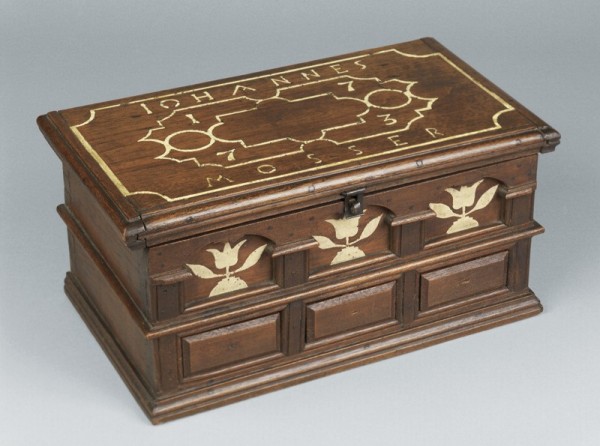
Miniature chest, made for Johannes Mosser, Lancaster County, Pennsylvania, 1773. Walnut and sulfur inlay with tulip poplar; iron. H. 7 1/4", W. 14 3/4", D. 8 5/8". (Courtesy, Winterthur Museum; photo, Laszlo Bodo.)
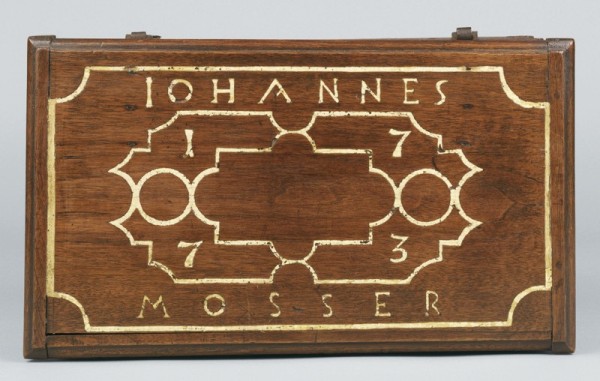
Lid of the miniature chest illustrated in fig. 1.
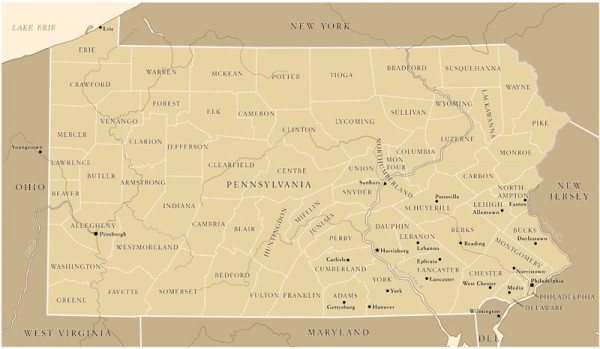
Map of Pennsylvania. (Courtesy, Winterthur Museum.)
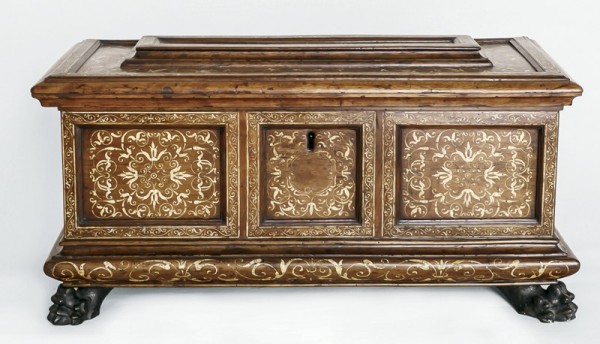
Chest, Bologna, Italy, ca. 1550. Walnut and probable orpiment inlay. H. 16 1/8", W. 32 1/4", D. 14 1/2". (Courtesy, Museum Angewandte Kunst, Frankfurt am Main; photo, Ute Kunze.)
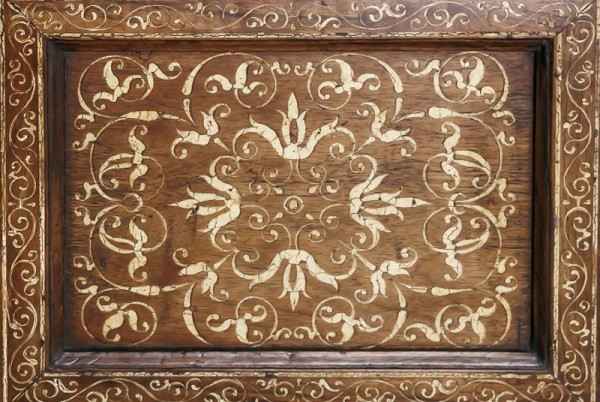
Detail of the inlay on the front of the chest illustrated in fig. 4.
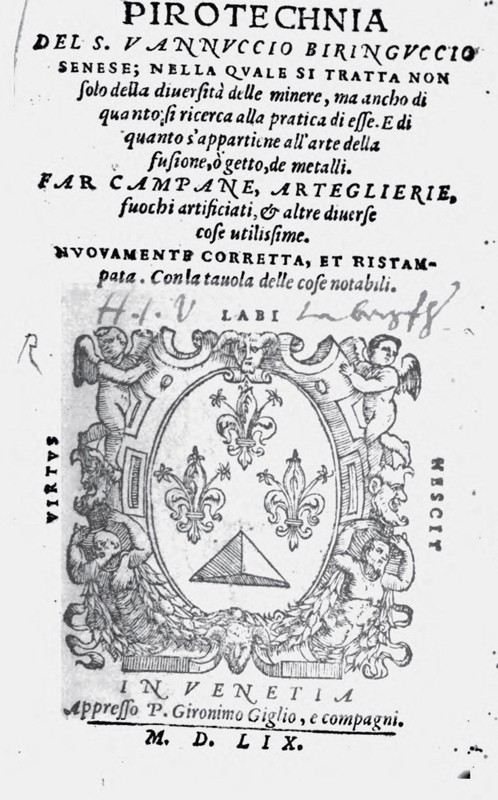
Title page of De la pirotechnia, written by Vannoccio Biringuccio, 4th edition, printed by P. Gironimo Giglio, Venice, Italy, 1559. (Courtesy, Bayerische Staatsbibliothek, Munich.)
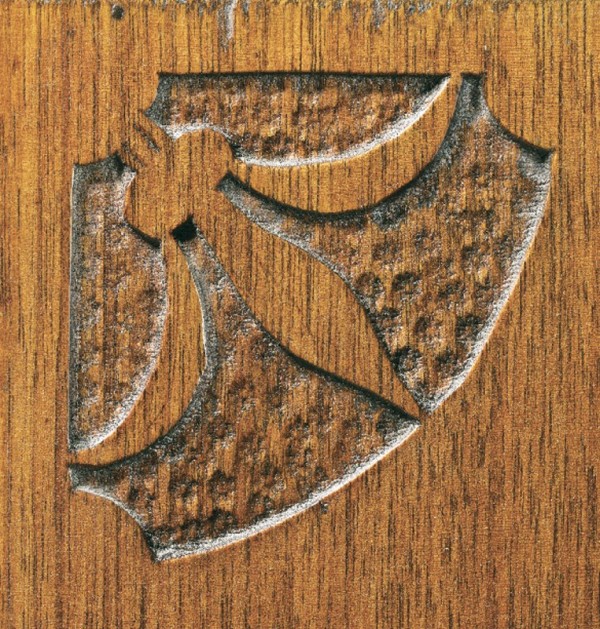
Detail of a relief carved fleur-de-lis on the schrank illustrated in fig. 38. (Photo, Gavin Ashworth.)
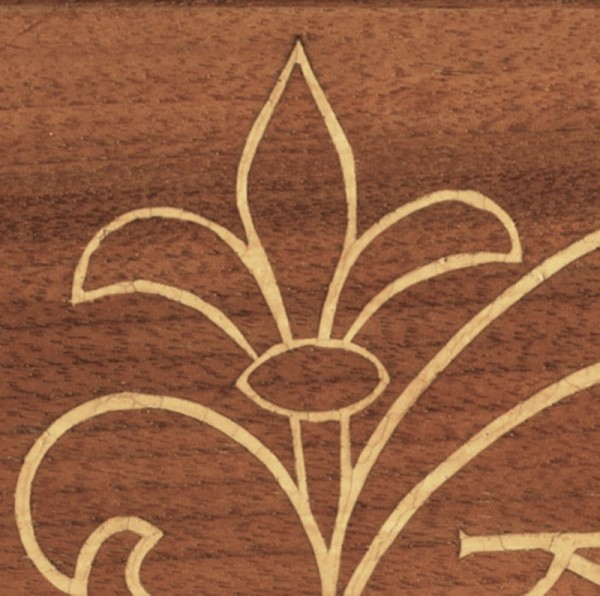
Detail of a sulfur-inlaid fleur-de-lis on the schrank illustrated in fig. 27. (Photo, Gavin Ashworth.)
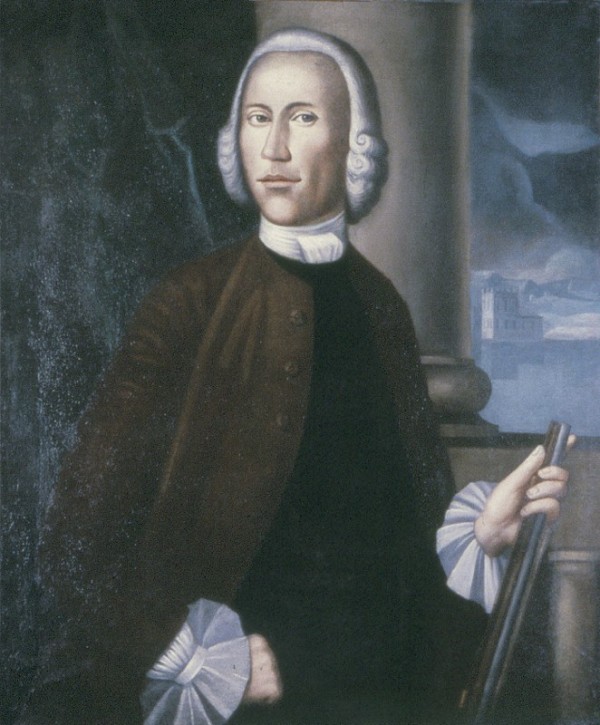
Portrait of William Henry, attributed to Benjamin West, Lancaster, Pennsylvania, ca. 1754. Oil on canvas. 36 3/4" x 30 1/2". (Courtesy, Philadelphia History Museum at the Atwater Kent, Historical Society of Pennsylvania Collection.)
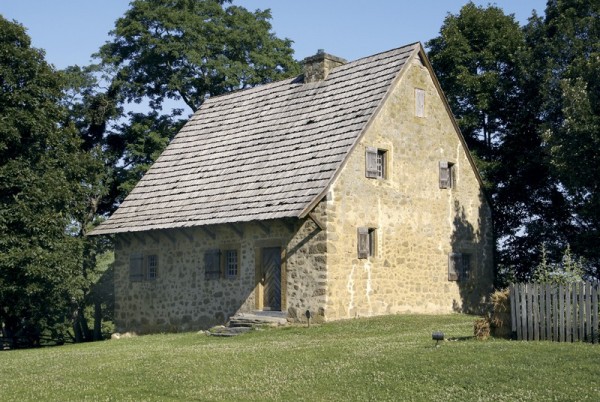
House of Christian Herr, West Lampeter Township, Lancaster County, Pennsylvania, 1719. (Courtesy, 1719 Hans Herr House & Museum; photo, Winterthur Museum, Laszlo Bodo.) The stone lintel above the door is inscribed “17 CH HR 19.”
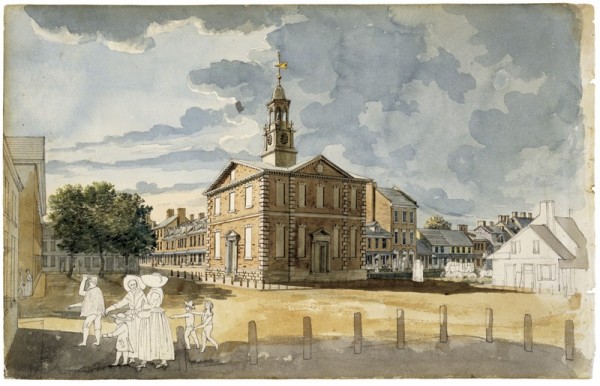
Benjamin Henry Latrobe, view of the Lancaster County Courthouse (built 1787), Lancaster, Pennsylvania, ca. 1801. Watercolor, pencil, pen and ink on laid paper. 8" x 12 3/4". (Courtesy, Maryland Historical Society, 1960.108.1.8.8.)

Tall clock, made for Andreas and Catharina Beierle, probably Lancaster, Lancaster County, Pennsylvania, 1745. Black walnut with tulip poplar. H. 91 1/4", W. 21 3/4", D. 12 1/4". (Private collection; photo, Winterthur Museum, Laszlo Bodo.) The base molding is replaced and the movement is not original to the case.
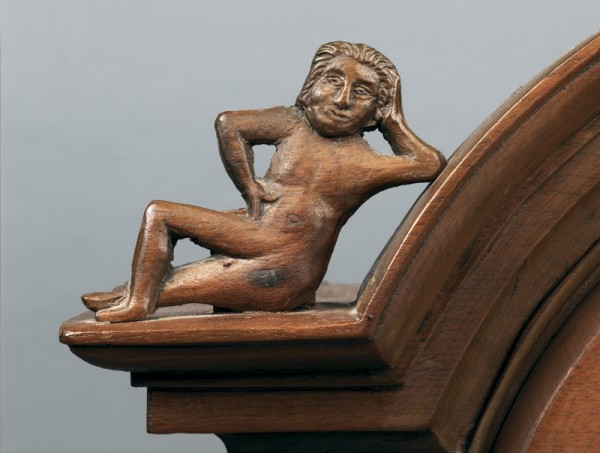
Detail of the carving on the tall clock illustrated in fig. 12.

Pendulum door of the clock illustrated in fig. 12.
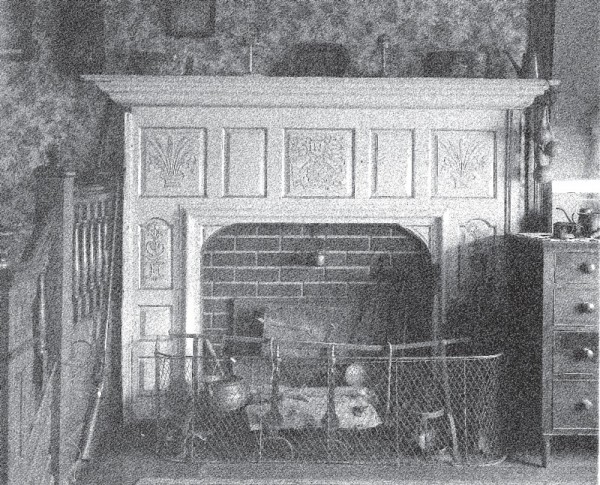
Mantel, probably Lancaster, Lancaster County, Pennsylvania, 1746. (Whereabouts unknown; photo, Raymond J. Brunner.) This photograph was taken in the shop of antiques dealer Hattie Brunner in Reinholds, Lancaster County.
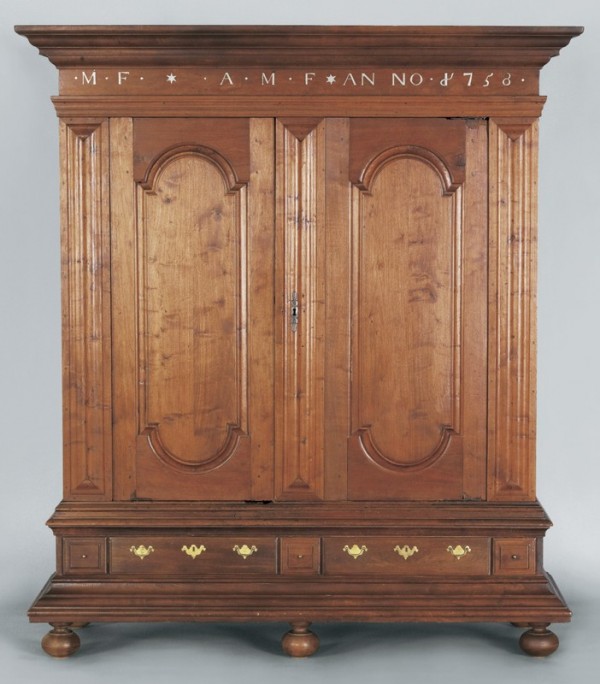
Schrank, probably made for Michael and Anna Margaretha Fordney, Lancaster, Lancaster County, Pennsylvania, 1758. Walnut and pewter inlay with pine and tulip poplar; brass, iron. H. 84", W. 78", D. 21 3/4". (Courtesy, Clint and Cindy McCauley; photo, Pook & Pook.) The feet are a later addition.
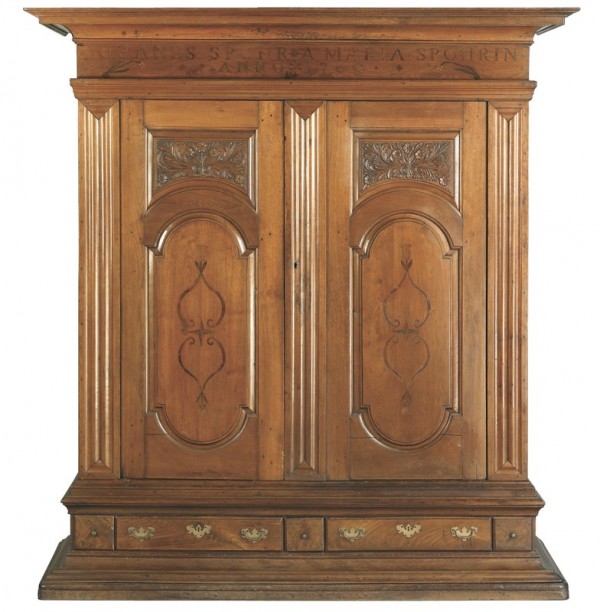
Schrank, made for Johannes and Anna Maria Spohr, Lancaster, Lancaster County, Pennsylvania, 1760. Walnut and mixed-wood inlay with tulip poplar; brass. H. 85", W. 71 1/2", D. 26". (Courtesy, Philadelphia Museum of Art; photo, Pook & Pook.)
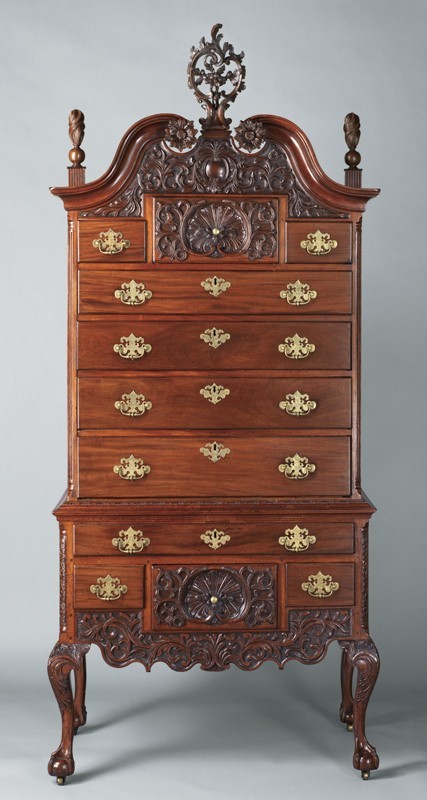
High chest, made for Matthias Slough, Lancaster, Lancaster County, Pennsylvania, 1770–1785. Mahogany with tulip poplar; brass. H. 96", W. 42", D. 24". (Courtesy, LancasterHistory.org, Heritage Center Collection, bequest of the estate of George J. Finney; photo, Winterthur Museum, Laszlo Bodo.)
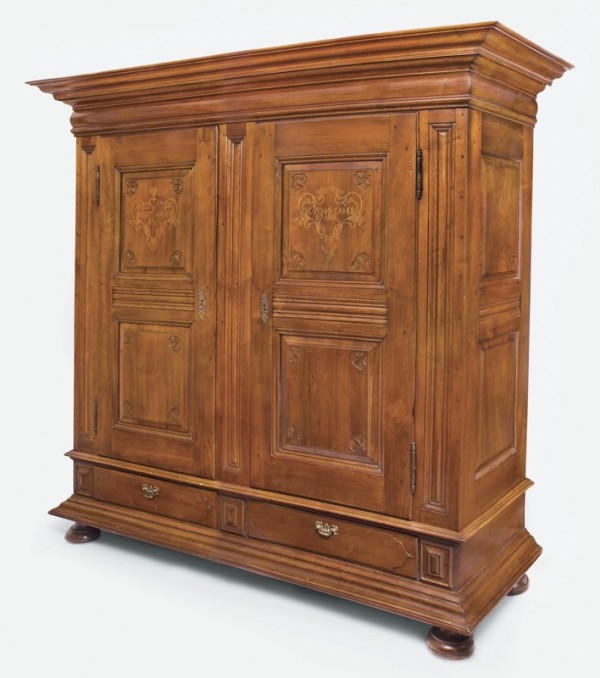
Schrank, made for Christian and Veronica Herr, Lancaster County, Pennsylvania, 1763. Walnut and sulfur inlay with tulip poplar and oak; brass, iron. H. 86", W. 84 1/2", D. 30 1/4". (Private collection; photo, Gavin Ashworth.)
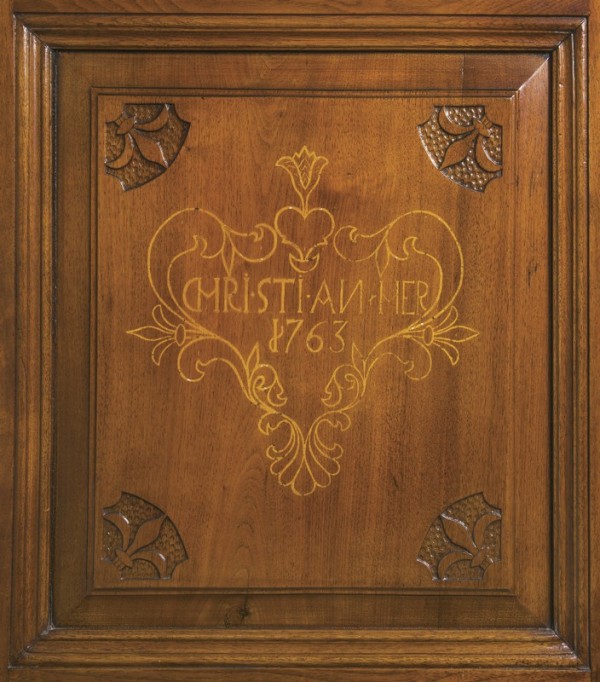
Detail of the sulfur inlay on the schrank illustrated in fig. 19. (Photo, Gavin Ashworth.)

Detail of the sulfur inlay on the schrank illustrated in fig. 19. (Photo, Gavin Ashworth.)
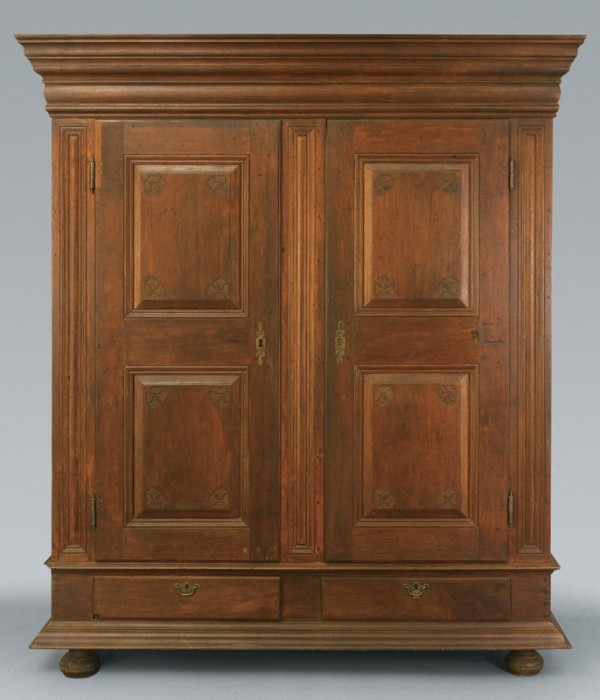
Schrank, Lancaster County, Pennsylvania, ca. 1765. Walnut; brass, iron. H. 85 1/2", W. 71 1/2", D. 26". (Private collection; photo, copyright 1995 Christie’s Limited.)
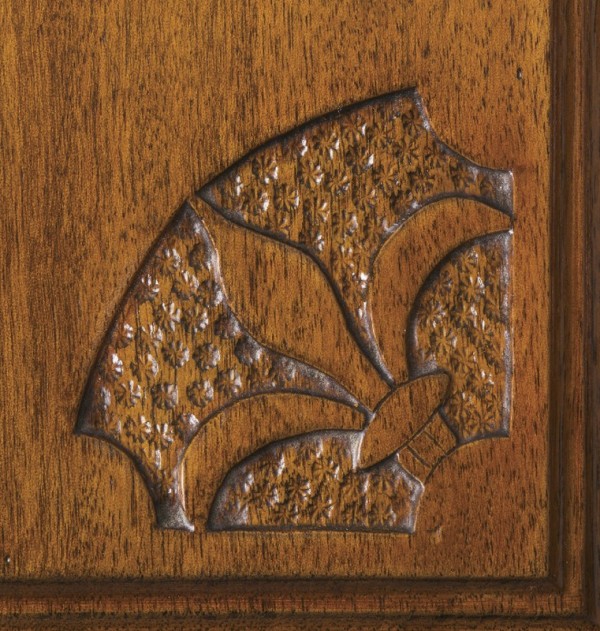
Detail of the carved fleur-de-lis on the schrank illustrated in fig. 19. (Photo, Gavin Ashworth.)

Detail of the carving on the door of a building in Hildesheim, Germany, ca. 1730. (Photo, Lisa Minardi.)
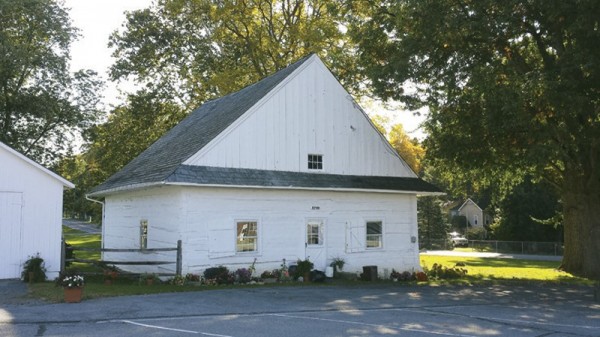
Landisville Mennonite Meetinghouse, East Hempfield Township, Lancaster County, Pennsylvania, ca. 1740. (Photo, Lisa Minardi.)
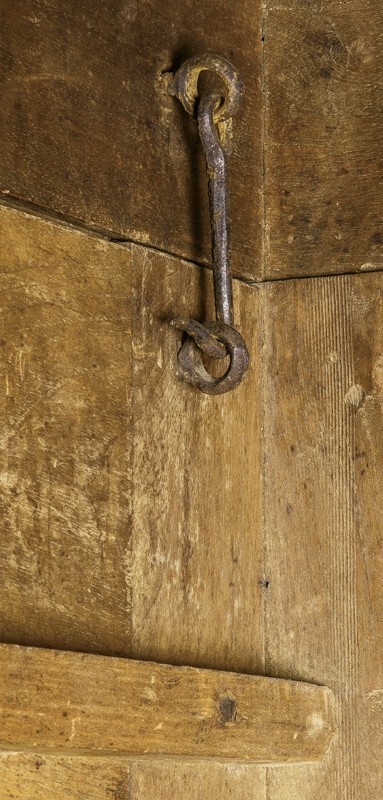
Detail of a wrought iron hook inside the schrank illustrated in fig. 34. (Photo, Winterthur Museum, James Schneck.)
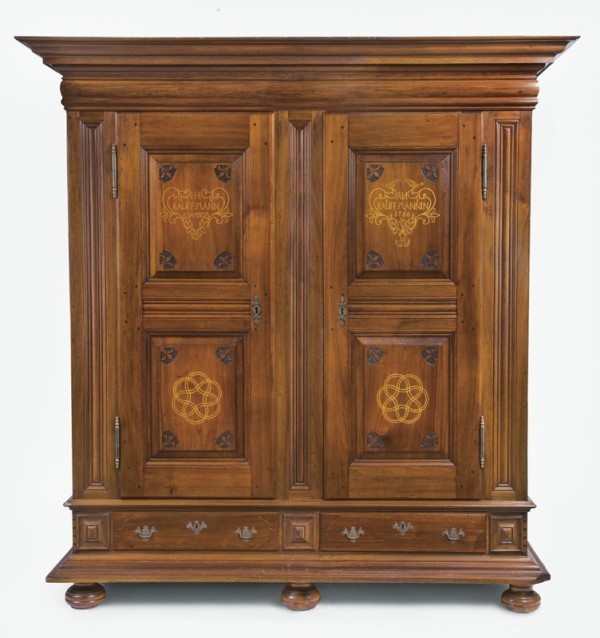
Schrank, made for Johannes and Anna Kauffmann, Lancaster County, Pennsylvania, 1766. Walnut and sulfur inlay with tulip poplar and oak; brass, iron. H. 89", W. 84", D. 30". (Courtesy, Pennsylvania Historical and Museum Commission, State Museum of Pennsylvania; photo, Gavin Ashworth.)
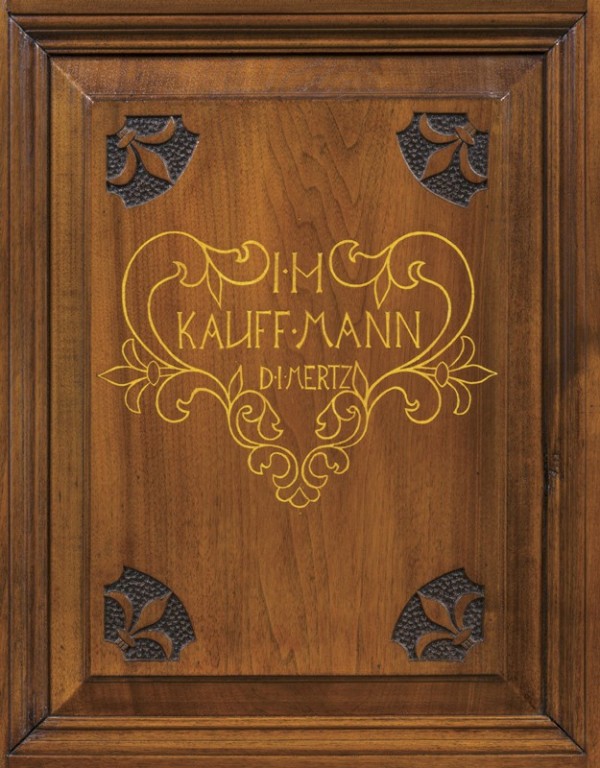
Detail of the inlay on the schrank illustrated in fig. 27. (Photo, Gavin Ashworth.)
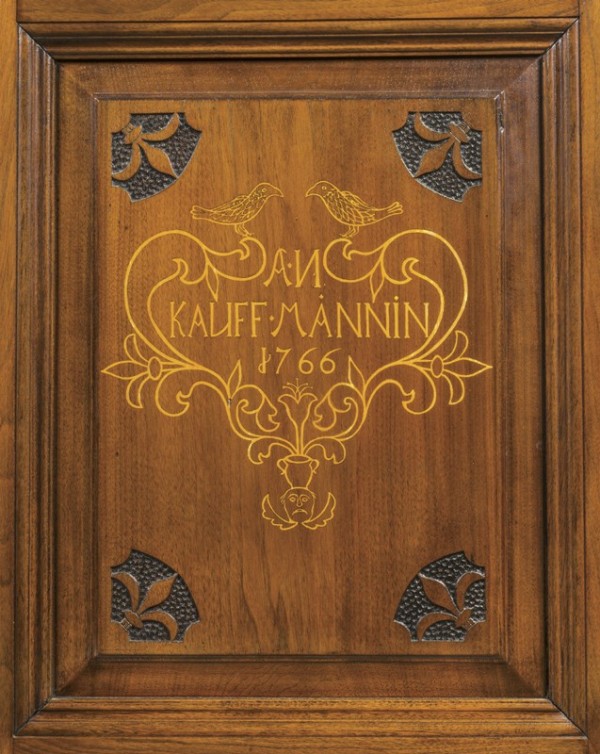
Detail of the inlay on the schrank illustrated in fig. 27. (Photo, Gavin Ashworth.)
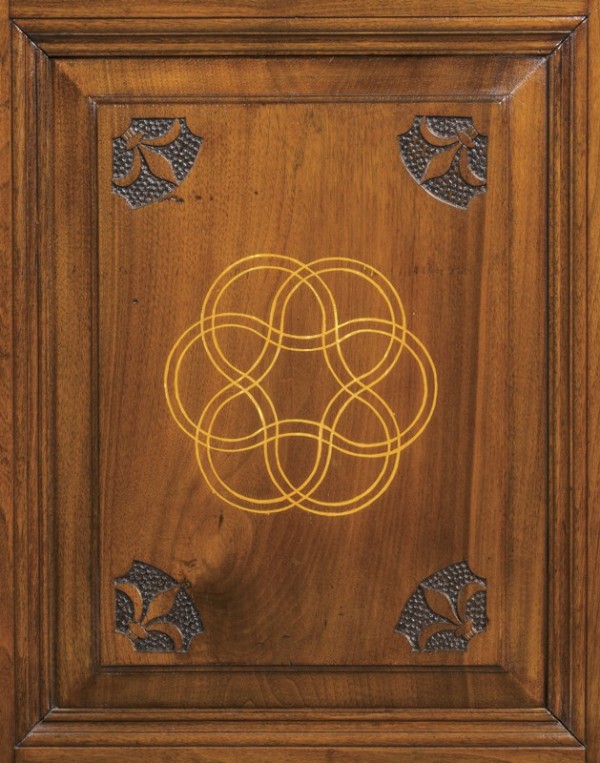
Detail of the inlay on the schrank illustrated in fig. 27. (Photo, Gavin Ashworth.)
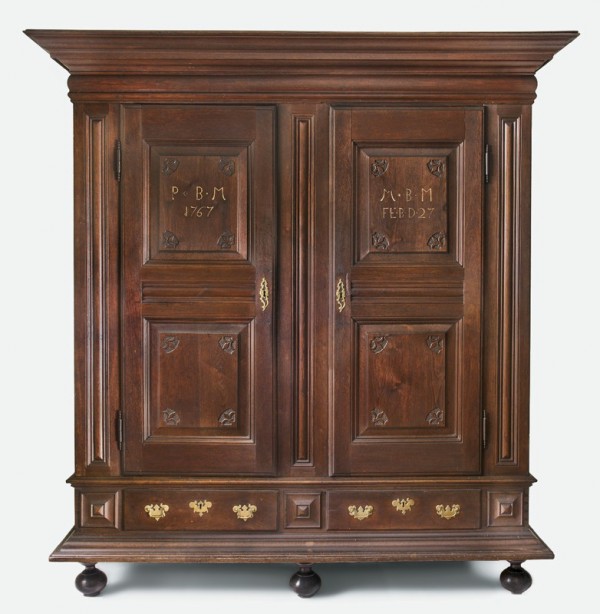
Schrank, probably made for Peter and Maria Bachmann, Lancaster County, Pennsylvania, 1767. Walnut and sulfur inlay with tulip poplar and oak; brass, iron. H. 89", W. 84 1/4", D. 30". (Private collection; photo, Gavin Ashworth.) The feet are replaced.
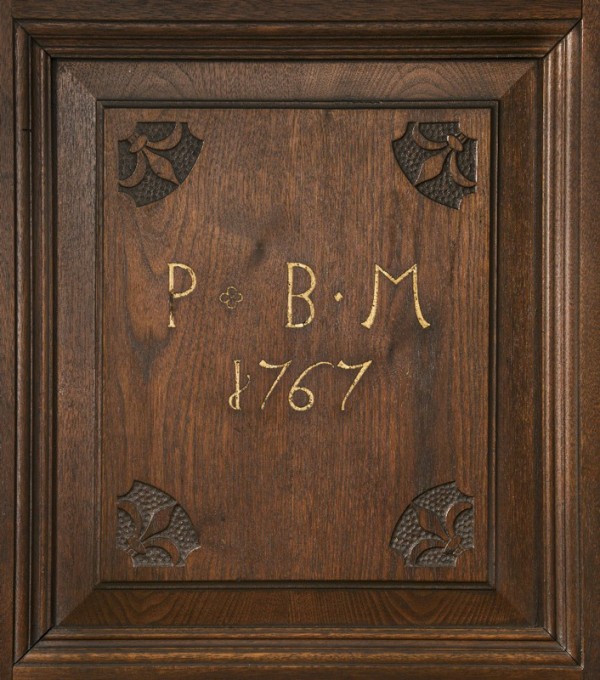
Detail of the inlay on the schrank illustrated in fig. 31. (Photo, Gavin Ashworth.)
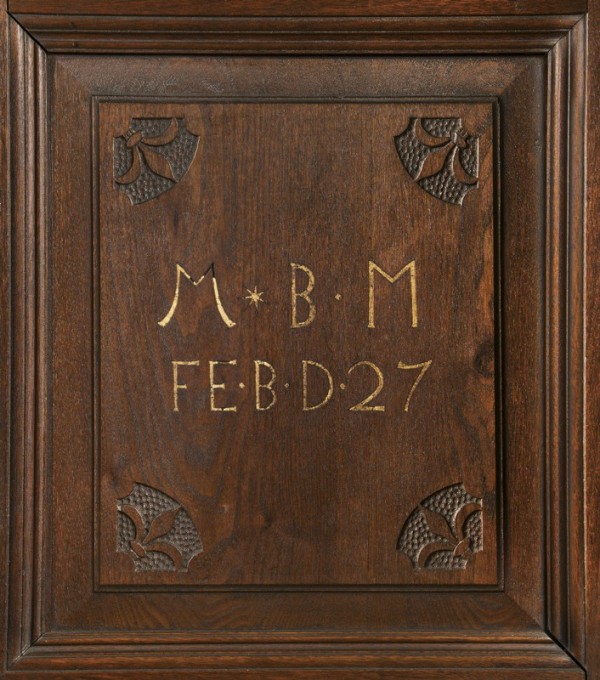
Detail of the inlay on the schrank illustrated in fig. 31. (Photo, Gavin Ashworth.)
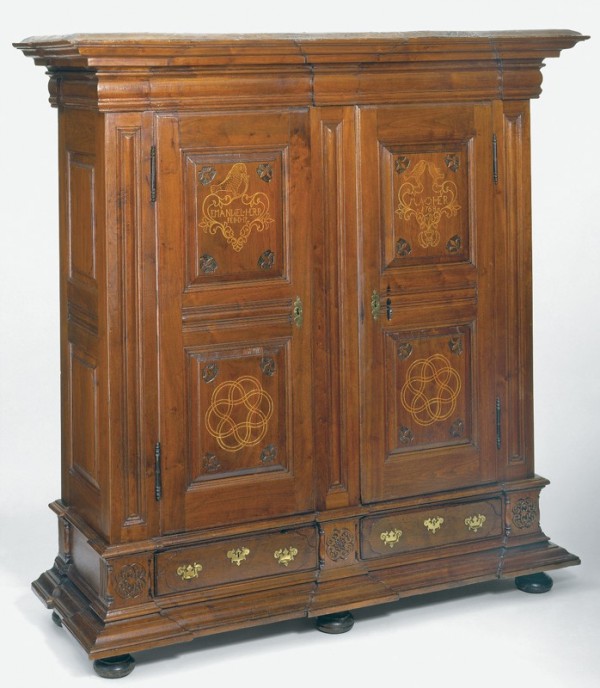
Schrank, made for Emanuel and Mary Herr, Lancaster County, Pennsylvania, 1768. Walnut and sulfur inlay with tulip poplar. H. 89 1/2", W. 85 3/4", D. 30 1/2". (Courtesy, Winterthur Museum; photo, Laszlo Bodo.)
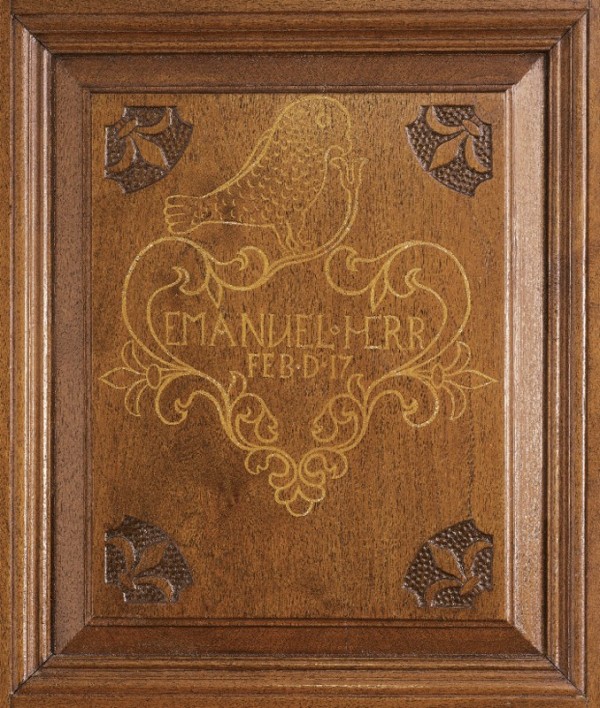
Detail of the inlay on the schrank illustrated in fig. 34. (Photo, Winterthur Museum, James Schneck.)

Detail of the inlay on the schrank illustrated in fig. 34. (Photo, Winterthur Museum, James Schneck.)
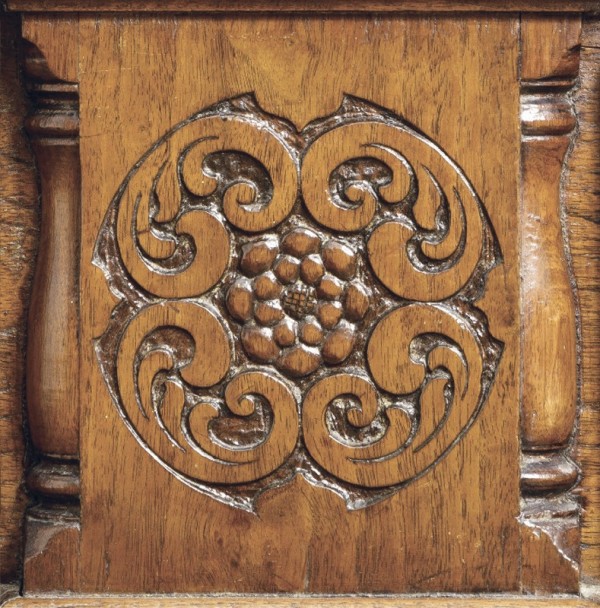
Detail of the carving at the base of the schrank illustrated in fig. 34. (Photo, Winterthur Museum, James Schneck.)
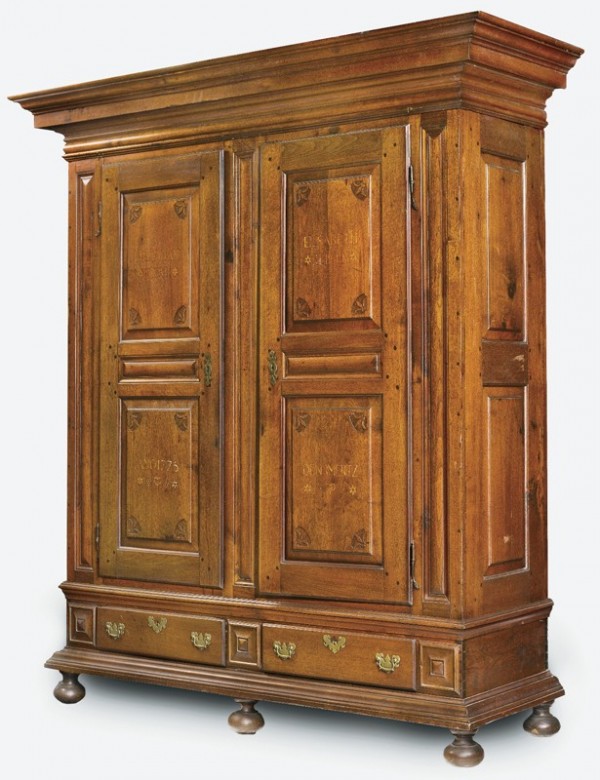
Schrank, made for Abraham and Elisabeth Reist, Lancaster County, Pennsylvania, 1775. Walnut and sulfur inlay with pine; iron, brass. H. 91", W. 86", D. 31". (Courtesy, LancasterHistory.org, Heritage Center Collection, acquired through the generosity of the James Hale Steinman Foundation; photo, Gavin Ashworth.)
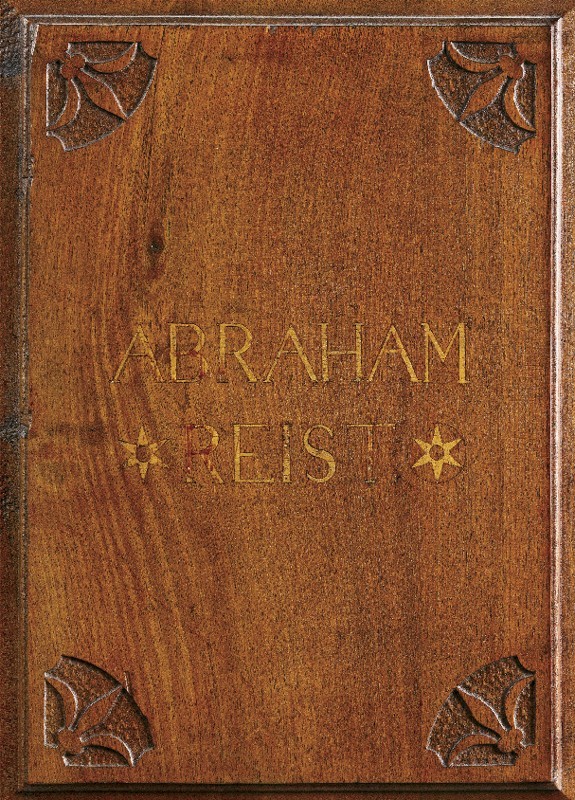
Detail of the inlay on the schrank illustrated in fig. 38. (Photo, Gavin Ashworth.)

Detail of the inlay on the schrank illustrated in fig. 38. (Photo, Gavin Ashworth.)
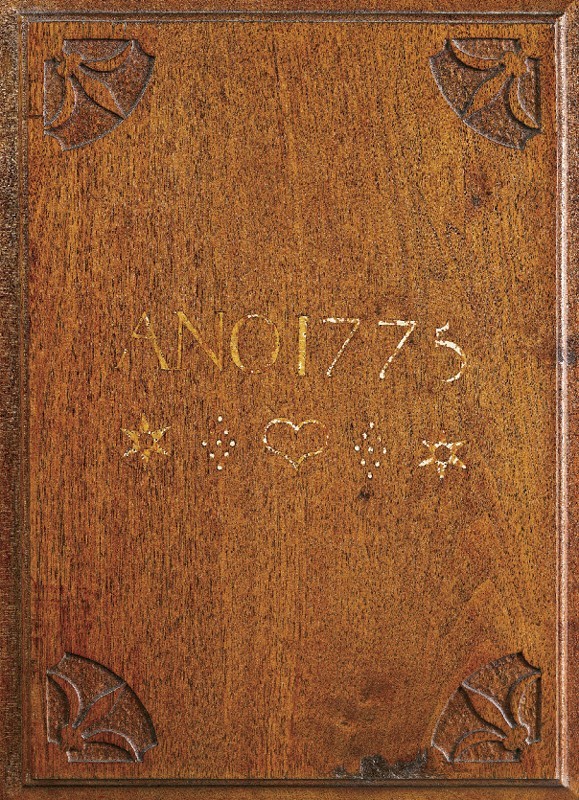
Detail of the inlay on the schrank illustrated in fig. 38. (Photo, Gavin Ashworth.)
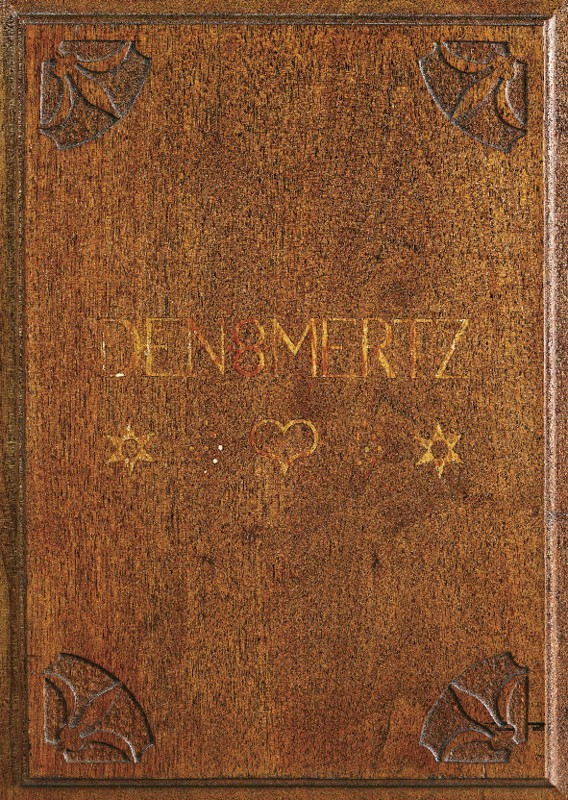
Detail of the inlay on the schrank illustrated in fig. 38. (Photo, Gavin Ashworth.)
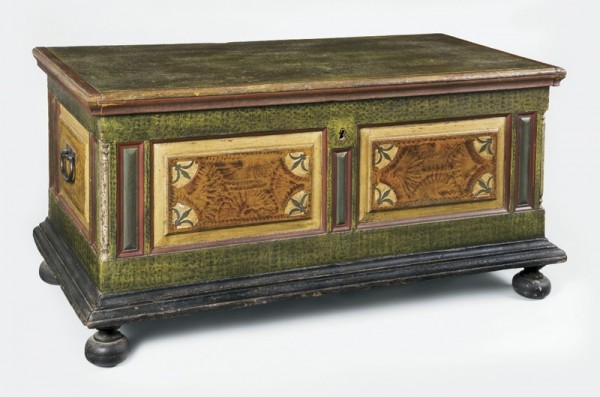
Chest, Lancaster County, Pennsylvania, ca. 1765. White pine; paint; iron. H. 25 1/2", W. 52", D. 24 1/2". (Courtesy, Clarke Hess; photo, Gavin Ashworth.) The paint is restored.

Detail of the chest illustrated in fig. 43. (Photo, Gavin Ashworth.)
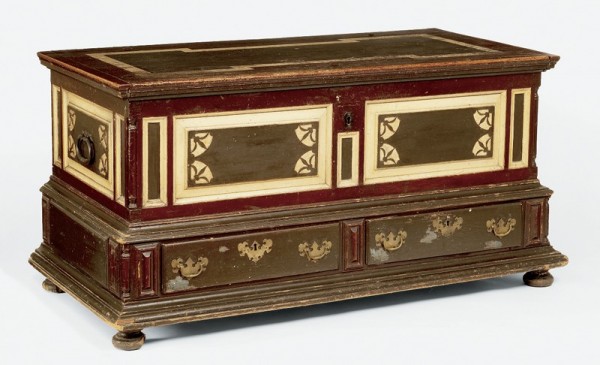
Chest, Lancaster County, Pennsylvania, ca. 1765. White pine; paint; brass, iron. H. 26 1/4", W. 53 1/4", D. 27 1/8". (Private collection; photo, David Bohl.) The paint is restored.
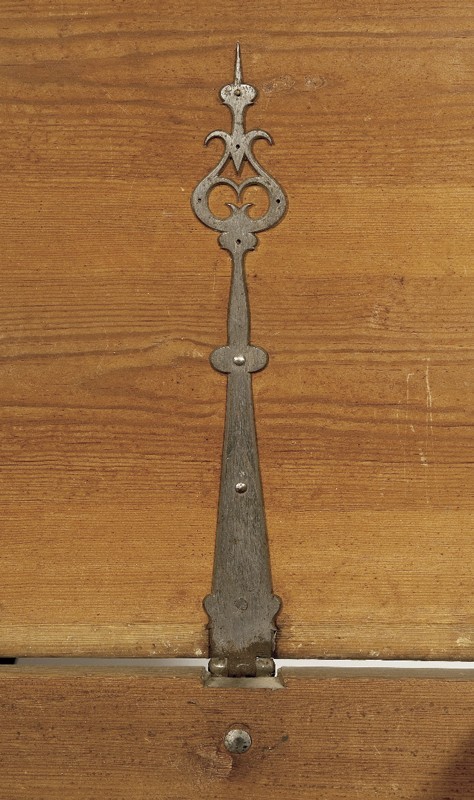
Detail of a hinge inside the chest illustrated in fig. 45.
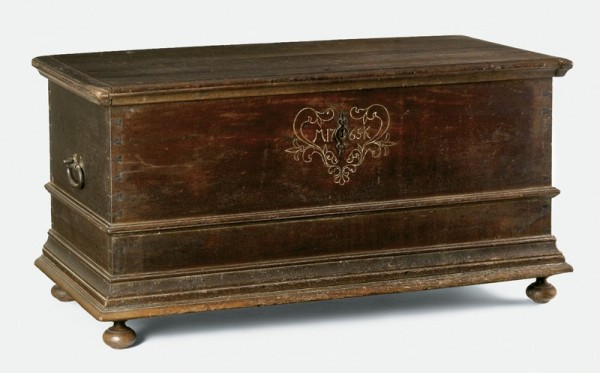
Chest, probably made for Michael Kauffman, Lancaster County, Pennsylvania, 1765. Walnut and sulfur inlay; iron. H. 25 5/8", W. 51 1/2", D. 24 3/4". (Courtesy, Rocky Hill Collection; photo, Gavin Ashworth.) The feet are replaced.
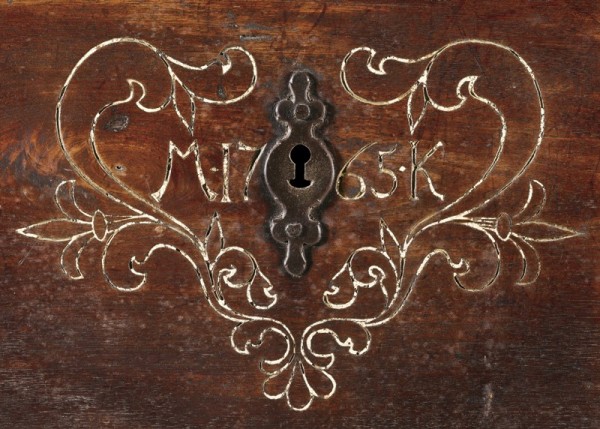
Detail of the inlay on the chest illustrated in fig. 47. (Photo, Gavin Ashworth.)
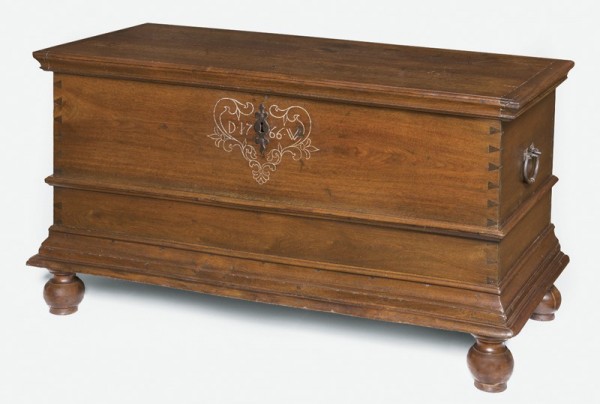
Chest, possibly made for Daniel Wolf, Lancaster County, Pennsylvania, 1766. Walnut and sulfur inlay with white pine; iron. H. 27 1/4", W. 52", D. 24". (Private collection; photo, Gavin Ashworth.) The feet are replaced.

Detail of the inlay on the chest illustrated in fig. 49. (Photo, Gavin Ashworth.)
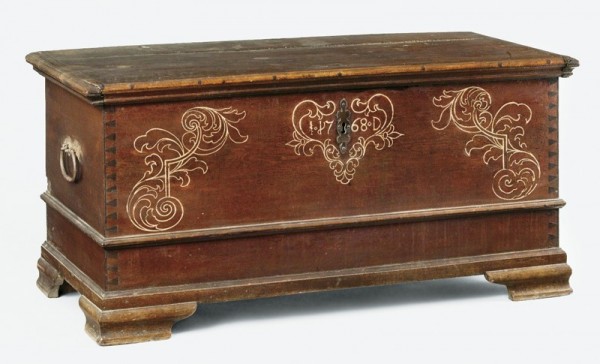
Chest, made for “I D,” Lancaster County, Pennsylvania, 1768. Walnut and sulfur inlay; iron. H. 25 1/8", W. 51 7/8", D. 24 7/8". (Private collection; photo, Gavin Ashworth.)
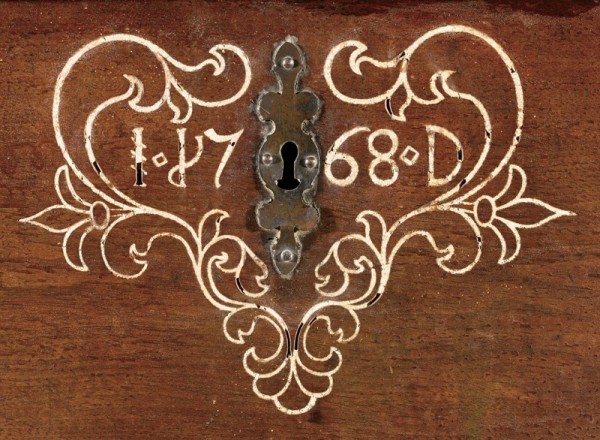
Detail of the inlay on the chest illustrated in fig. 51. (Photo, Gavin Ashworth.)
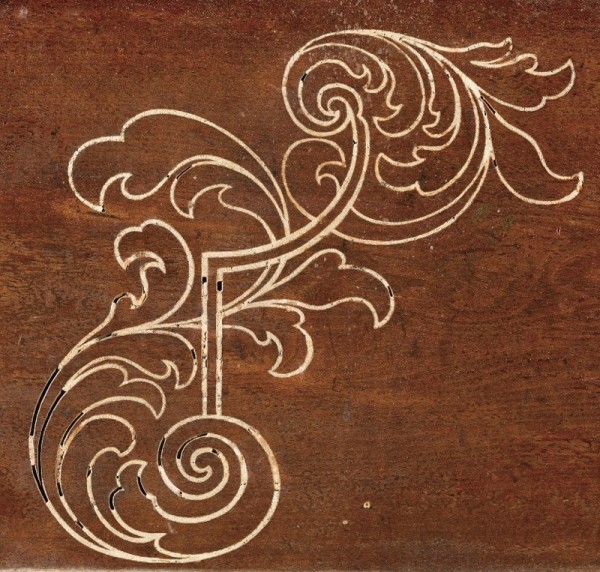
Detail of the inlay on the chest illustrated in fig. 51. (Photo, Gavin Ashworth.)

Detail of a foot on the chest illustrated in fig. 51. (Photo, Gavin Ashworth.)

Tall clock, probably made for Frederick Stone, movement signed by Rudolph Stoner, Lancaster, Lancaster County, Pennsylvania, 1762. Cherry, mixed-wood inlay, and pewter inlay with tulip poplar. H. 101 1/2", W. 21", D. 11 1/2". (Chipstone Foundation; photo, Gavin Ashworth.) The feet are replaced and a board has been added between the cornice and sarcophagus.
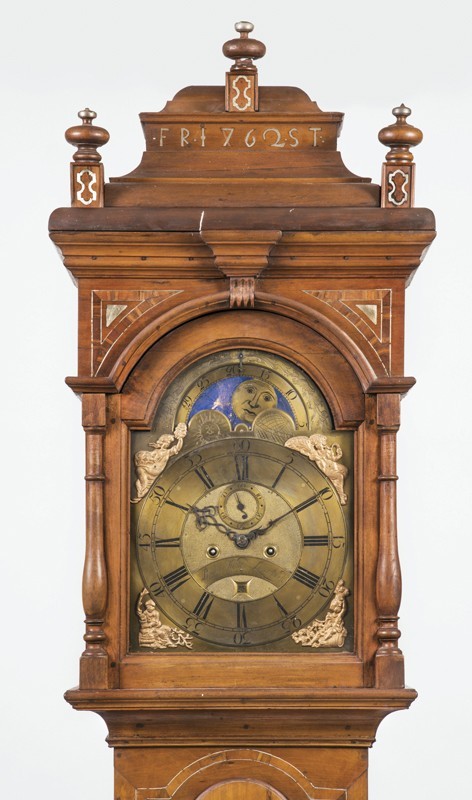
Hood of the clock illustrated in fig. 55. (Photo, Gavin Ashworth.)
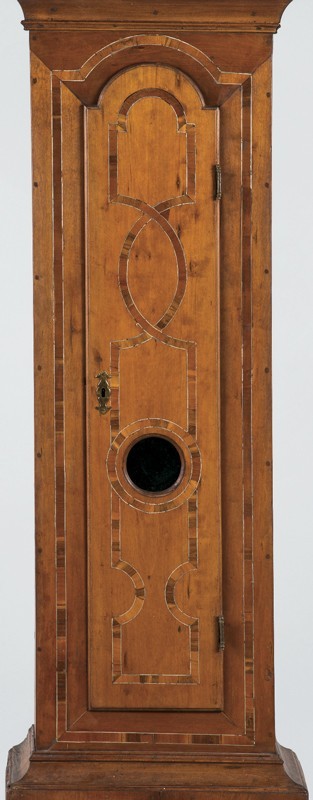
Pendulum door of the clock illustrated in fig. 55. (Photo, Gavin Ashworth.)
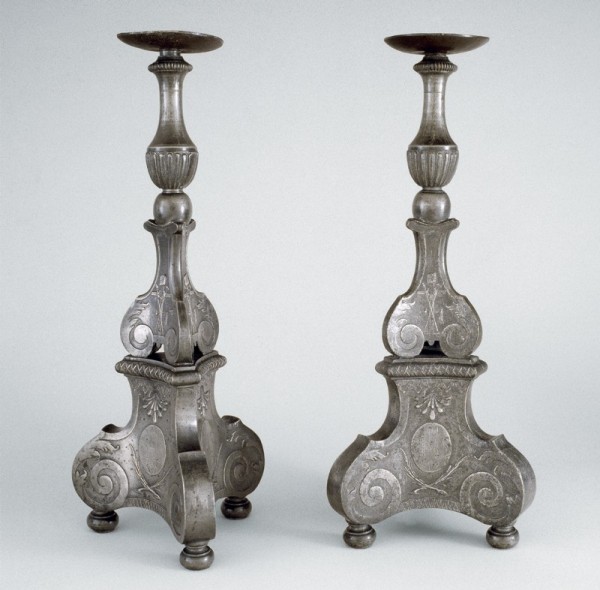
Pair of candlesticks, marked by Johann Christoph Heyne, Lancaster, Lancaster County, Pennsylvania, 1755–80. Pewter. H. 22, W. 7 3/4", D. 8 5/8". (Courtesy, Winterthur Museum; photo, Gavin Ashworth.)

Tall clock, made for the Eaby family, movement signed by Christian Forrer, Lampeter, Lancaster County, Pennsylvania, ca. 1765. Walnut and mixed-wood inlay with walnut; brass. H. 92 1/2", W. 19 3/4", D. 13". (Courtesy, Carolyn C. Wenger; photo, Gavin Ashworth.) The feet are replaced; the broken scroll pediment is a later addition.
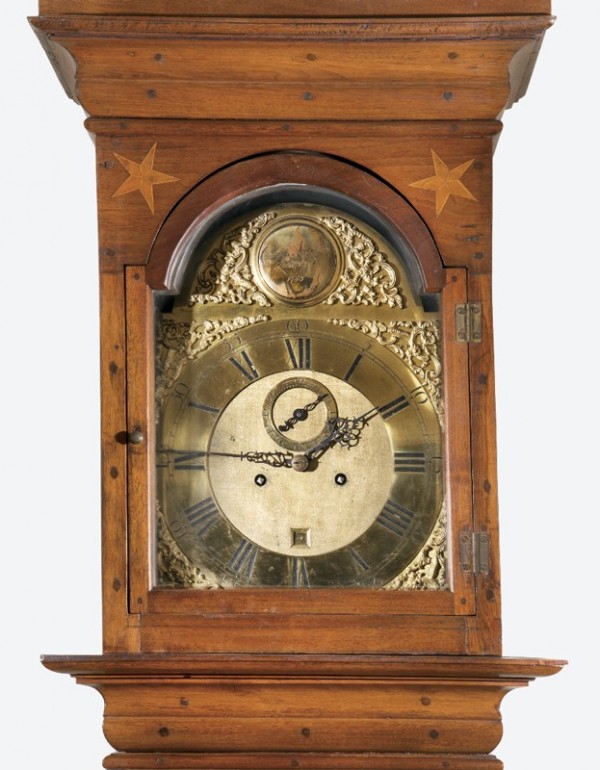
Hood of the clock illustrated in fig. 59. (Photo, Gavin Ashworth.)

Tall clock, made for Peter Ferree, movement signed by Rudolph Stoner, Lancaster, Lancaster County, Pennsylvania, 1765. Cherry and sulfur inlay with tulip poplar. H. 107 1/4", W. 21", D. 11 1/2". (Courtesy, Rocky Hill Collection; photo, Winterthur Museum, Laszlo Bodo.)
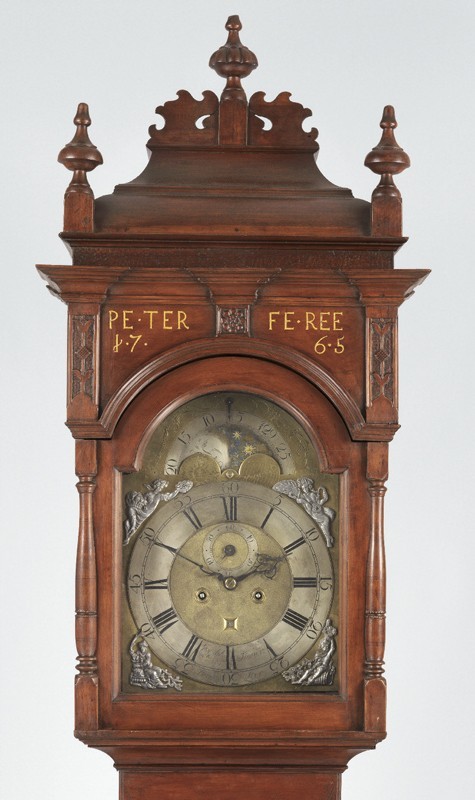
Hood of the clock illustrated in fig. 61. (Photo, Laszlo Bodo.)

Tall clock, made for Christian Schwar, movement attributed to George Hoff, Lancaster, Lancaster County, Pennsylvania, 1766. Walnut and sulfur inlay with tulip poplar. H. 107", W. 19 1/4", D. 11". (Courtesy, Rock Ford Plantation, bequest of John J. Snyder Jr.; photo, Gavin Ashworth.) The feet, finials, and valance are replaced.
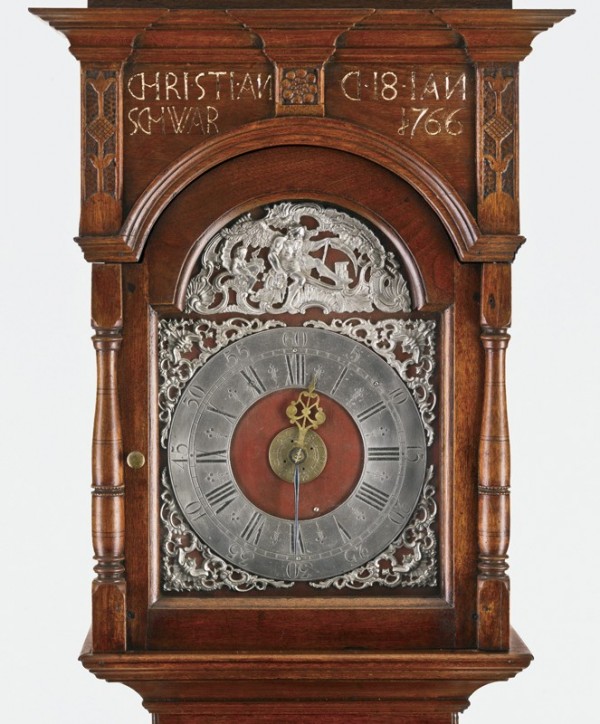
Hood of the clock illustrated in fig. 63. (Photo, Gavin Ashworth.)

Tall clock, made for Daniel Besore, movement signed by George Hoff, Lancaster, Lancaster County, Pennsylvania, 1768. Cherry, red mulberry, and walnut with pewter and mixed-wood inlay and tulip poplar. H. 105", W. 19 3/4", D. 11". (Courtesy, Dietrich American Foundation.) The finials and valance are replaced.

Hood of the clock illustrated in fig. 65. (Photo, Dietrich American Foundation.)
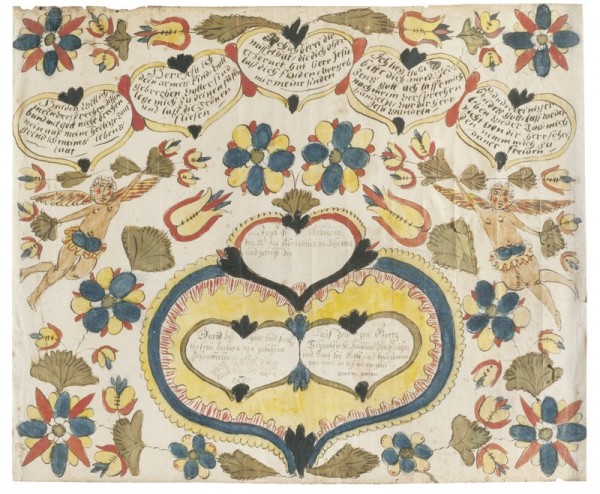
Birth and baptismal certificate for Jacob Boshaar, attributed to Joseph Lochbaum, Washington Township, Franklin County, Pennsylvania, ca. 1805. Watercolor and ink on laid paper. 13" x 15 1/2". (Courtesy, Philadelphia Museum of Art, promised gift of Joan and Victor Johnson; photo, Graydon Wood.)

Tall clock, movement attributed to Samuel Meyli, Lancaster County, Pennsylvania, ca. 1770. Walnut and sulfur inlay with tulip poplar; brass. H. 102", W. 20 1/2, D. 11 1/2". (Private Collection; photo, Gavin Ashworth.) The feet, finials and plinths, and valance are restored.
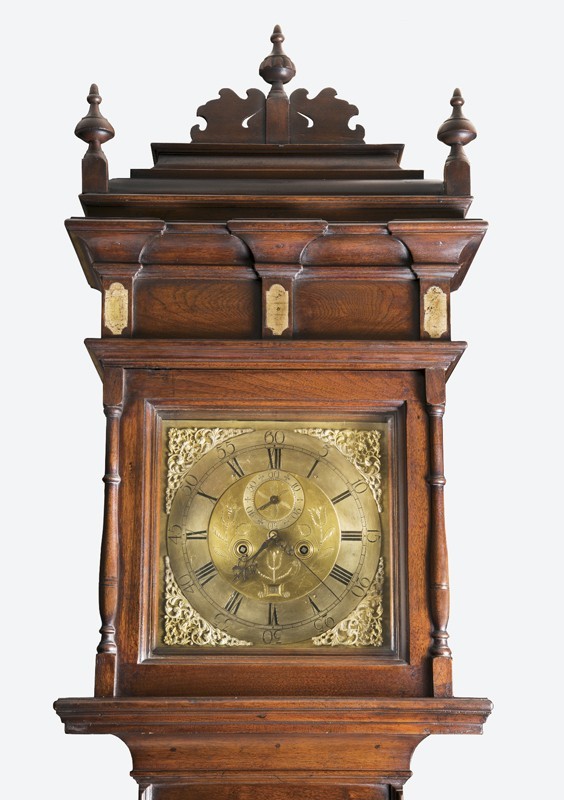
Hood of the clock illustrated in fig. 68. (Photo, Gavin Ashworth.)

Tall clock, movement signed by Benjamin Lamb of London, case made in Lancaster County, Pennsylvania, ca. 1765. Walnut with tulip poplar. H. 96 1/2", W. 22 1/8", D. 12 1/2". (Courtesy, Rock Ford Plantation, bequest of John J. Snyder Jr.; photo, Gavin Ashworth.)

Hood of the clock illustrated in fig. 70. (Photo, Gavin Ashworth.)
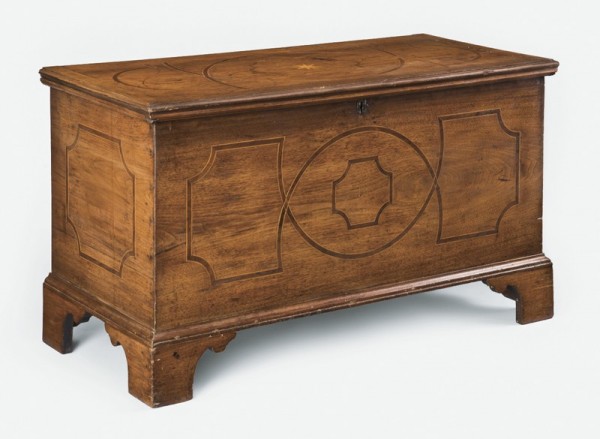
Chest, possibly made for Johannes Kilheffer, Lancaster County, Pennsylvania, ca. 1765. Walnut and mixed-wood inlay with white pine; iron, brass. H. 23", W. 42 1/2", D. 19 1/4". (Courtesy, Lancaster Mennonite Historical Society, bequest of John J. Snyder Jr.; photo, Gavin Ashworth.)
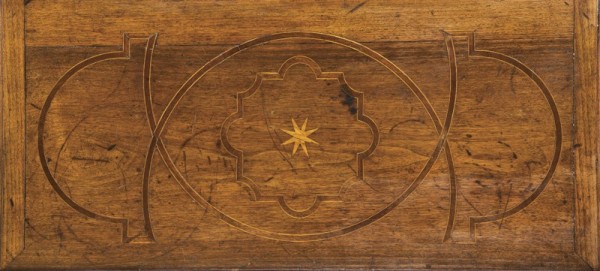
Lid of the chest illustrated in fig. 72. (Photo, Gavin Ashworth.)
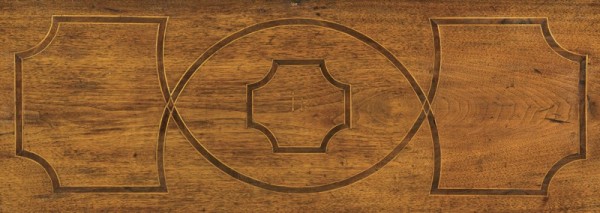
Detail of the façade of the chest illustrated in fig. 72. (Photo, Gavin Ashworth.)
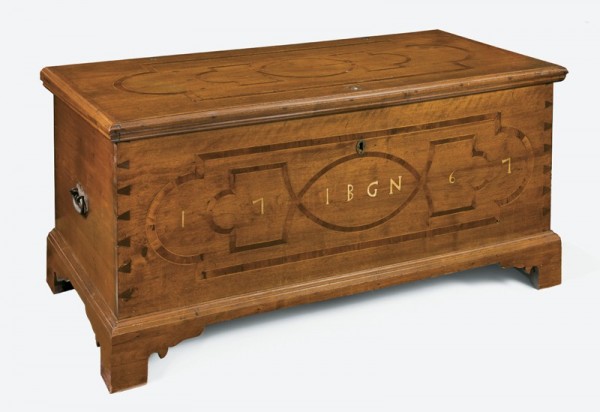
Chest, probably made for Jacob Gochnauer, Lancaster County, Pennsylvania, 1767. Walnut, mixed-wood inlay, and bone inlay; iron. H. 24 1/4", W. 50", D. 23 1/2". (Private collection; photo, Gavin Ashworth.)

Detail of the façade of the chest illustrated in fig. 75. (Photo, Gavin Ashworth.)
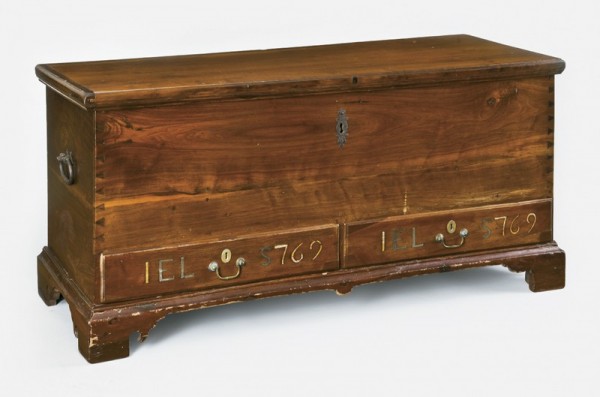
Chest, made for “EL S,” Pennsylvania, 1769. Walnut, pewter inlay, and sulfur inlay with pine and oak; iron, brass. H. 24 1/4", W. 53 3/4", D. 22 3/8". (Private collection; photo, Gavin Ashworth.)

Detail of a drawer from the chest illustrated in fig. 77. (Photo, Gavin Ashworth.)
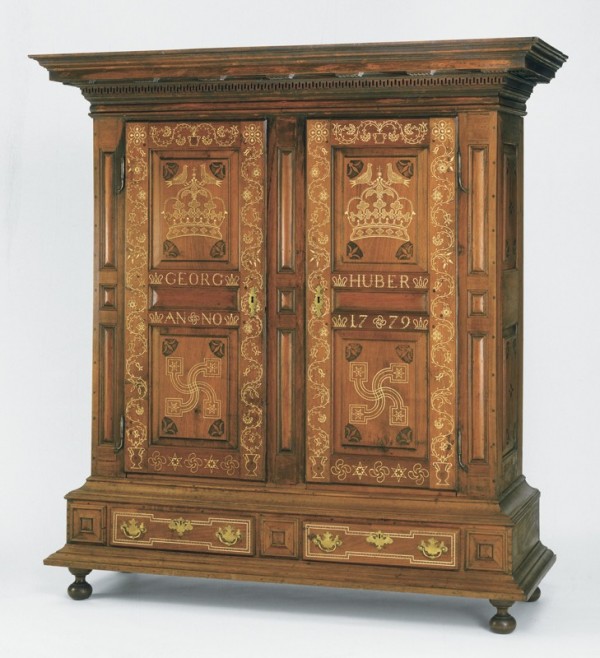
Schrank, made for Georg Huber, Lancaster County, Pennsylvania, 1779. Walnut and sulfur inlay with tulip poplar, pine, and oak; brass and iron. H. 83 1/8", W. 78", D. 27 1/2". (Courtesy, Philadelphia Museum of Art, 1957-30-1.) The feet are replaced.
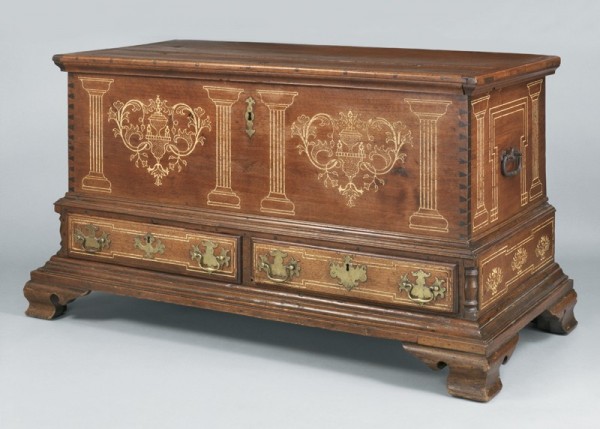
Chest, Lancaster County, Pennsylvania, 1783. Walnut and sulfur inlay with pine; brass, iron. H. 29 1/4", W. 54 1/2", D. 26 1/2". (Courtesy, National Museum of American History, Smithsonian Institution; photo, Winterthur Museum, Laszlo Bodo.) The feet are replaced.

End of the chest illustrated in fig. 80.

Till compartment of the chest illustrated in fig. 80.
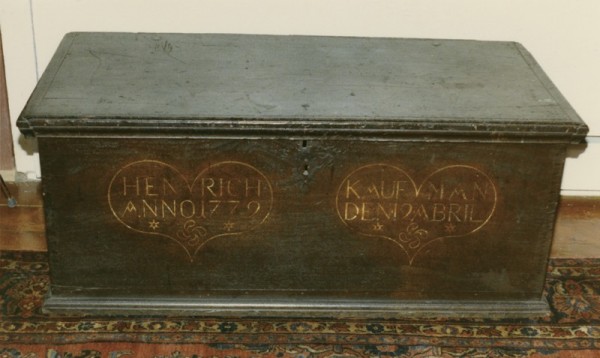
Chest, made for Henrich Kauffman, Lancaster County, Pennsylvania, 1779. Walnut and sulfur inlay. Dimensions unrecorded. (Photo, Steven F. Still Antiques.)
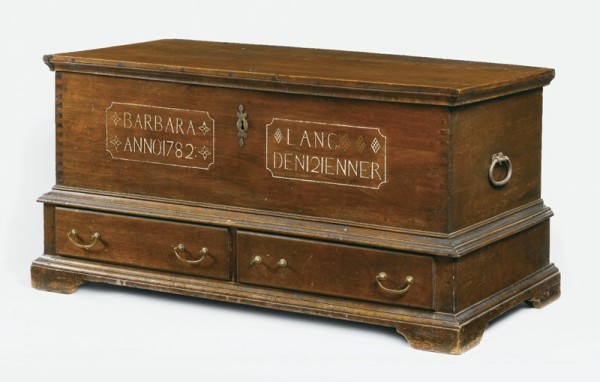
Chest, made for Barbara Lang, Manheim Township area, Lancaster County, Pennsylvania, 1782. Walnut and sulfur inlay with pine and tulip poplar; iron. H. 26 5/8", W. 52", D. 26 1/2". (Courtesy, Philadelphia Museum of Art, gift of Mr. and Mrs. Robert L. Raley, 1978-101-1; photo, Gavin Ashworth.)
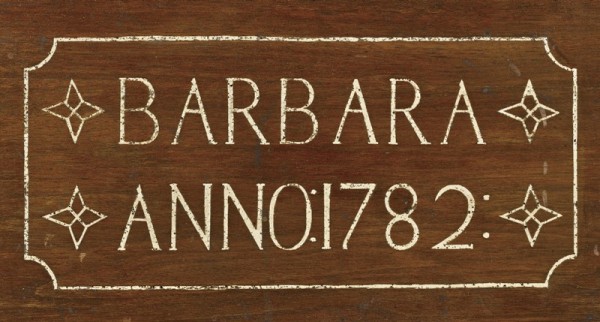
Detail of the inlay on the chest illustrated in fig. 84. (Photo, Gavin Ashworth.)

Detail of the inlay on the chest illustrated in fig. 84. (Photo, Gavin Ashworth.)
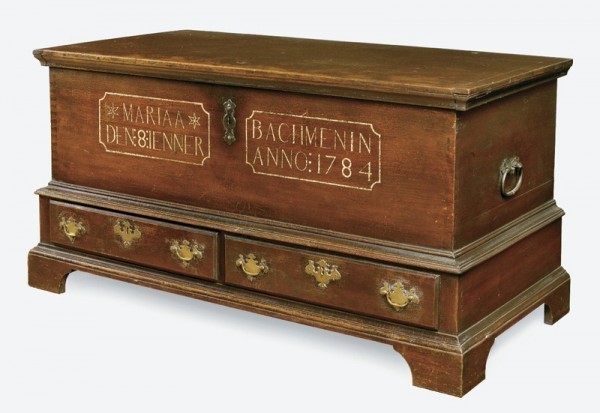
Chest, made for Maria Bachman, Manheim Township area, Lancaster County, Pennsylvania, 1784. Walnut and sulfur inlay with tulip poplar; iron, brass. H. 26 3/4", W. 52", D. 25 1/2". (Courtesy, Joan and Victor Johnson; photo, Gavin Ashworth.)
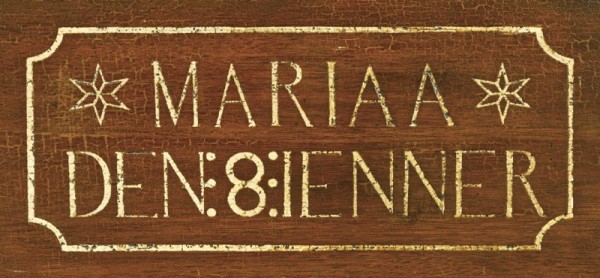
Detail of the inlay on the chest illustrated in fig. 87. (Photo, Gavin Ashworth.)
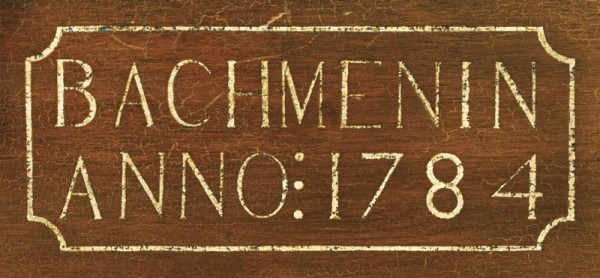
Detail of the inlay on the chest illustrated in fig. 87. (Photo, Gavin Ashworth.)
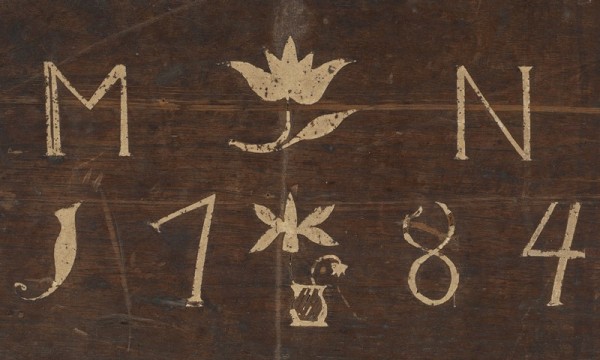
Detail of the inlay on a chest, Lancaster County, Pennsylvania, 1784. Walnut and sulfur inlay. (Courtesy, Winterthur Museum; photo, James Schneck.)
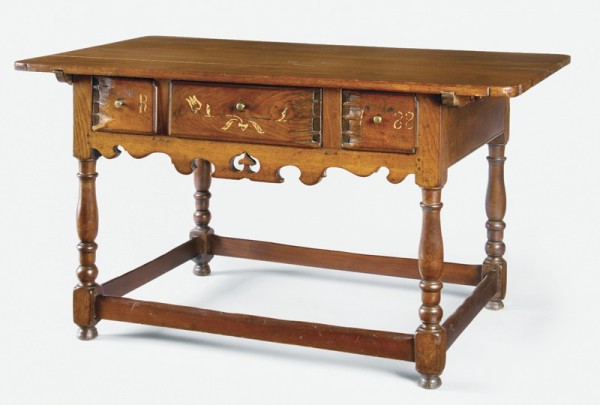
Table, made for “I R,” Lancaster County, Pennsylvania, 1788. Walnut and sulfur inlay with white pine; brass. H. 28 5/8", W. 52 3/4", D. 31". (Courtesy, Chester County Historical Society; photo, Gavin Ashworth.) The stretchers are replaced.
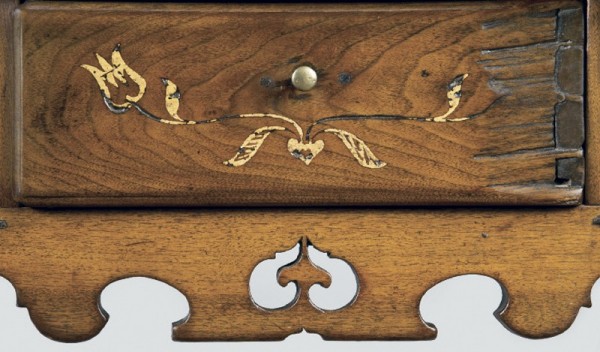
Detail of the inlay on the table illustrated in fig. 91. (Photo, Gavin Ashworth.)

Tall clock, movement by George Hoff, Lancaster County, Pennsylvania, 1790. Walnut and sulfur inlay with tulip poplar, pine, and oak. H. 89 1/2", W. 20 1/2", D. 16". (Courtesy, Joan and Victor Johnson; photo, Winterthur Museum, Laszlo Bodo.)
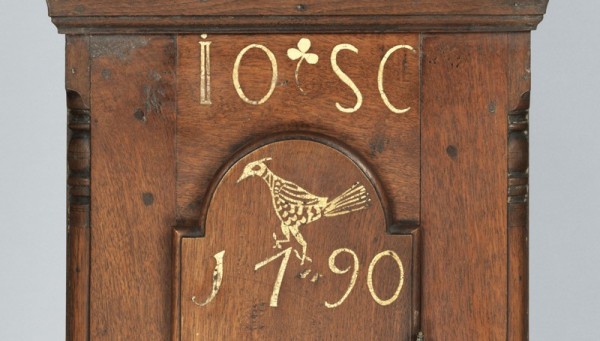
Detail of the inlay on the clock illustrated in fig. 93.
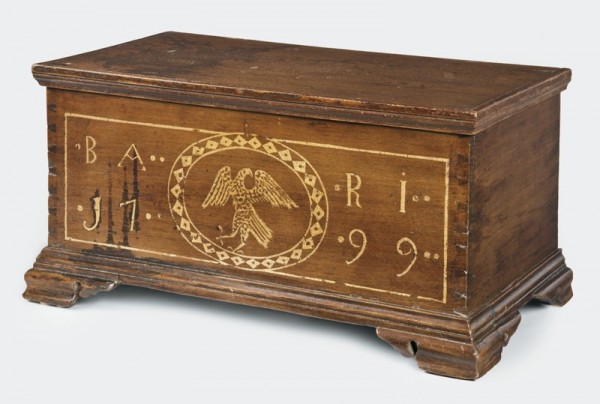
Miniature chest, made for “BA RI,” Lancaster County, Pennsylvania, 1799. Walnut and sulfur inlay with tulip poplar; iron. H. 8 1/2", W. 17 3/4", D. 9 1/2". (Courtesy, Kelly Kinzle Antiques; photo, Gavin Ashworth.)
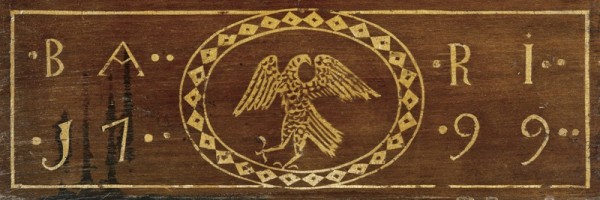
Detail of the inlay on the chest illustrated in fig. 95. (Photo, Gavin Ashworth.)

Straightedge, Lancaster County, Pennsylvania, 1800. Walnut and sulfur inlay. H. 1 7/8", W. 22 1/2", D.1/4". (Courtesy, Stephen and Dolores Smith; photo, Winterthur Museum, Laszlo Bodo.)
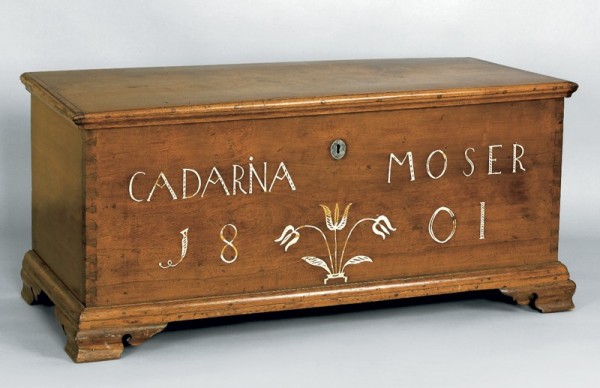
Chest, made for Cadarina Moser, Lancaster County, Pennsylvania, 1801. Walnut and sulfur inlay with white pine; iron. H. 23", W. 48 1/4", D. 20". (Photo, Pook & Pook.)
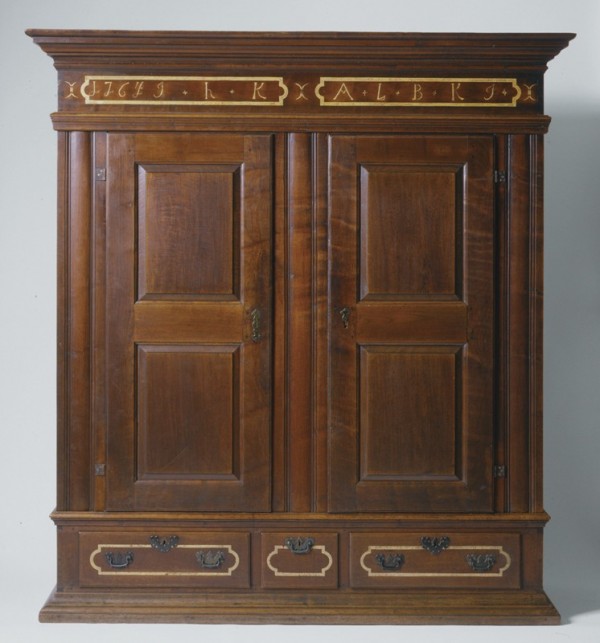
Schrank, probably made for Johannes and Anna Elisabeth Kauffman, East Hempfield Township, Lancaster County, Pennsylvania, 1764. Walnut and sulfur inlay with tulip poplar and oak; brass, iron. H. 80 1/2", W. 73 3/4", D. 35". (Private collection; photo, Philip H. Bradley Co.)
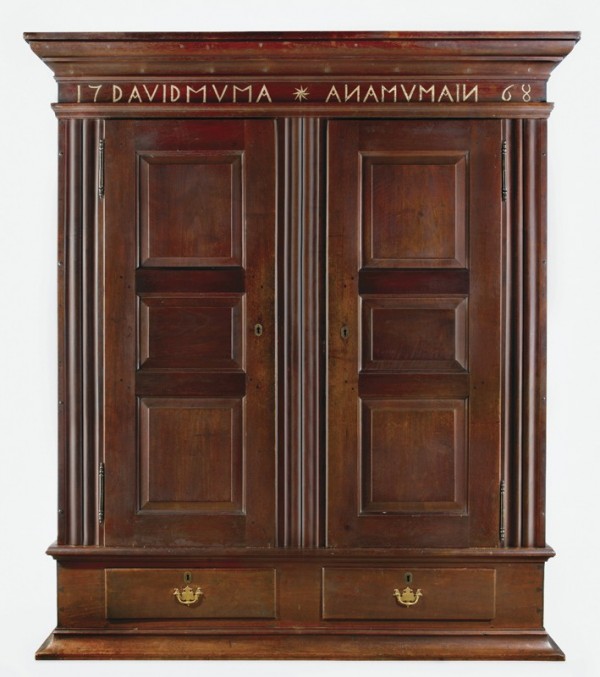
Schrank, made for David and Anna Mumma, West Hempfield Township, Lancaster County, Pennsylvania, 1768. Walnut and sulfur inlay; iron, brass. H. 84 1/2", W. 74 1/2", D. 27 1/4". (Courtesy, Lancaster Mennonite Historical Society, bequest of John J. Snyder Jr.; photo, Gavin Ashworth.)

Tall clock, probably Lancaster County, Pennsylvania, 1767. Walnut, sulfur inlay, and mixed-wood inlay with tulip poplar. H. 89 1/8", W. 19 3/4", D. 10 3/4". (Courtesy, Barnes Foundation, Philadelphia, 01.24.25.)

Hood of the clock illustrated in fig. 101.
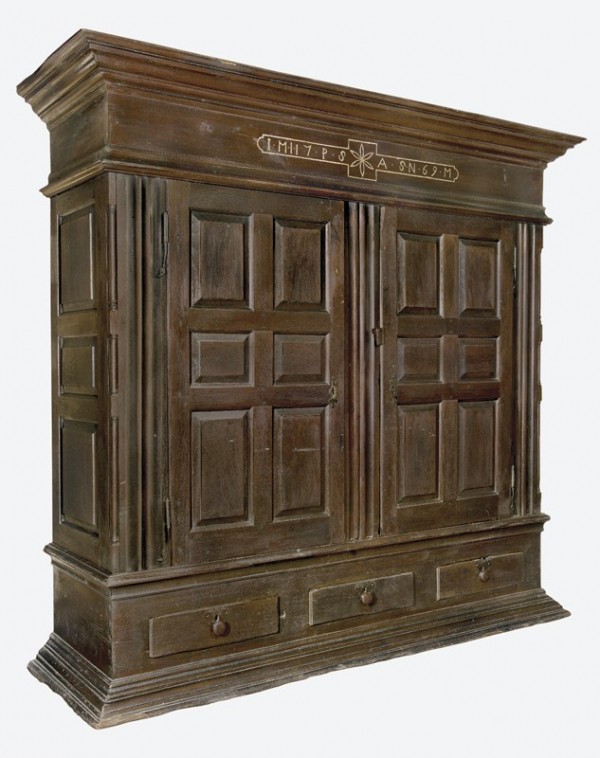
Schrank, probably made for Peter and Ada Schwar, Lancaster County, Pennsylvania, 1769. Walnut and sulfur inlay with tulip poplar and white pine; iron, brass. H. 82", W. 87", D. 27 1/2". (Courtesy, Clarke Hess; photo, Gavin Ashworth.) The five ball feet are missing.

Detail of the inlay on the schrank illustrated in fig. 103. (Photo, Gavin Ashworth.)

Cradle, possibly made for Anna (Schwar) Shenk, Lancaster County, Pennsylvania, 1770. Walnut and sulfur inlay with tulip poplar. H. 28", W. 30", D. 38". (Courtesy, Clarke Hess; photo, Gavin Ashworth.) One of the pillow panels is missing.
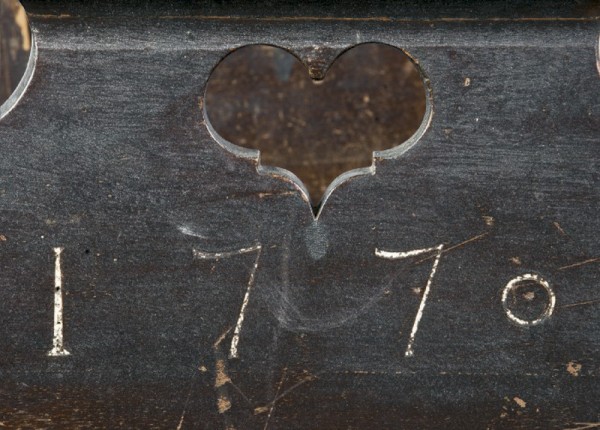
Detail of the inlay on the headboard of the cradle illustrated in fig. 105. (Photo, Gavin Ashworth.)
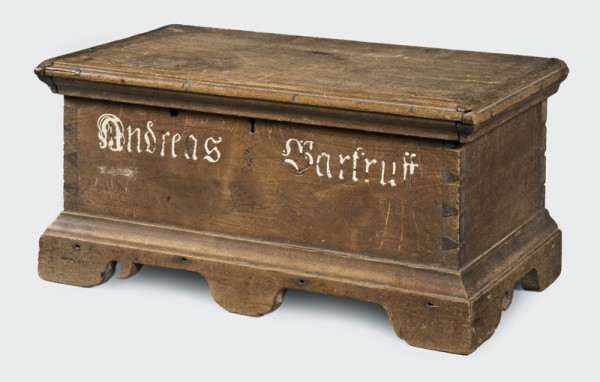
Miniature chest, made for Andreas Bartruff, Manheim, Lancaster County, Pennsylvania, ca. 1775. Walnut and sulfur inlay with tulip poplar; iron. H. 7 5/8", W. 16 1/8", D. 8 5/8". (Private collection; photo, Gavin Ashworth.)
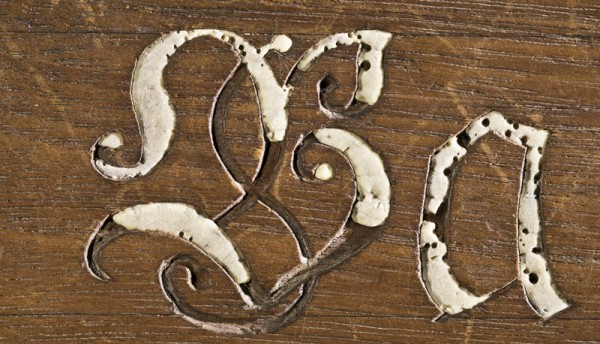
Detail of the inlay on the chest illustrated in fig. 107. (Photo, Gavin Ashworth.)
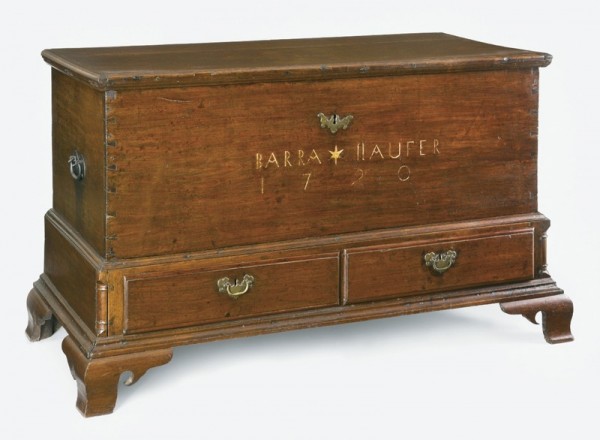
Chest, made for Barbara Stauffer, Lancaster County, Pennsylvania, 1790. Walnut and sulfur inlay with white pine; iron, brass. H. 30 1/2", W. 52 1/2", D. 24 1/2". (Courtesy, Salvatore A. Rizzuto; photo, Gavin Ashworth.) The feet are replaced.
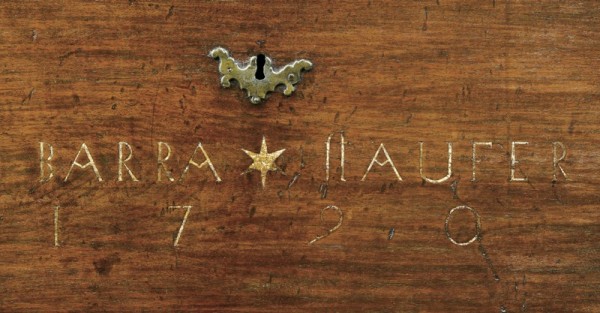
Detail of the inlay on the chest illustrated in fig. 109. (Photo, Gavin Ashworth.)
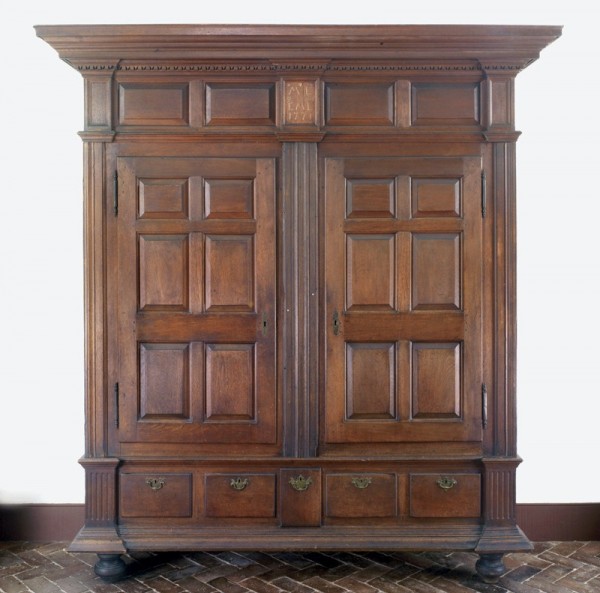
Schrank, made for Michael and Eva Magdalena Ley, probably made by Christoph Uhler, Lebanon, Lancaster (now Lebanon) County, Pennsylvania, 1771. Walnut and sulfur inlay with tulip poplar and white pine; brass. H. 99 1/4", W. 91", D. 26". (Courtesy, Rocky Hill Collection; photo, Winterthur Museum, Laszlo Bodo.)
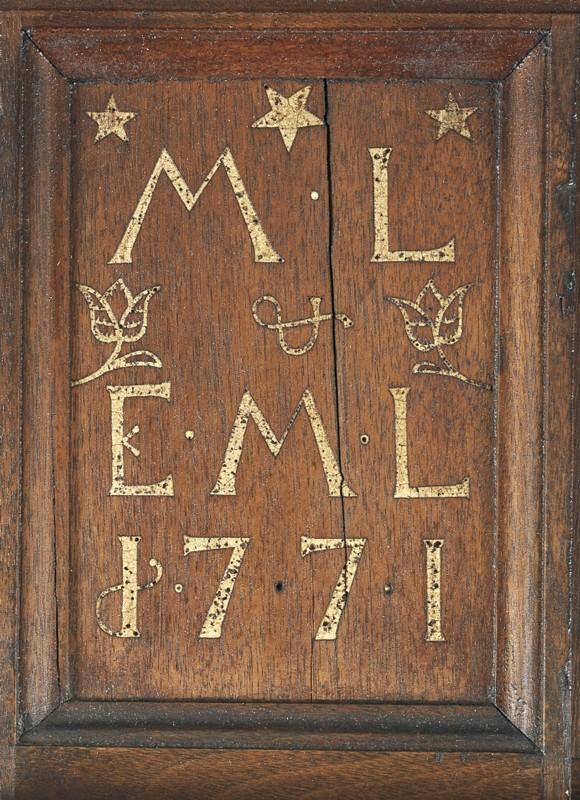
Detail of the inlay on the schrank illustrated in fig. 111.
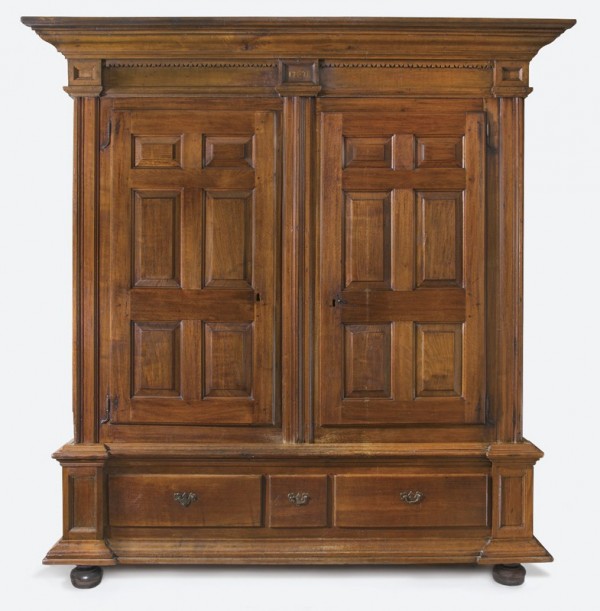
Schrank, probably made by Christoph Uhler (1741–1804), Lebanon, Lancaster (now Lebanon) County, Pennsylvania, 1771. Walnut and sulfur inlay with pine and tulip poplar; iron, brass. H. 91 1/2", W. 86 1/2", D. 26". (Private collection; photo, Gavin Ashworth.)
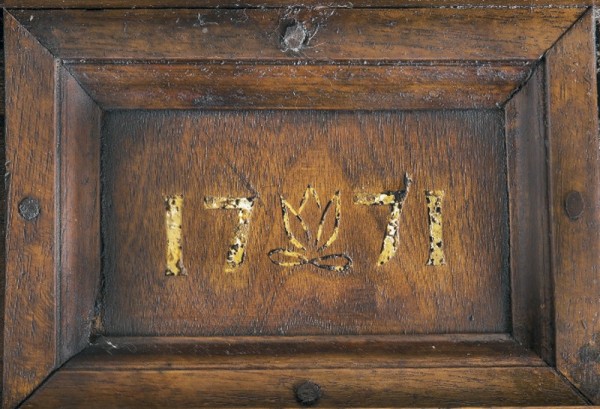
Detail of the inlay on the schrank illustrated in fig. 113. (Photo, Gavin Ashworth.)
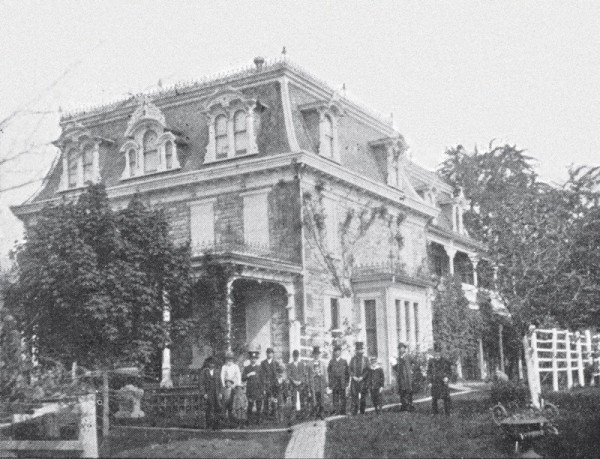
Tulpehocken Manor, built for Michael and Eva Magdalena Ley, Lebanon County, Pennsylvania, 1769, remodeled 1883, photo ca. 1885. (From Rev. P.C. Croll, Ancient and Historic Landmarks in the Lebanon Valley [Philadelphia: Lutheran Publication Society, 1895].)
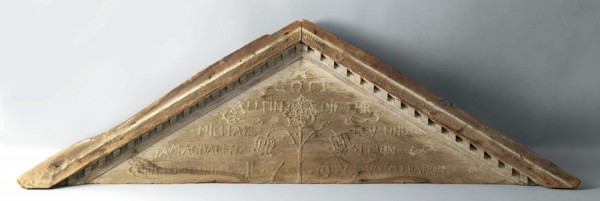
Door pediment from Tulpehocken Manor, signed by Christoph Uhler, Lebanon, Lancaster (now Lebanon) County, 1769. White pine; paint. H. 21 3/4", W. 70 1/4", D. 3 3/4". (Courtesy, James C. Keener; photo, Winterthur Museum, Laszlo Bodo.)
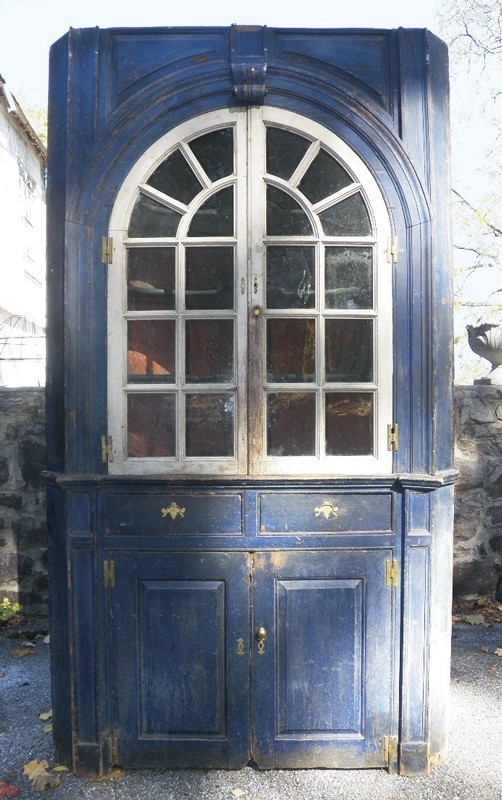
Corner cupboard from Tulpehocken Manor, probably made by Christoph Uhler, Lebanon, Lancaster (now Lebanon) County, ca. 1769. Pine and tulip poplar; paint; glass. H. 101", W. 57", D. 40". (Courtesy, Greg K. Kramer and Co.)
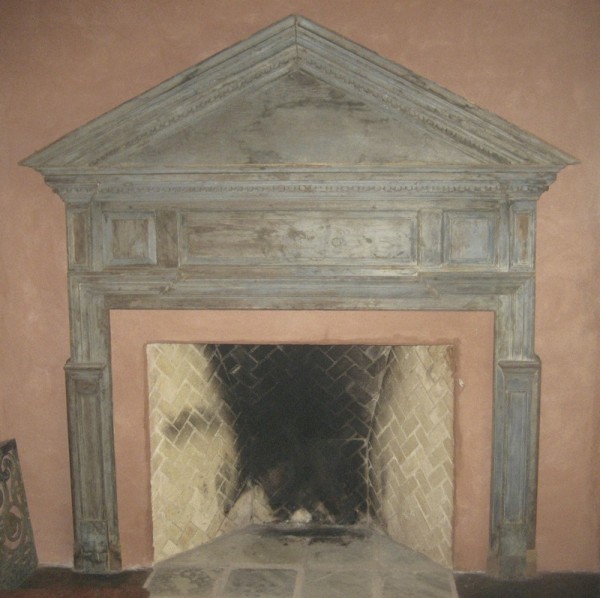
Fireplace surround from Tulpehocken Manor, probably made by Christoph Uhler, Lebanon, Lancaster (now Lebanon) County, ca. 1769. (Courtesy, Lynda and Richard Levengood; photo, Lisa Minardi.)

Tall clock, probably made for Henry Eshleman, movement signed by John Heinselman, Manheim, Lancaster County, Pennsylvania, 1795. Walnut and sulfur inlay with tulip poplar. H. 86", W. 18 1/4", D. 10 1/4". (Courtesy, Rock Ford Plantation, bequest of John J. Snyder Jr.; photo, Gavin Ashworth.)

Detail of the inlay on the clock illustrated in fig. 119. (Photo, Gavin Ashworth.)
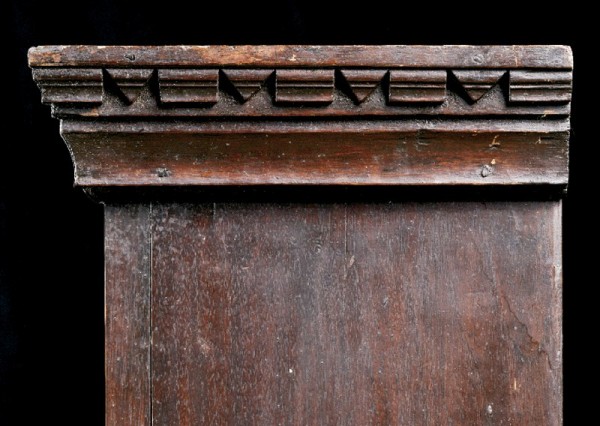
Detail of the cornice on the clock illustrated in fig. 119. (Photo, Gavin Ashworth.)
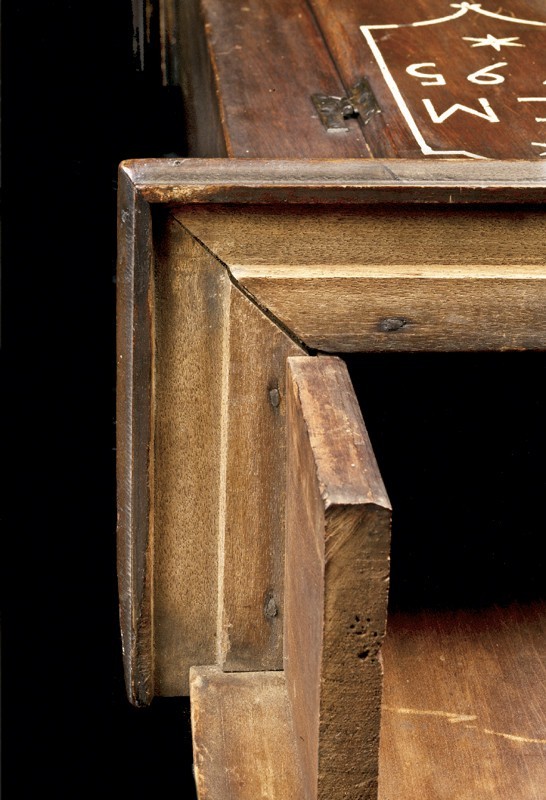
Detail of the groove for the hood on the clock illustrated in fig. 119. (Photo, Gavin Ashworth.)

Tall clock, made for “H h,” movement signed by Christian Forrer, Lampeter, Lancaster County, Pennsylvania, 1766. Walnut and sulfur inlay. H. 89 3/4", W. 21," D. 11 3/4". (Courtesy, Ed and Mary Ann Dixon; photo, Gavin Ashworth.)
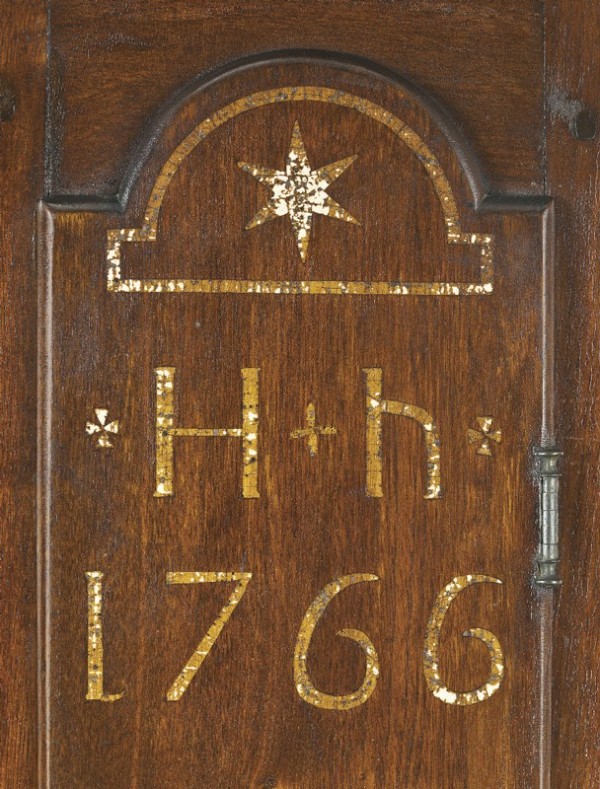
Detail of the inlay on the clock illustrated in fig. 123. (Photo, Gavin Ashworth.)

Tall clock, probably made for Michael Horst, movement signed by George Hoff, Lancaster, Lancaster County, Pennsylvania, 1785. Walnut and sulfur inlay with white pine. H. 84 3/4", W. 22," D. 12". (Courtesy, Clarke Hess; photo, Gavin Ashworth.) The base has been shortened.

Tall clock, made for “A M,” probably Lancaster County, Pennsylvania, 1795. Walnut and sulfur inlay with tulip poplar; brass. H. 87", W. 20 1/2," D. 10 3/4". (Courtesy, Carl and Yvonne De Paulis; photo, Gavin Ashworth.)

Detail of the inlay on the tall clock illustrated in fig. 126. (Photo, Gavin Ashworth.)

Chest, probably made for Jacob Ebersole, probably Lancaster County, Pennsylvania, 1785. Walnut and sulfur inlay; iron, brass. H. 28", W. 52", D. 25". (Courtesy, Leslie Miller and Richard Worley; photo, Gavin Ashworth.)
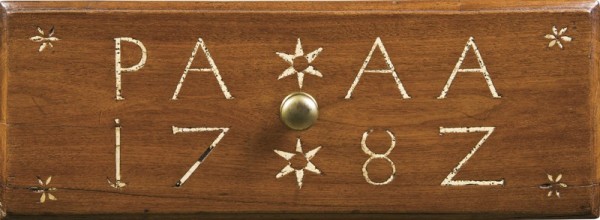
Drawer from a table, made for “PA AA,” probably Lancaster County, Pennsylvania, 1782. Walnut and sulfur inlay. Dimensions unrecorded. (Private collection; photo, Gavin Ashworth.)
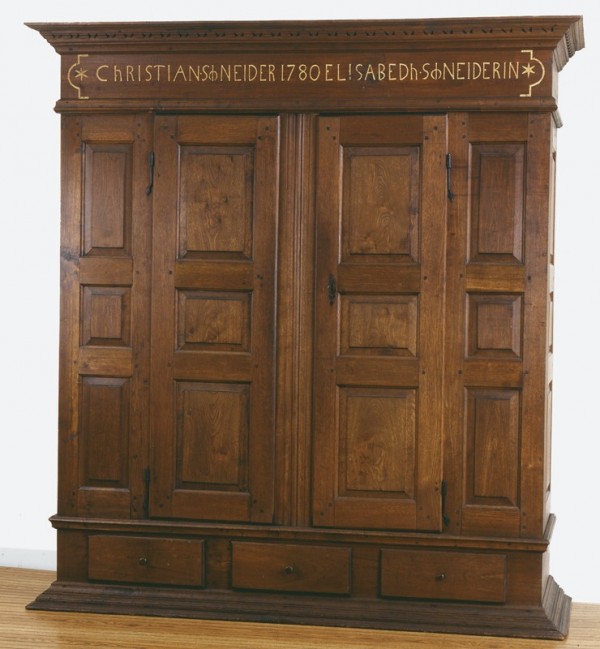
Schrank, made for Christian and Elisabeth Schneider, probably Lancaster County, Pennsylvania, 1780. Walnut and sulfur inlay; iron. H. 80 1/2", W. 74", D. 24 1/4". (Private collection; photo, Joseph Schneider Haus.)

Frieze of a schrank, made for John and Mary Mennig/Minnich, probably Lancaster County, Pennsylvania, 1789. Walnut and sulfur inlay. H. 8 3/4", W. 68 3/4", D. 1". (Courtesy, David A. Schorsch; photo, Gavin Ashworth.)

Cradle, made for “EV MI,” probably Lancaster County, Pennsylvania, 1789. Walnut and sulfur inlay. H. 22 3/4", W. 28 1/8", D. 38 3/8". (Courtesy, Winterthur Museum, promised gift of David A. Schorsch and Eileen M. Smiles; photo, James Schneck.)
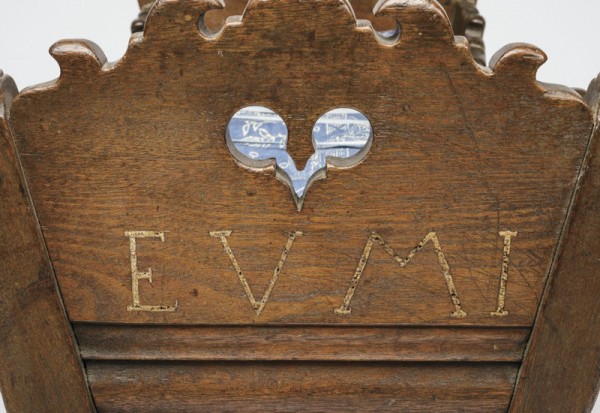
Detail of the inlay on headboard of the cradle illustrated in fig. 132.
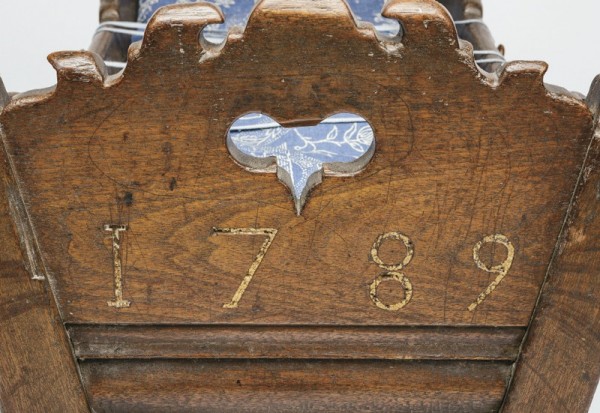
Detail of the inlay on the footboard of the cradle illustrated in fig. 132.
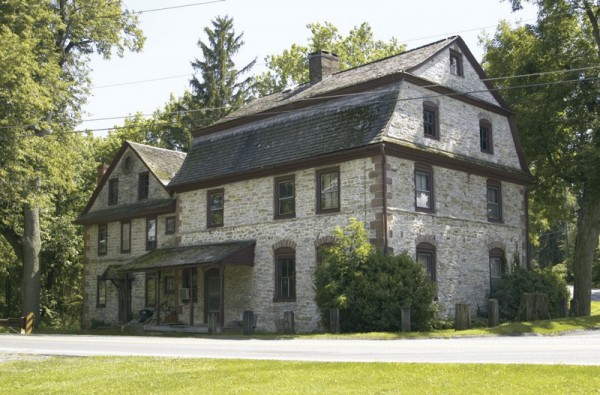
House of George and Maria Catharina Miller, Millbach, Lebanon County, Pennsylvania, 1752. (Courtesy, Millbach Foundation; photo, Winterthur Museum, Laszlo Bodo.)
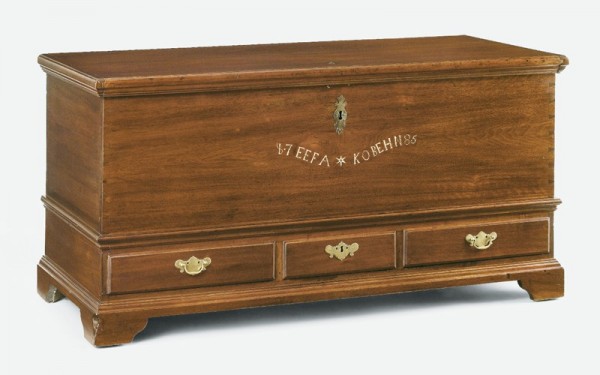
Chest, probably made for Eva Koppenhefer, Lebanon County, Pennsylvania, 1785. Walnut and sulfur inlay with white pine and tulip poplar; iron, brass. H. 28 1/2", W. 54 7/8", D. 24 3/8". (Courtesy, Philip H. Bradley Co.; photo, Gavin Ashworth.)

Detail of the inlay on the chest illustrated in fig. 136. (Photo, Gavin Ashworth.)
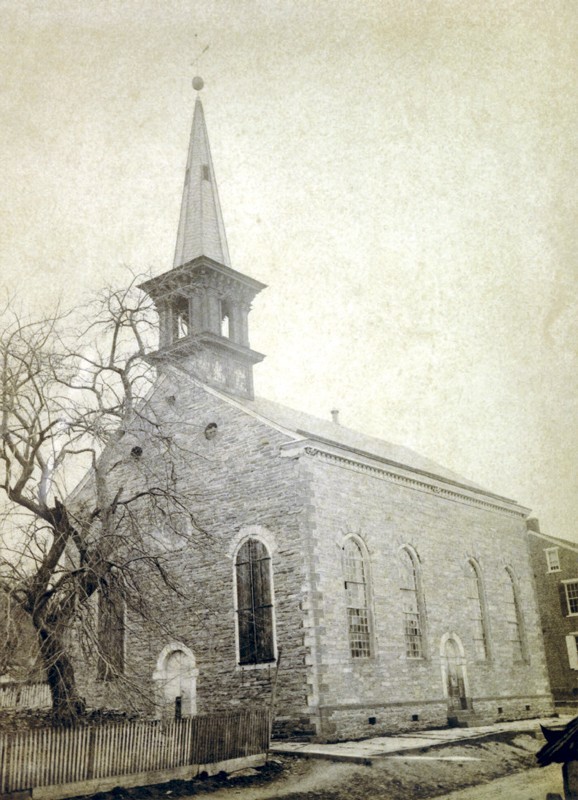
Christ Lutheran Church, near Stouchsburg, Marion Township, Berks County, Pennsylvania, built in 1786. (Courtesy, Mr. and Mrs. Michael Emery.)
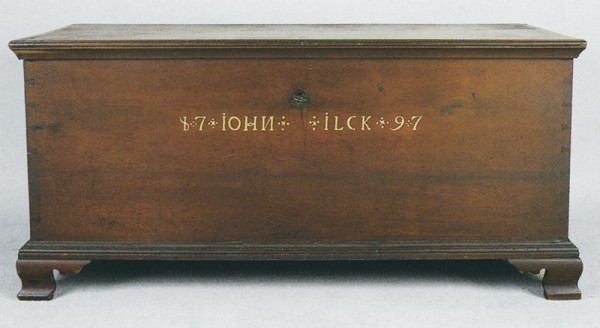
Chest, made for John Illig, Lebanon County, Pennsylvania, 1797. Walnut and sulfur inlay. H. 25", W. 52 1/2", D. 23". (Private collection; photo, Conestoga Auction Co.)

Detail of a door lintel, probably Middletown, Dauphin County, Pennsylvania, 1764. Pine. H. 9", W. 40 1/2", D. 5 1/4". (Courtesy, Pennsylvania Historical and Museum Commission, State Museum of Pennsylvania.)
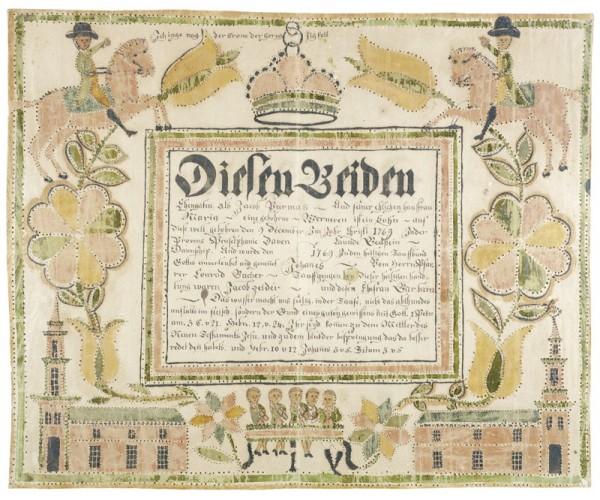
Birth and baptismal certificate, made for Johannes Poorman, Paxton Township, Dauphin County, Pennsylvania, ca. 1785. Watercolor and ink on laid paper. 12 1/2" x 15 1/2". (Courtesy, Susan and Stephen Babinsky; photo, Winterthur Museum, James Schneck.)
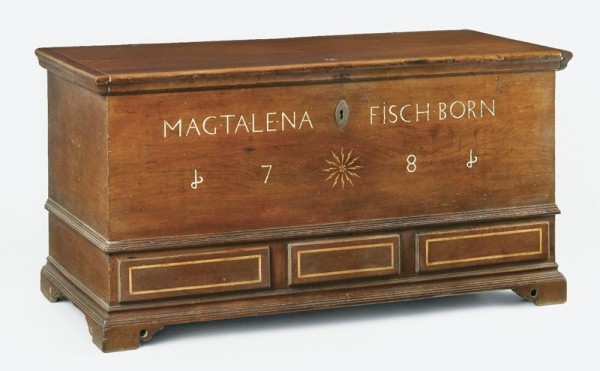
Chest, made for Magdalena Fischborn, Dauphin County, Pennsylvania, 1781. Walnut, sulfur inlay, and mixed-wood inlay with pine; iron. H. 27 1/2", W. 52 3/4", D. 24 1/4". (Courtesy, Carl and Yvonne De Paulis; photo, Gavin Ashworth.)
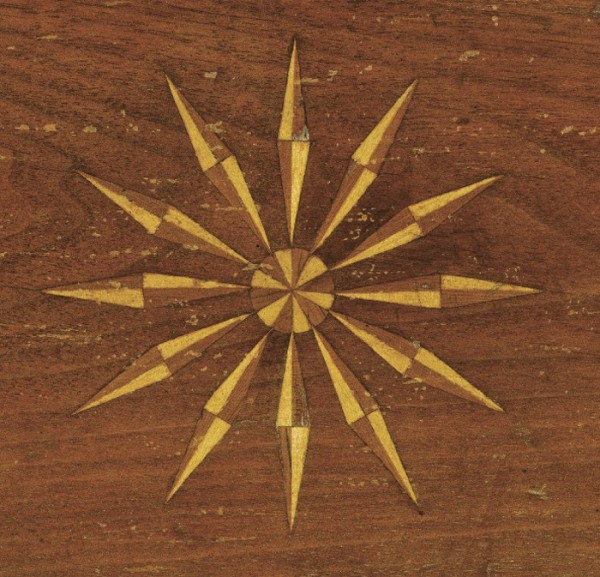
Detail of the inlaid star on the chest illustrated in fig. 142. (Photo, Gavin Ashworth.)
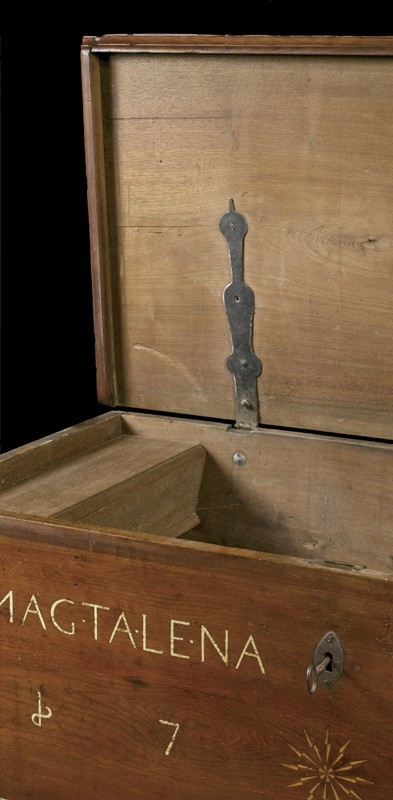
Detail of the till compartment of the chest illustrated in fig. 142. (Photo, Gavin Ashworth.)
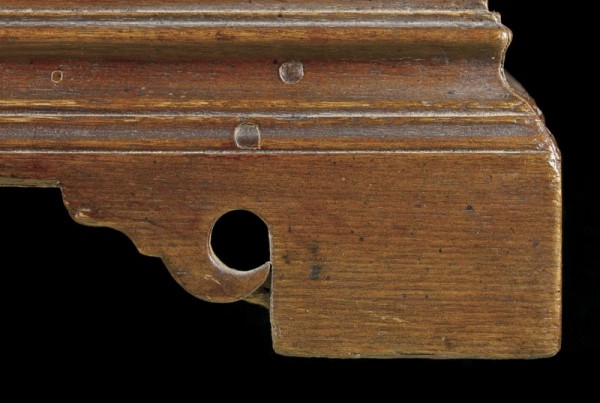
Detail of the bracket foot of the chest illustrated in fig. 142. (Photo, Gavin Ashworth.)
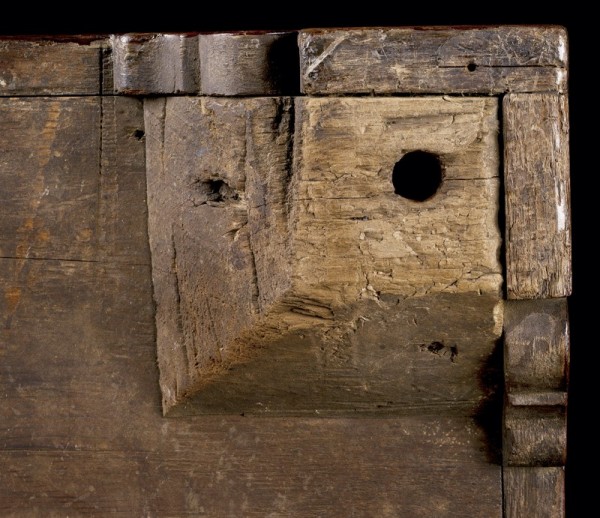
Detail of the glue block of the chest illustrated in fig. 142. (Photo, Gavin Ashworth.)
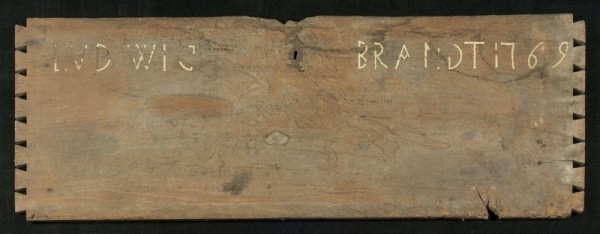
Façade of a chest, made for Ludwig Brandt, Dauphin County, Pennsylvania, 1769. Walnut with sulfur inlay; iron. H. 18 3/8", W. 51 3/4", D. 1". (Courtesy, Edward and Linda Rosenberry; photo, Winterthur Museum, James Schneck.)
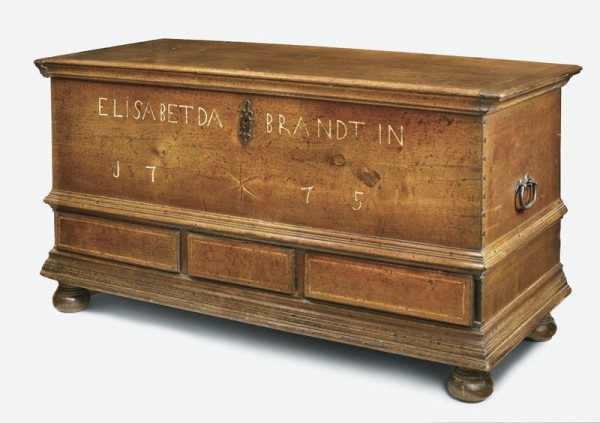
Chest, made for Elisabetha Brandt, Dauphin County, Pennsylvania, 1775. Walnut with sulfur and wood inlay and white pine and tulip poplar; iron. H. 30 1/2", W. 58 3/4", D. 25 3/4". (Courtesy, Renfrew Museum; photo, Gavin Ashworth.)
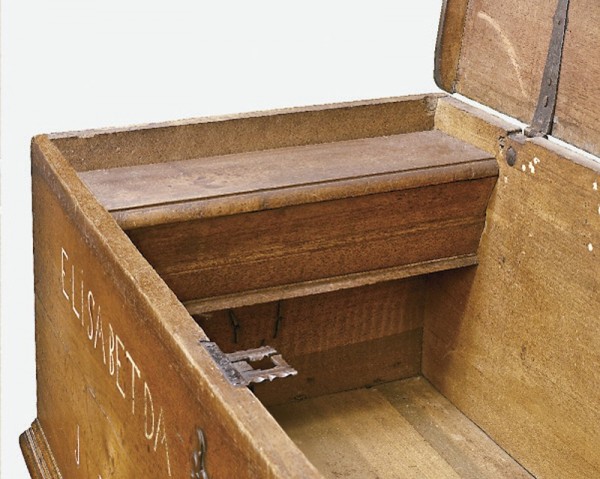
Detail of the till compartment of the chest illustrated in fig. 148. (Photo, Gavin Ashworth.)
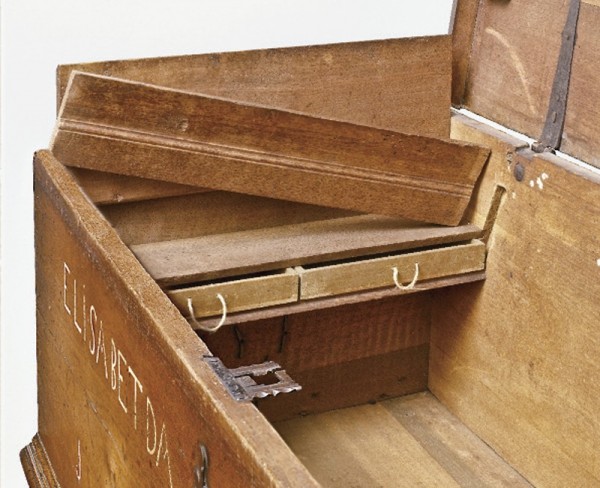
Detail of the hidden drawers of the chest illustrated in fig. 148. (Photo, Gavin Ashworth.)
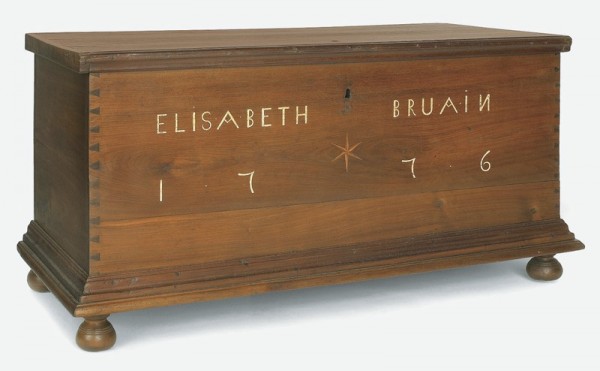
Chest, made for Elisabeth Brua, Dauphin County, Pennsylvania, 1776. Walnut, sulfur inlay, and wood inlay with tulip poplar; iron. H. 26", W. 49 1/2", D. 24". (Courtesy, Pook & Pook.)
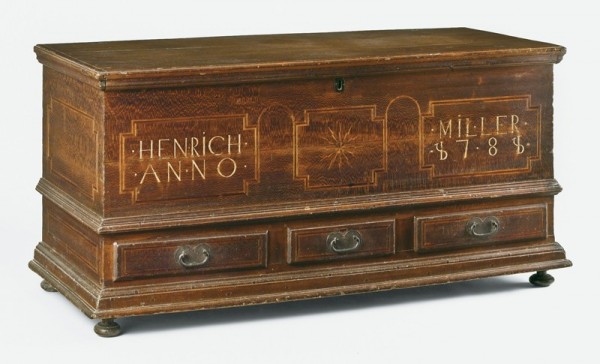
Chest, made for Henrich Miller, Dauphin County, Pennsylvania, 1781. Sycamore, sulfur inlay, and mixed-wood inlay with tulip poplar; iron, brass. H. 27 3/4", W. 54 1/4", D. 24". (Courtesy, Rocky Hill Collection; photo, Gavin Ashworth.)
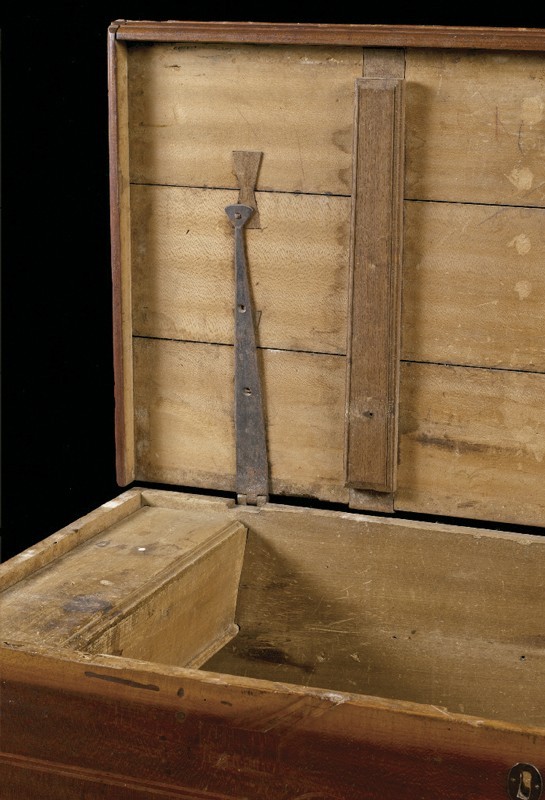
Interior of the chest illustrated in fig. 152. (Photo, Gavin Ashworth.) The maker used a sliding batten to stabilize the three-board lid and installed a slanted till compartment.
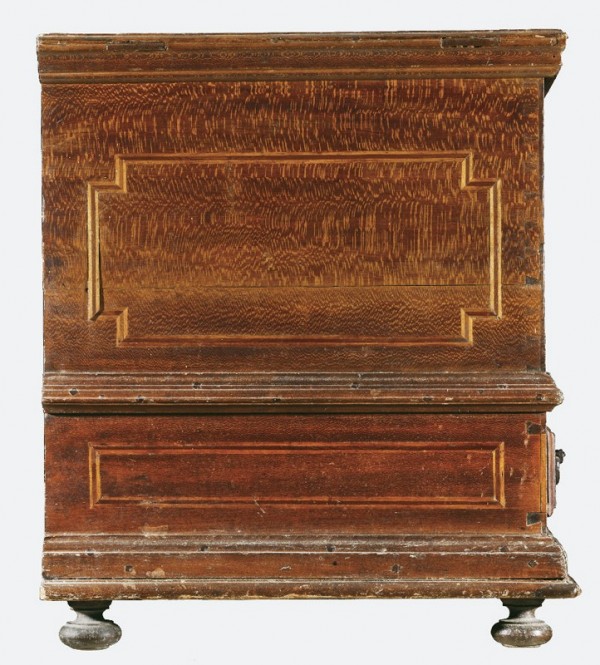
Side of the chest illustrated in fig. 152. (Photo, Gavin Ashworth.)
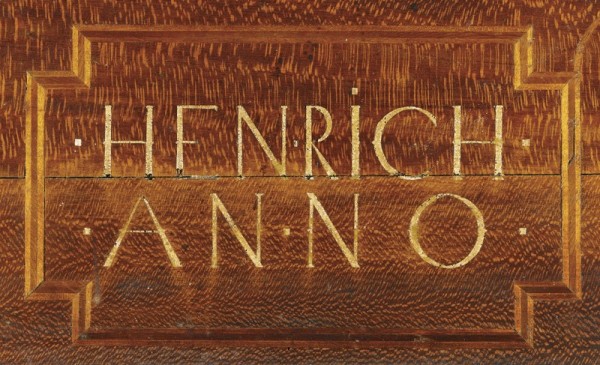
Detail of the inlay on the façade of the chest illustrated in fig. 152. (Photo, Gavin Ashworth.)
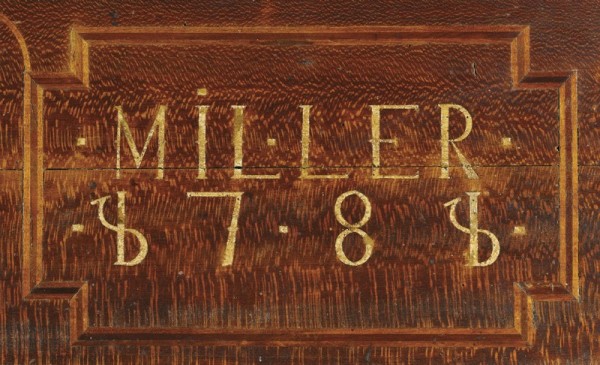
Detail of the inlay on the façade of the chest illustrated in fig. 152. (Photo, Gavin Ashworth.)

Chest, made for Lutwig Fischborn, Dauphin County, Pennsylvania, 1783. Walnut, sulfur inlay, and mixed-wood inlay with tulip poplar; brass, iron. H. 27 1/2", W. 51 1/2", D. 23 3/4". (Courtesy, Carl and Yvonne De Paulis; photo, Gavin Ashworth.)

Detail of the inlay on the chest illustrated in fig. 157. (Photo, Gavin Ashworth.)
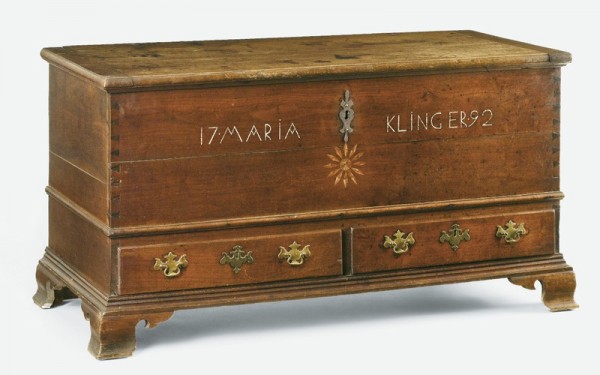
Chest, made for Maria Klinger, Dauphin County, Pennsylvania, 1792. Walnut, sulfur inlay, and mixed-wood inlay with tulip poplar and white pine; brass, iron. H. 27", W. 51 1/2", D. 24". (Courtesy, Rock Ford Plantation, bequest of John J. Snyder Jr.; photo, Gavin Ashworth.)
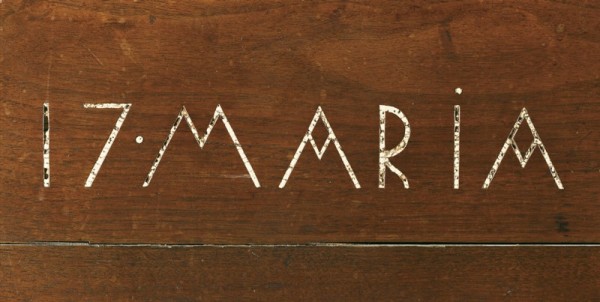
Detail of the inlay on the chest illustrated in fig. 159. (Photo, Gavin Ashworth.)
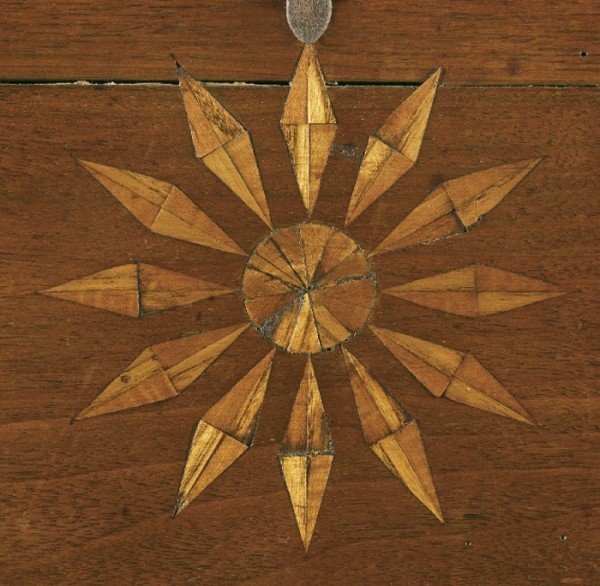
Detail of the inlay on the chest illustrated in fig. 159. (Photo, Gavin Ashworth.)
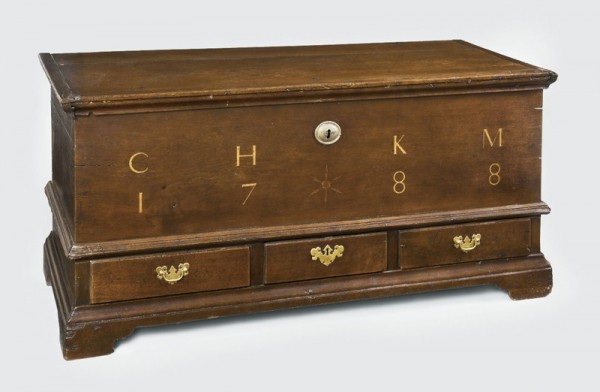
Chest, made for “CH KM,” probably Dauphin County, Pennsylvania, 1788. Walnut and mixed-wood inlay with tulip poplar; brass, iron. H. 26", W. 54", D. 23". (Courtesy, Clarke Hess; photo, Gavin Ashworth.)
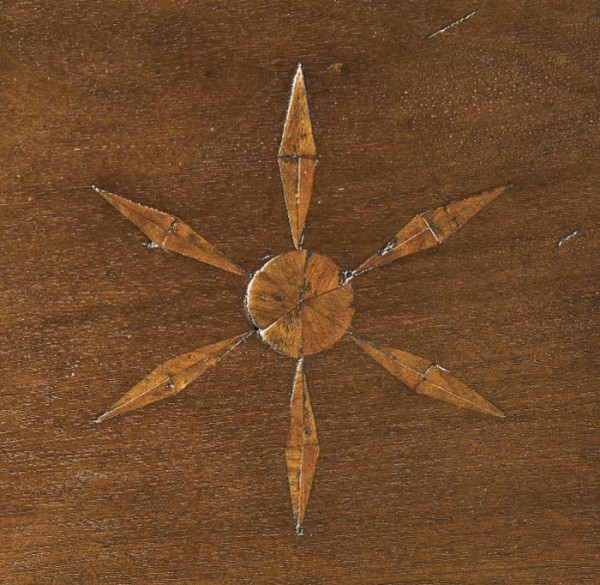
Detail of the star inlay on the chest illustrated in fig. 162. (Photo, Gavin Ashworth.)
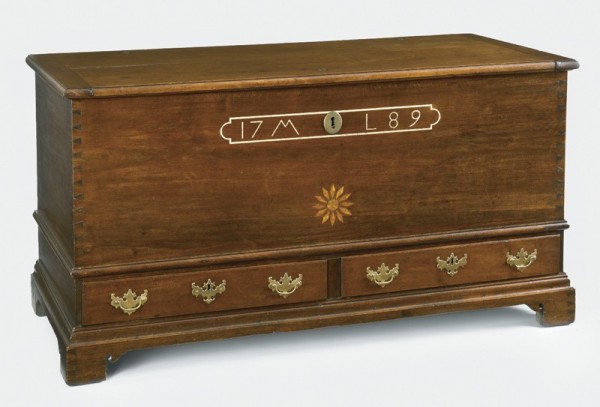
Chest, made for “ML,” probably Dauphin County, Pennsylvania, 1789. Walnut, sulfur inlay, and mixed-wood inlay with tulip poplar; brass, iron. H. 27 1/8", W. 50", D. 23 3/4". (Courtesy, Mr. and Mrs. Stephen D. Hench; photo, Gavin Ashworth.)
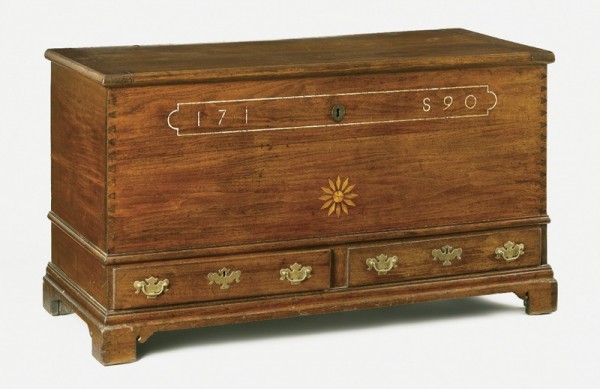
Chest, made for “IS,” Dauphin County, Pennsylvania, 1790. Walnut and sulfur inlay with tulip poplar; brass, iron. H. 27 1/2", W. 49 1/2", D. 23". (Courtesy, Winterthur Museum, bequest of John J. Snyder Jr.; photo, Gavin Ashworth.)
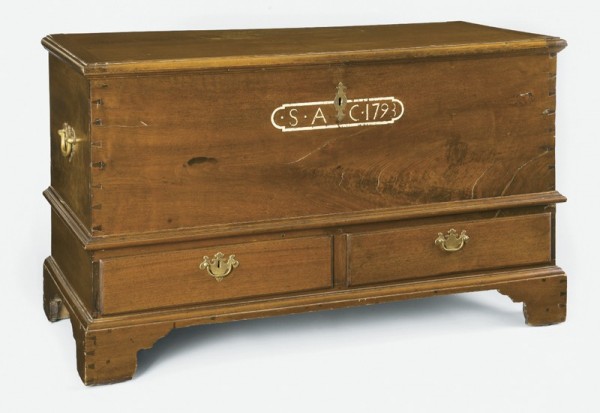
Chest, made for “S A C,” probably Dauphin County, Pennsylvania, 1793. Walnut and sulfur inlay with tulip poplar; brass, iron. H. 29 5/8", W. 50 1/2", D. 23 3/4". (Courtesy, Pennsylvania Historical and Museum Commission, Landis Valley Village and Farm Museum, bequest of John J. Snyder Jr.; photo, Gavin Ashworth.)
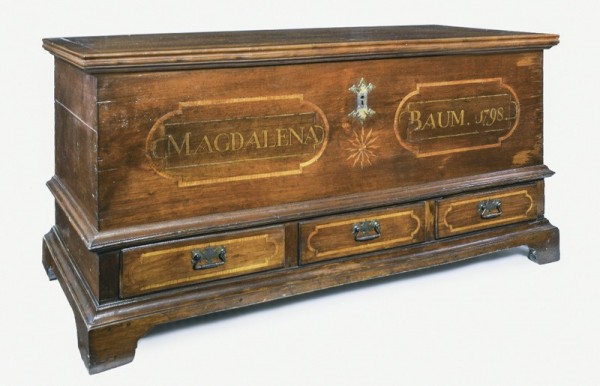
Chest, made for Magdalena Baum, probably Dauphin County, Pennsylvania, 1798. Walnut and mixed-wood inlay with white pine and tulip poplar; brass, iron; paint. H. 27", W. 55 1/2", D. 23". (Courtesy, Historical Society of Dauphin County, Harrisburg, Pa.; photo, David Pickel.)
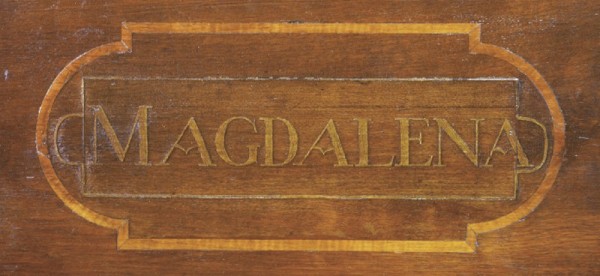
Detail of the inlay and paint on the chest illustrated in fig. 167.
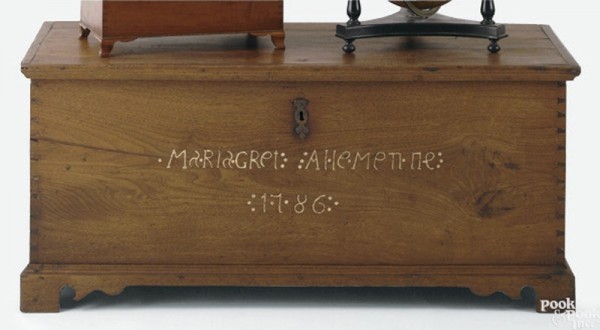
Chest, made for Margaret Alleman, Dauphin County, Pennsylvania, 1786. Walnut and sulfur inlay; iron. H. 22", W. 48", D. 24". (Photo, Pook & Pook.)
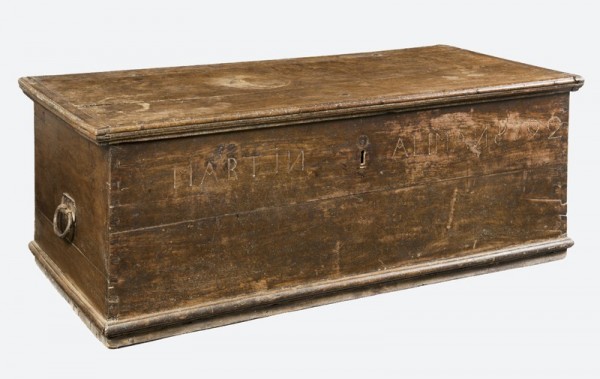
Chest, made for Martin Alleman, Dauphin County, Pennsylvania, 1792. Walnut and sulfur inlay with white pine, tulip poplar; iron. H. 20 1/2", W. 52", D. 24 1/4". (Courtesy, Clarke Hess; photo, Gavin Ashworth.) The chest was originally over drawers and has been reduced in height.

Detail of the inlay on the chest illustrated in fig. 170. (Photo, Gavin Ashworth.)
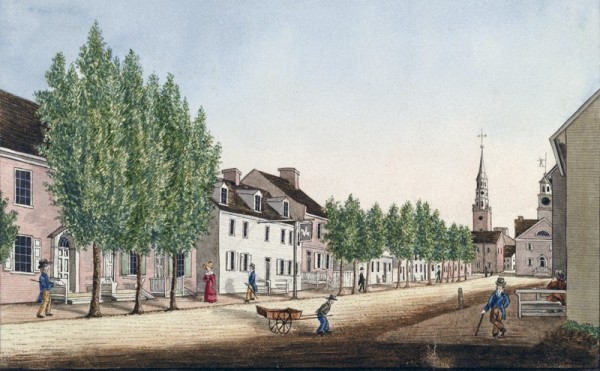
William Wagner, view of York, York County, Pennsylvania, 1830. (Courtesy, York County Heritage Trust, York, Pa.)

Tall clock, made for “A G and AMG,” movement signed by John Fisher, York, York County, Pennsylvania, 1773. Walnut and sulfur inlay. H. 99", W. 17 1/2", D. 11 1/2". (Private collection; photo, Winterthur Library, Decorative Arts Photographic Collection.)
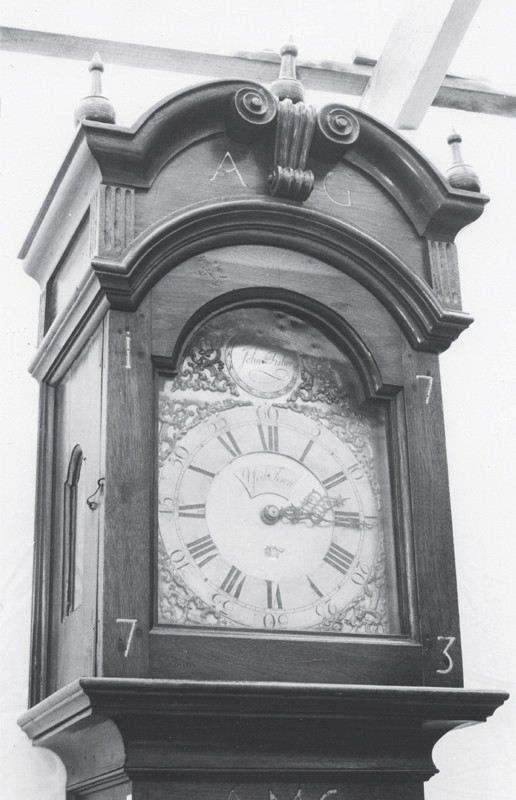
Detail of the clock illustrated in fig. 173.
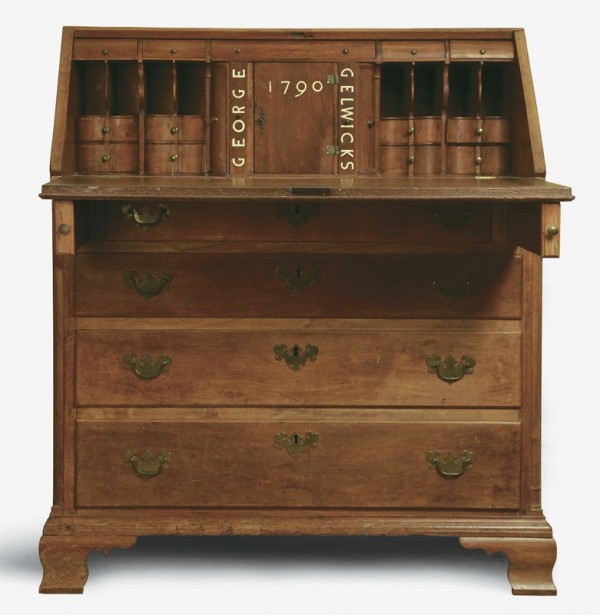
Desk, made for George Gelwicks, York County, Pennsylvania, 1790. Walnut with sulfur inlay and pine. H. 44 1/4", W. 41 1/4", D. 22". (Private collection; photo, Rob Manko.)
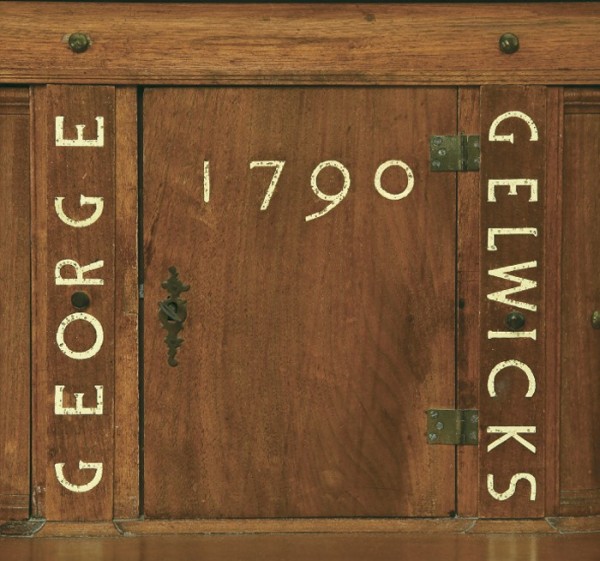
Detail of the inlay on the desk illustrated in fig. 175.
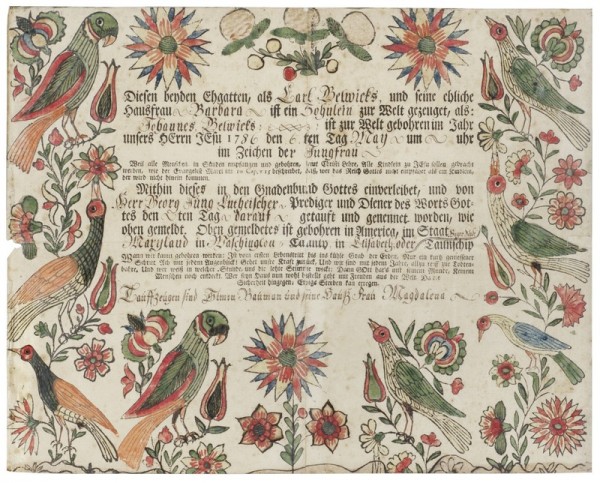
Birth and baptismal certificate for Johannes Gelwicks, decoration and infill attributed to the Pseudo-Otto Artist, printed form attributed to the Ephrata Cloister, Lancaster County, Pennsylvania, ca. 1788. Watercolor and ink on laid paper. 13" x 16". (Courtesy, Philadelphia Museum of Art, promised gift of Joan and Victor Johnson; photo, Graydon Wood.)

Chest of drawers, made for Casper Renaker, York County, Pennsylvania, ca. 1790. Walnut and sulfur inlay with pine and tulip poplar. H. 51 1/2", W. 41 1/4", D. 22". (Courtesy, Carl and Yvonne De Paulis; photo, Gavin Ashworth.) The feet, top, and knobs are replaced.
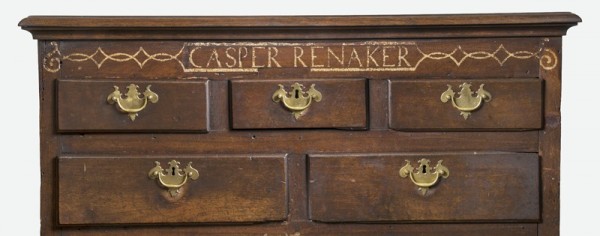
Detail of the inlay on the chest of drawers illustrated in fig. 178. (Photo, Gavin Ashworth.)
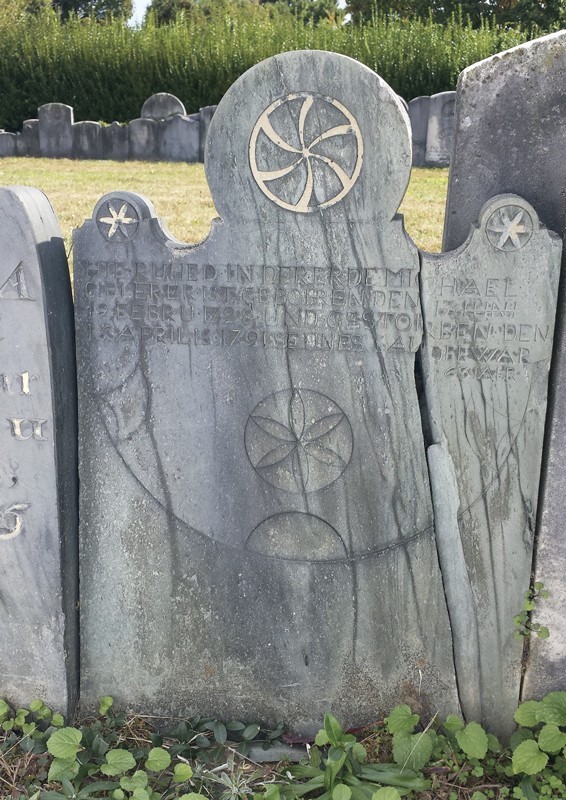
Tombstone for Michael Gibler, St. Mary’s Church, Carroll County, Maryland, 1791. (Photo, Lisa Minardi.)
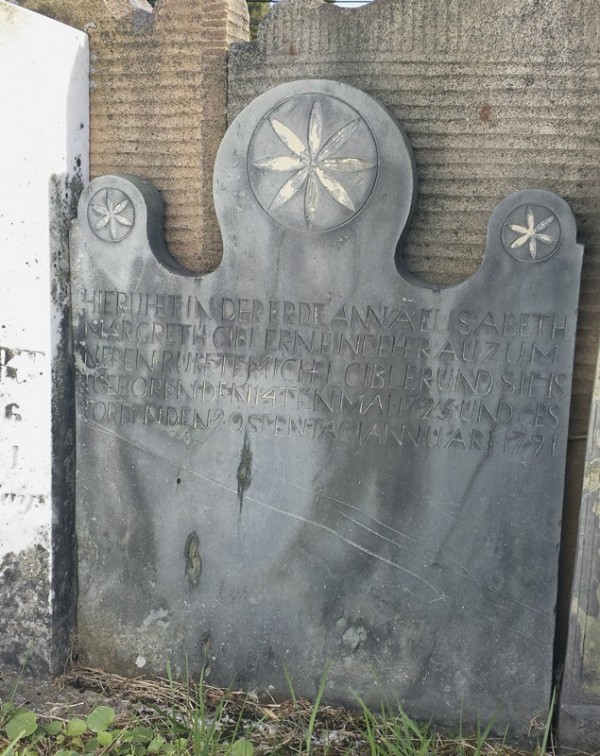
Tombstone for Anna Elisabeth Margreth Gibler, St. Mary’s Church, Carroll County, Maryland, 1791. (Photo, Lisa Minardi.)

Tombstone for Paul Renecker, St. Mary’s Church, Carroll County, Maryland, 1799. (Photo, Lisa Minardi.)
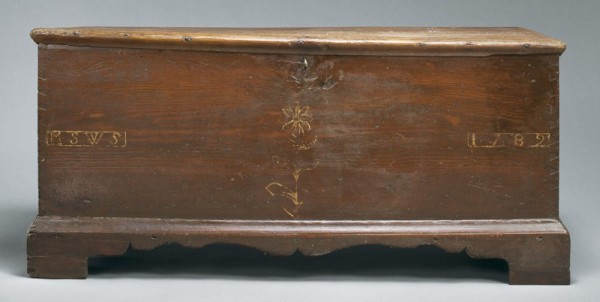
Chest, probably York County, Pennsylvania, 1789. Yellow pine; paint; iron. H. 22 1/2", W. 49", D. 21 1/2". (Courtesy, Museum of the Shenandoah Valley, Winchester, Va.; photo, Ron Blunt.) The left foot is restored. It is also possible that this chest was made in Shenandoah County, Virginia.
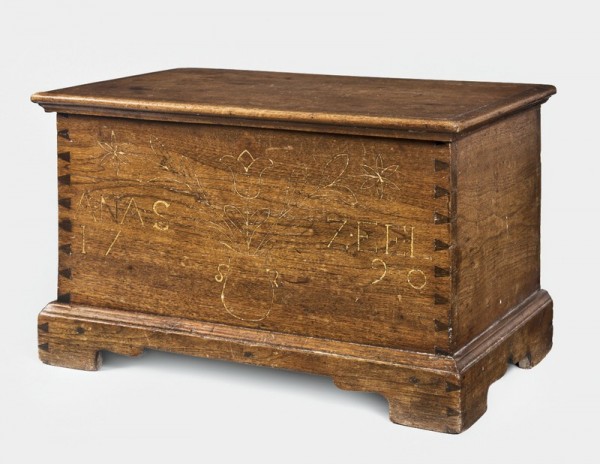
Miniature chest, probably made for Anna Sell/Zell, York County, Pennsylvania, 1790. Walnut and sulfur inlay with pine. H. 11 3/8", W. 19 1/4", D. 11 1/2". (Private collection; photo, Gavin Ashworth.)
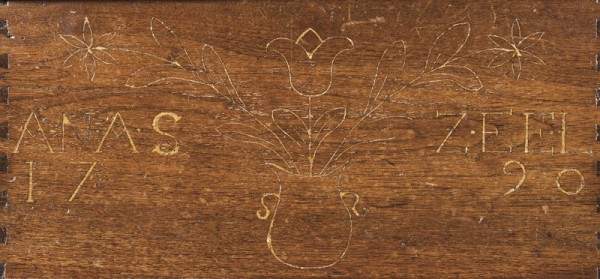
Detail of the inlay on the chest illustrated in fig. 184. (Photo, Gavin Ashworth.)

Chest, probably made for Peter Holtzappel, York County, Pennsylvania, 1791. Walnut and sulfur inlay with pine; paint. H. 24 1/2", W. 49", D. 20 1/4". (Courtesy, Clarke Hess; photo, Gavin Ashworth.) The feet and base molding are replaced.
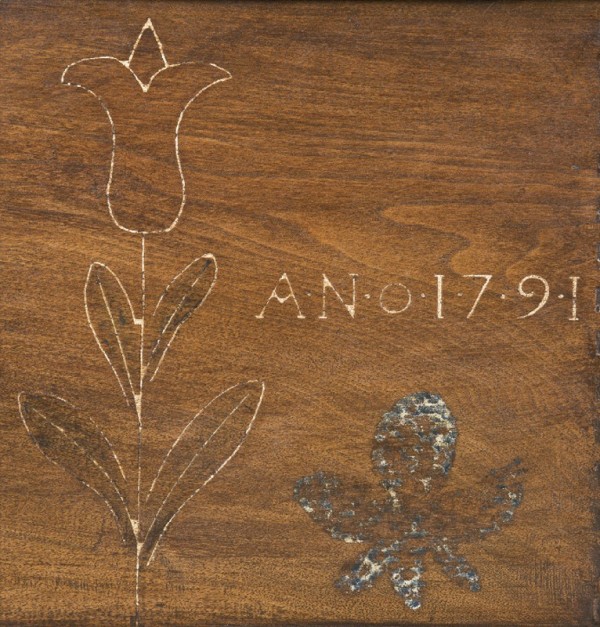
Detail of the inlay on the chest illustrated in fig. 186. (Photo, Gavin Ashworth.)
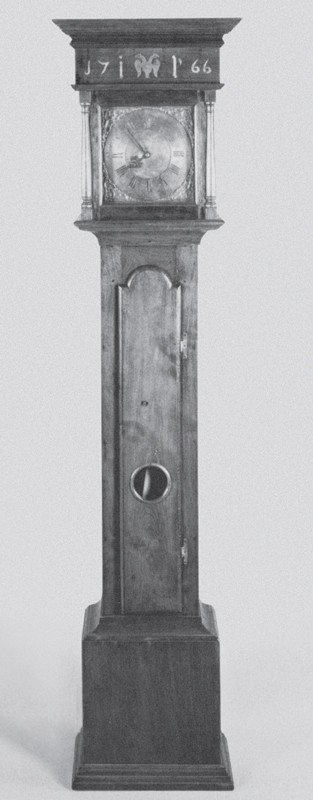
Tall clock, southeastern Pennsylvania, 1766. Walnut, sulfur inlay, and mixed-wood inlay; secondary woods unrecorded. H. 88", W. 19", D. 10 1/2". (Location unknown; photo, Christie’s.)
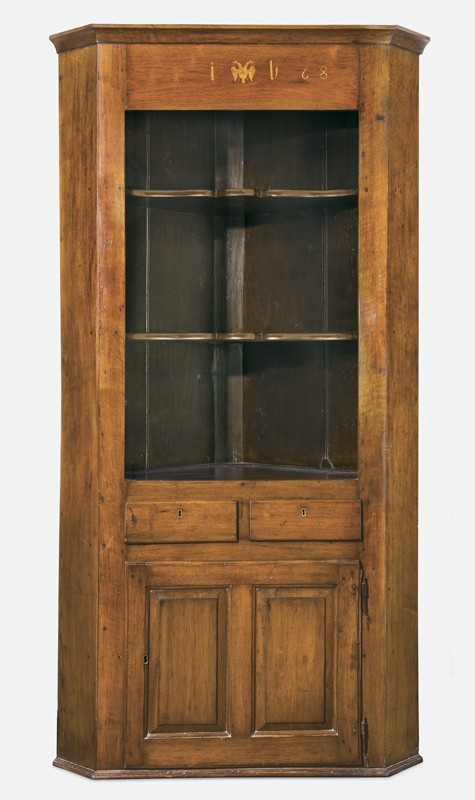
Corner cupboard, southeastern Pennsylvania, 1768. Walnut, sulfur inlay, and mixed-wood inlay with tulip poplar and pine; iron, brass. H. 85 1/2", W. 47", D. 22 1/2". (Courtesy, Renfrew Museum; photo, Gavin Ashworth.) The upper door is missing.
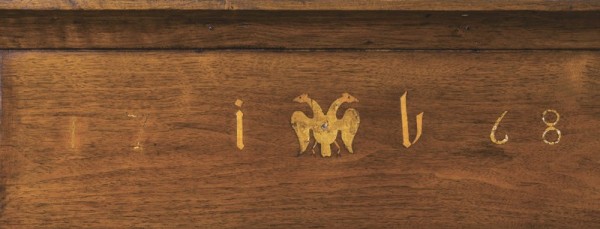
Detail of the inlay on the cupboard illustrated in fig. 189. (Photo, Gavin Ashworth.)
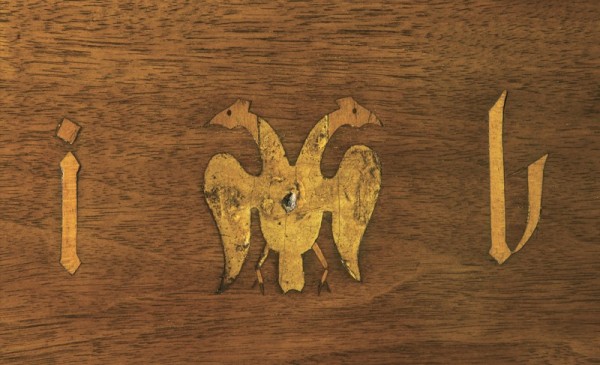
Detail of the inlay on the cupboard illustrated in fig. 189. (Photo, Gavin Ashworth.)
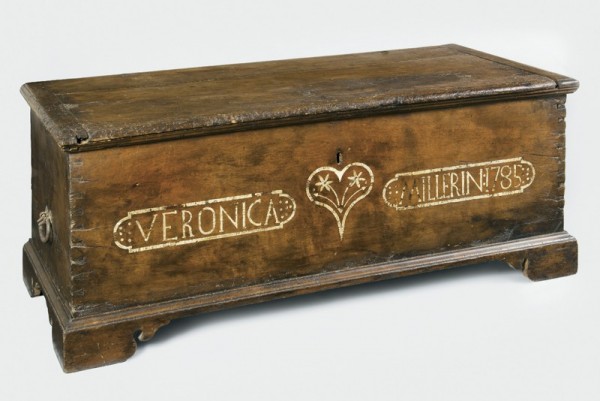
Chest, made for Veronica Miller, southeastern Pennsylvania, 1785. Walnut and sulfur inlay with tulip poplar; iron, brass. H. 20", W. 52", D. 23 3/4". (Courtesy, Clarke Hess; photo, Gavin Ashworth.) The feet and base molding are replaced; the chest used to be over two drawers.
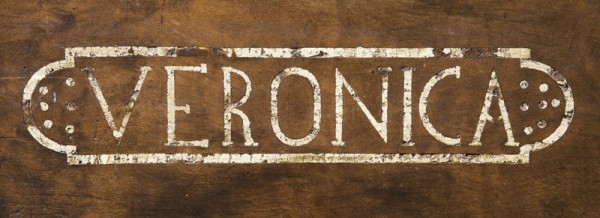
Detail of the inlay on the chest illustrated in fig. 192. (Photo, Gavin Ashworth.)
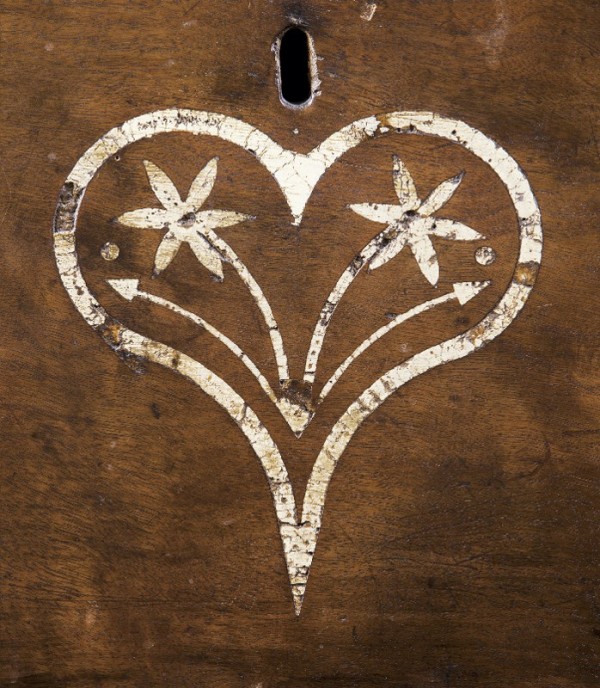
Detail of the inlay on the chest illustrated in fig. 192. (Photo, Gavin Ashworth.)
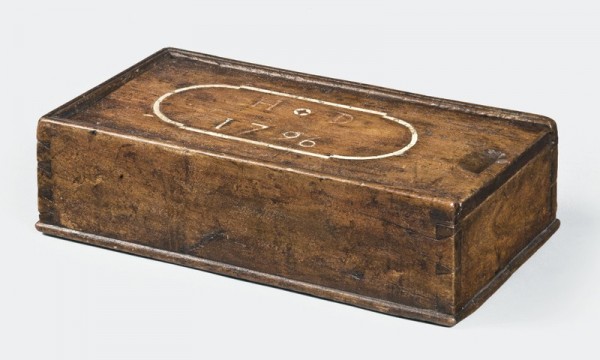
Slide-lid box, made for “H D,” probably Lancaster County, Pennsylvania, 1796. Walnut and sulfur inlay. H. 3 1/4", W. 6 5/8", D. 12". (Private collection; photo, Gavin Ashworth.)
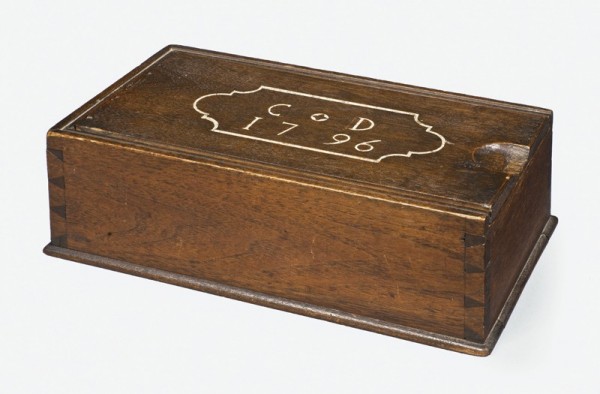
Slide-lid box, made for “C D”, probably Lancaster County, Pennsylvania, 1796. Walnut and sulfur inlay. H. 4 3/8", W. 8", D. 13 3/8". (Private collection; photo, Gavin Ashworth.)
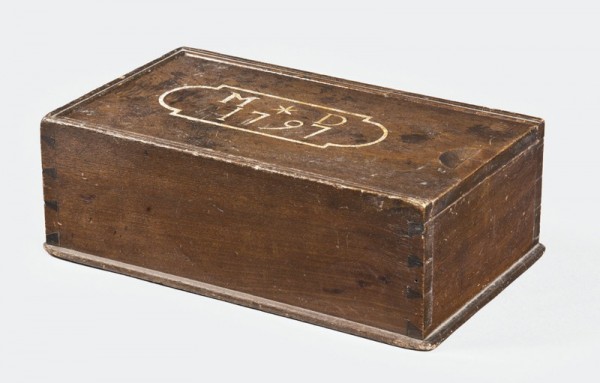
Slide-lid box, made for “M D,” probably Lancaster County, Pennsylvania, 1797. Walnut and sulfur inlay. H. 4 3/8", W. 8", D. 13 3/8". (Courtesy, Mr. and Mrs. Stephen D. Hench; photo, Gavin Ashworth.)
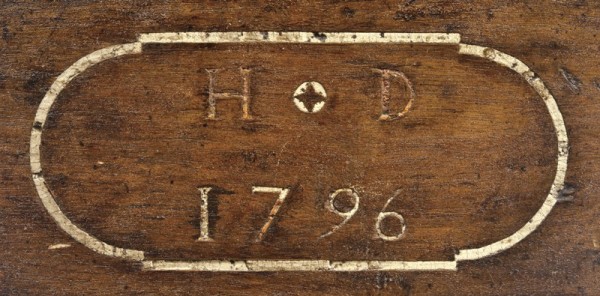
Detail of the inlay on the lid of the box illustrated in fig 195. (Photo, Gavin Ashworth.)
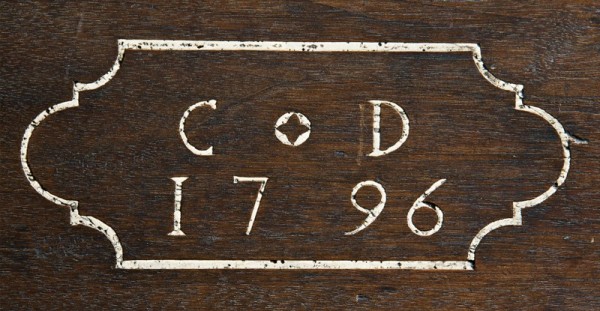
Detail of the inlay on the lid of the box illustrated in fig 196. (Photo, Gavin Ashworth.)
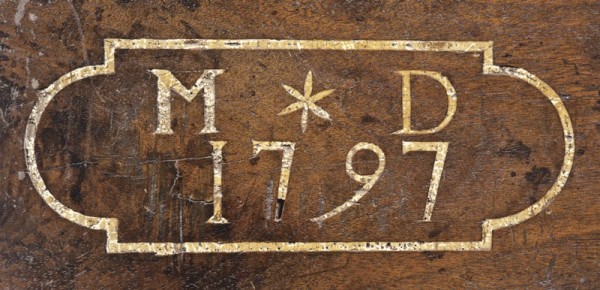
Detail of the inlay on the lid of the box illustrated in fig 197. (Photo, Gavin Ashworth.)

Chest, made for “HA BE,” possibly Lancaster County, Pennsylvania, 1768. Walnut and sulfur inlay with walnut and oak; brass, iron. H. 27 5/8", W. 48 3/4", D. 22 1/4". (Private collection; photo, Gavin Ashworth.) The feet are replaced.
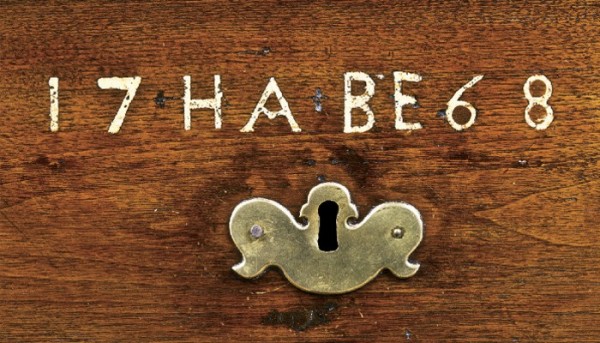
Detail of the inlay on the chest illustrated in fig. 201. (Photo, Gavin Ashworth.)
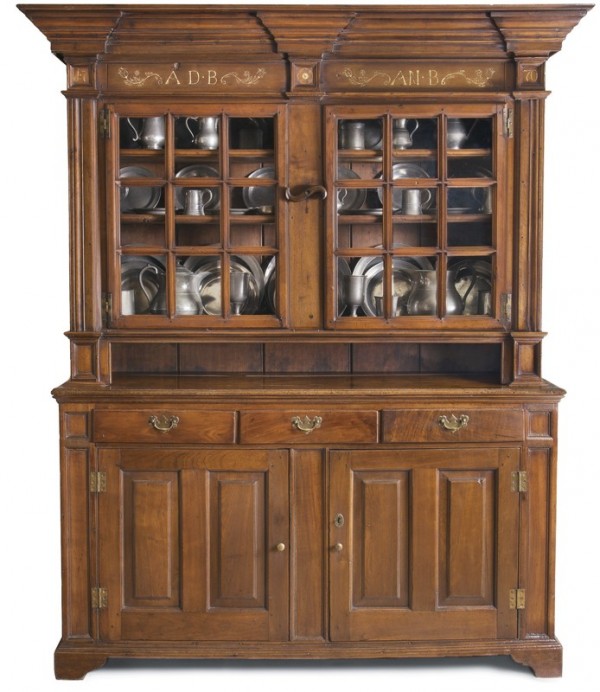
Kitchen cupboard, possibly made for Adam and Anna Brandt, Lebanon County, Pennsylvania, 1770. Walnut and sulfur inlay with pine and tulip poplar; brass, iron. H. 89 1/2", W. 76 /2", D. 20 3/4". (Courtesy, Rocky Hill Collection; photo, Gavin Ashworth.) The pie shelf section and brasses are restored.
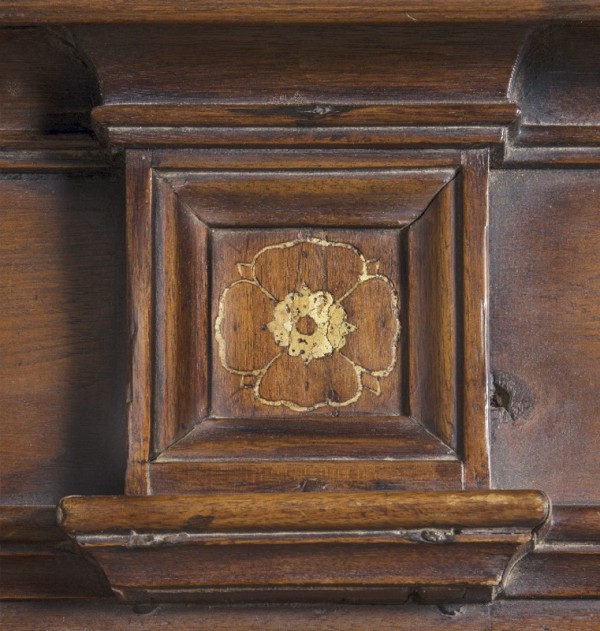
Detail of the inlay on the cupboard illustrated in fig. 203. (Photo, Gavin Ashworth.)

Detail of the inlay on the cupboard illustrated in fig. 203. (Photo, Gavin Ashworth.)

Detail of the inlay on the cupboard illustrated in fig. 203. (Photo, Gavin Ashworth.)
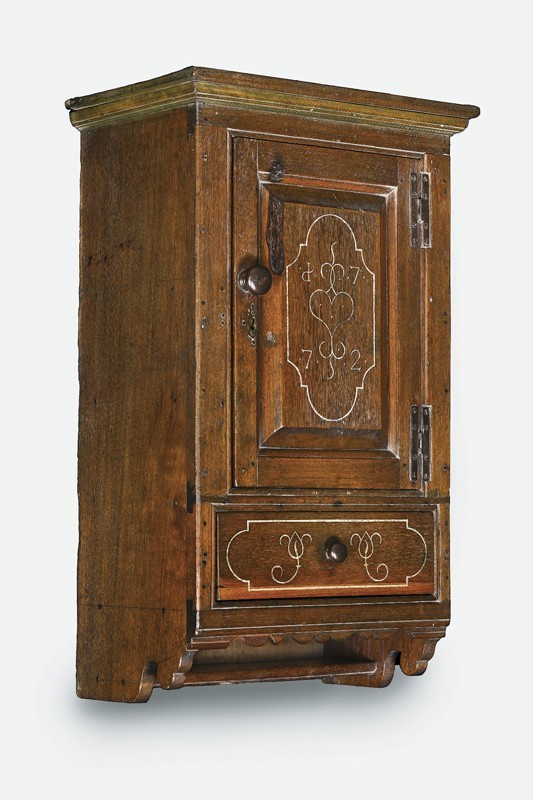
Hanging cupboard, probably Lancaster County, Pennsylvania, 1772. Walnut and sulfur inlay with pine. H. 33", W. 18", D. 11 7/8". (Courtesy, Philadelphia Museum of Art, 1953-125-9; photo, Gavin Ashworth.) The bottom lip of the drawer is replaced.

Detail of the inlay on the cupboard illustrated in fig. 207. (Photo, Gavin Ashworth.)
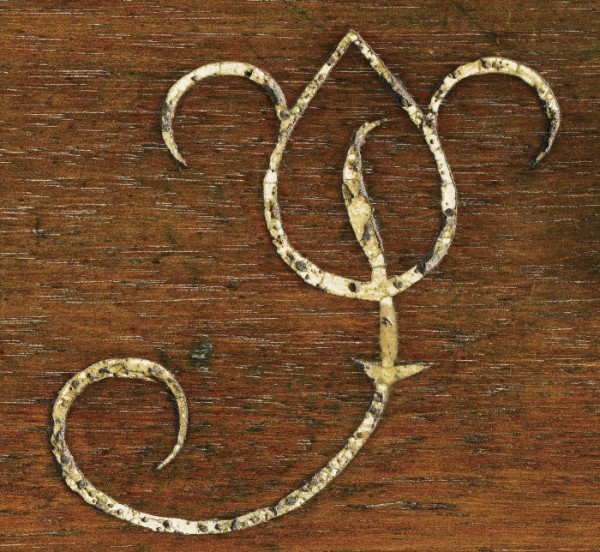
Detail of the inlay on the cupboard illustrated in fig. 207. (Photo, Gavin Ashworth.)

Tall clock, made for “J.K.,” movement signed by George Hoff, probably Lancaster County, Pennsylvania, 1774. Walnut and sulfur inlay with tulip poplar. H. 86 3/8", W. 20", D. 10 1/8". (Courtesy, Philip H. Bradley Co.; photo, Gavin Ashworth.) The feet are replaced and the inlay is restored.
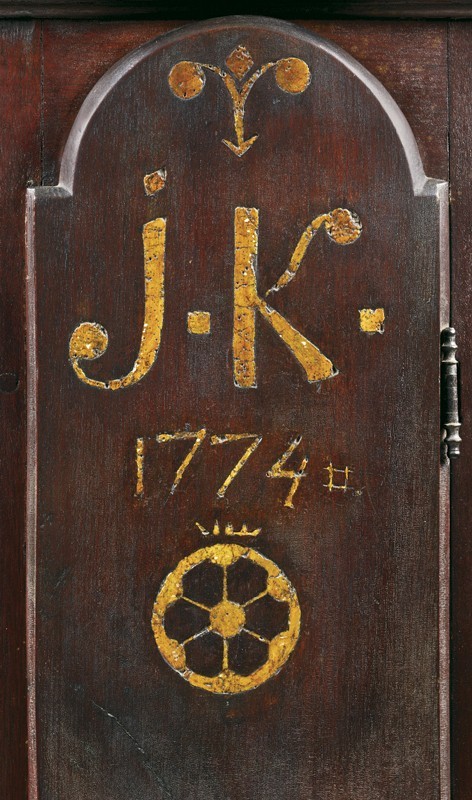
Detail of the inlay on the clock illustrated in fig. 210. (Photo, Gavin Ashworth.)

Tall clock, made for “H.S.,” movement signed by Jacob Gorgas, Ephrata, Lancaster County, Pennsylvania, ca. 1790. Walnut and sulfur inlay with tulip poplar. H. 95 1/2", W. 23 1/2", D. 12 3/4". (Private collection; photo, Gavin Ashworth.)
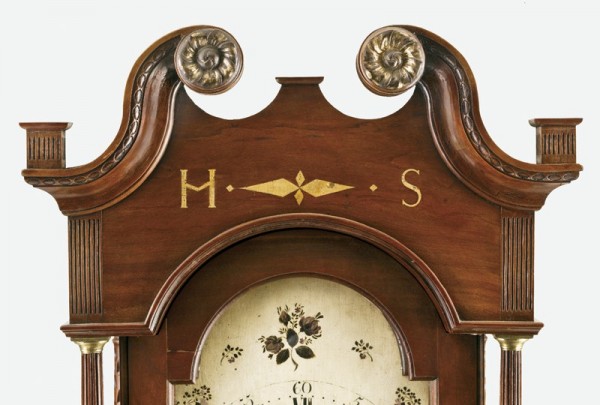
Detail of the inlay on the clock illustrated in fig. 212. (Photo, Gavin Ashworth.)

Table, possibly Lancaster County, Pennsylvania, ca. 1790. Walnut and sulfur inlay; brass. H. 30", W. 41", D. 29 1/2". (Courtesy, Carl and Yvonne De Paulis; photo, Gavin Ashworth.)
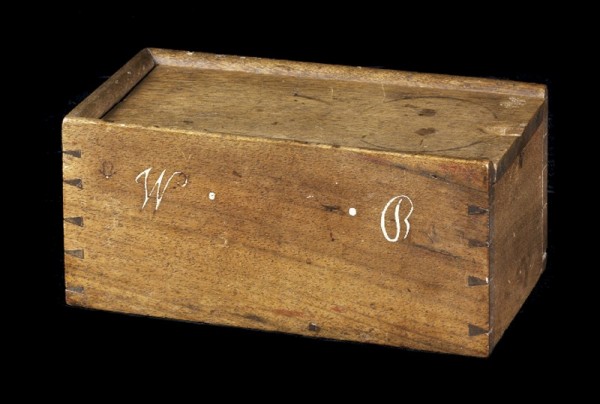
Slide-lid box, made for “W B,” probably Lancaster County, Pennsylvania, ca. 1790. Walnut and sulfur inlay with pine. H. 5", W. 11 3/4", D. 5 7/8". (Courtesy, Rocky Hill Collection; photo, Gavin Ashworth.)

Box with drawer, made for “M E,” probably Lancaster County, Pennsylvania, 1799. Walnut, sulfur inlay, and mixed-wood inlay with tulip poplar; brass. H. 9 1/4", W. 18", D. 8 3/4". (Courtesy, Rocky Hill Collection; photo, Gavin Ashworth.)
In December 1929 antiques dealer Hattie Brunner of Reinholds, Lancaster County, Pennsylvania, wrote to Henry Francis du Pont offering an enticing object for sale:
Am enclosing photo of a miniature chest which I bought last week, out of the original family, who had cherished it all these years, always kept it stored in a large chest, is in wonderful condition for the age. A unique piece. Dated 1773 made by Johannes Mosser who was one of the first settlers in this section. Was a shoe maker by trade. The old lady that owned it gave me the whole history of the piece . . . . It was inlaid with the same old putty as that walnut Kass [schrank] I sold you this spring. Will send it on approval if interested.
Du Pont complained about the $1,000 asking price but bought the chest anyway (figs. 1, 2). What neither he nor Brunner realized was that the “putty” inlay on the chest and schrank (see fig. 34) was in fact sulfur—a material used by Pennsylvania German craftsmen in southeastern Pennsylvania from at least 1763 to 1801 and for several decades later in the South. For years this inlay was described as putty or wax, as Frances Lichten claimed in 1960 when she wrote that it was made of “humble substances: powdered white lead and beeswax” and referred to the technique as Wachseinlegen or wax inlay. It was not until analytical work was undertaken in the 1970s at the behest of Smithsonian curator Monroe Fabian that the inlay was correctly identified as sulfur. In Fabian’s 1977 article on the subject, he claimed to have located twenty-two examples of sulfur-inlaid furniture. Subsequent work by Clarke Hess later identified many more pieces owned by Mennonite families in Lancaster County. Analytical work by Mark Anderson and Jennifer Mass at Winterthur Museum has also yielded new insights into the materials and techniques of making sulfur inlay. More than 125 examples of sulfur-inlaid furniture can now be documented from Pennsylvania, as well as from Maryland, Virginia, and North Carolina; they range in date from 1763 to 1844. The majority are chests, tall clocks, and schranks; other known forms include slide-lid boxes, miniature chests, corner cupboards, hanging cupboards, kitchen cupboards, tables, a slant-front desk, and even a straightedge.[1]
Brunner’s letter typifies some of the other challenges that have plagued efforts to research sulfur-inlaid furniture. Although she claimed to have acquired the miniature chest out of the “original family” and to have its “whole history,” no further information was ever provided to du Pont. Like so many other objects, the chest lost its provenance once it was removed from the family in which it had descended. Thankfully, many pieces of sulfur-inlaid furniture include the owners’ names, or at least initials, and dates that offer clues as to their points of origin. Based on this information, sulfur inlay can now be documented in Lancaster, Lebanon, Dauphin, and York counties, Pennsylvania (fig. 3). The following article is an attempt to reconstruct the origins of the various major groups as well as individual examples of Pennsylvania German sulfur-inlaid furniture. In many cases, the owners’ names are unique or sufficiently unusual that they can be identified with certainty. In other cases, especially for those pieces bearing only initials, educated guesswork must be used to make tentative identifications. Depending on the level of certainty, this article will use the modifiers “probably” or “possibly” to indicate when attributions of ownership or maker are less than certain.
In the case of the miniature chest acquired by du Pont, the presence of an owner’s name, “Johannes Mosser,” and the date 1773 inlaid on the lid provide a starting point for investigation. Brunner’s letter also claims that Mosser was “one of the first settlers in this section,” implying that he lived somewhere near her antiques shop in Reinholds, located in West Cocalico Township, Lancaster County, near the Lebanon County border. Armed with this information, a search of local church records offers some promising leads. A Johannes Mosser/Moser is mentioned numerous times in the baptismal records of John Waldschmidt, a German Reformed minister who served in the Cocalico region from 1752 to 1786. In 1780 and 1782 Johannes Moser and his wife, Anna Elisabeth, served as baptismal sponsors; on both occasions she is identified as the daughter of Christian Eschelman. In 1785 Johannes and Anna Elisabeth had a son, Johannes Jr., baptized by Waldschmidt. Waldschmidt also confirmed a Johannes Mosser (possibly the same one) in 1775 at the Cocalico church “at Michael Amweg’s” (the German Reformed congregation also known as Little Cocalico or Swamp, located in what is now West Cocalico Township). Given the close proximity of this church to the Reinholds area in which Brunner’s shop was located and her claim that Mosser had lived locally, it is probable that this Johannes Mosser was the original owner of the box.[2]
European Origins: Ivory, Orpiment, and Metallurgy
Before turning to examine the use of sulfur inlay in Pennsylvania German furniture, some investigation of the European origins of this decorative technique is needed. The contrast of light and dark was one of the foremost design concepts of the baroque era. At the same time, exotic materials such as ebony and ivory were becoming increasingly accessible to Europeans. During the seventeenth and eighteenth centuries, elaborate furniture in which light-colored inlay was used in contrast with dark woods became fashionable. Possibly as a less expensive alternative to such precious materials, arsenic sulfide, or orpiment, was also used to achieve a similar visual effect. Although highly toxic, orpiment was used for medicinal purposes, to remove hair from hides as part of the tanning process, and as a gold-colored pigment for paint and sealing wax. Formed by the crystallization of sulfurous gases emitted from volcanic fumaroles, orpiment was especially prevalent in Italy, home to the only active volcanoes in mainland Europe. Several examples of Italian furniture inlaid with orpiment have been identified, including a Venetian prayer bench and a small Bolognese chest dating to the mid-1500s (figs. 4, 5). Mining sulfur ore was once very common in Italy, especially in Sicily, but also in places such as Naples, Campania, Formignano near Cesena (mined for nearly 500 years), and Perticara near Novafeltria (mined from about 1741 to 1964). In 1864 it was estimated that there were 615 sulfur mines in Italy, of which 237 were abandoned because their ore was already extracted. During that time Sicily’s mines alone produced more than 157,000 tons of sulfur per year.[3]
Sulfur has long been used in a variety of trades, especially metalworking. Its properties of melting at a relatively low temperature (about 240°F) and hardening to a solid, yellowish material would have been widely known to craftsmen. Sulfur was also used for bleaching wool, silk, and even hair and was an essential ingredient in gunpowder. Numerous references to sulfur in newspaper advertisements, diaries, and probate inventories reveal that the mineral was commonly available in southeastern Pennsylvania during the 1700s. In 1746 the Pennsylvania Gazette ran an advertisement from two Philadelphia merchants offering for sale “just imported” fabrics, buttons, sewing supplies, pigments and dyestuffs including “red lead, white lead, Spanish brown, Spanish whiting, madder, ground redwood, allom, copperas, brimstone, sulphur, saltpetre, hammers, augers, files, gimlets” and various types of locks. In 1769 weaver George Michael Kettner of Tulpehocken Township, Berks County, had “brimstone” or sulfur listed in his estate inventory. Daniel Hiester Sr. of Berks County owned a “half Barrel with a quantity of Brimstone” valued at £3 when he died in 1795. Sulfur is also mentioned several times in the journals of Lutheran minister Henry Muhlenberg of Philadelphia and Montgomery County, Pennsylvania. In 1777, Muhlenberg reported with skepticism that his wife Anna Maria took a “mixture of molten sulphur and steel” in an attempt to treat her epileptic condition. “One takes a piece of raw sulphur and a piece of glowing steel,” Muhlenberg noted, “the two are held over a pan of water and allowed to drip in; afterwards it is made into a fine powder. Now and then an amount that can be placed on the point of a knife is taken with honey or molasses.” He also recorded purchases of sulfur, paying 3s. 9d. in 1777 for a half-pound of sulfur and 1s. 3d. “for steel to strike fire and for sulphur sticks.” In all likelihood, Pennsylvania German cabinetmakers turned to sulfur inlay as a less expensive and more readily available substitute for ivory or orpiment. Once the sulfur was inlaid into a native wood such as black walnut or cherry, it provided a similar light and dark effect. Given that it was inlaid in a molten state with the excess simply scraped away after it cooled, sulfur inlay also saved time. And unlike orpiment, sulfur inlay was not toxic.[4]
The technical process for using molten sulfur as an inlay is rooted in metalworking. A brief survey of early metallurgical publications reveals numerous German and Italian sources. Studies by German scholars were especially prominent due in part to the prevalence of ore deposits and mining in Germany; there was also significant pressure to develop new metalworking techniques due to the influx of metals from South American mines after 1492. One such early metallurgical manual, Das Bergbüchlein (Augsburg, 1505), explains how to locate and work veins of ore. A 1556 study by Georg Bauer (also known as Georgius Agricola), De re metallica (On the Nature of Metals), focused on mining, assaying, and smelting; it also includes a section on purifying sulfur that was derived in large part from the earlier and highly influential book De la pirotechnia, first published in Venice in 1540 and illustrated with dozens of woodcuts depicting various aspects of metalworking. A direct link between Pennsylvania German sulfur inlay and European metallurgy can also be established through the Pirotechnia, which very likely served as the design source for the fleur-de-lis motif that is a particular hallmark of the earliest known examples of sulfur-inlaid furniture, made during the 1760s and 1770s in Lancaster County, Pennsylvania. Although the fleur-de-lis motif is often associated with the French, leading some to speculate that the furniture’s owners or makers were French Huguenots, most of the owners were in fact of Swiss-German Mennonite heritage. However, the fleur-de-lis was also a popular motif in Italy. Best known as the symbol of the city of Florence, the fleur-de-lis was also used in papal crowns and by the doges of Venice and dukes of Parma. The title page of the 1559 edition of De la pirotechnia—which was printed in Venice—features three large fleur-de-lis motifs nearly identical to those inlaid in sulfur and carved on Lancaster County furniture more than 200 years later (figs. 6-8).[5]
The earliest known European manual on metallurgy, the Pirotechnia was written by Vannoccio Biringuccio (1480–ca. 1539), who is often considered the father of the foundry industry. A native of Siena, Biringuccio was appointed head of the papal foundry and director of munitions in 1538. The treatise is divided into ten books on topics such as minerals, assaying, smelting, separating gold from silver, alchemy, and the art of casting metals. Book 2 contains a chapter on sulfur, which begins with the statement “Sulfur is a very well-known mineral” and then describes how to purify sulfur ore by heating it in ceramic vessels with a spout near the top, through which the sulfur is distilled by means of ceramic tubes into a second vessel. After applying a “good and powerful flaming fire” to the vessels containing the crude ore, Biringuccio writes that the “substance that is in the ore . . . passes like a smoke through the tubes, thickens there and becomes sulphur; when it becomes like melted wax, it falls to the bottom. If the master wishes, he causes it to run out as it forms . . . to form a cake or else it is poured into tubes of cane, wood, or terra cotta.” He ends the chapter: “To conclude: As I told you, sulphur melts and by means of its fusion one can mould any desired object from it as if it were plaster of Paris, wax, or melted metal.” There is also a short chapter on arsenic and orpiment that describes them as a “most powerful poison to the life of all things” and advises against using them “except by force of necessity.” Although it is not certain exactly how Lancaster County craftsmen would have accessed this manual, it is possible that a copy was in the collection of the Lancaster Library Company, established in 1759 and renamed the Juliana Library Company in 1763. In 1766, the library moved to the home of the Moravian gunsmith William Henry (1729–1786). As a gunsmith, inventor, patron of the arts (including the painter Benjamin West), and member of the American Philosophical Society, Henry is a likely person to have owned a copy of the Pirotechnia (fig. 9). He is known to have had an extensive personal library at the time of his death in 1786. Even if Henry could not read Italian, the dozens of woodcuts showing various aspects of metalworking would no doubt have been useful.[6]
Lancaster County
The use of sulfur-inlaid decoration on Pennsylvania German furniture appears to have originated in Lancaster County. The earliest known dated example is a schrank made in 1763 for Christian and Veronica Herr; the latest known is a chest dated 1801 (see figs. 19, 98). The majority of Lancaster County sulfur-inlaid furniture can be divided into one of three major groups. The earliest group, dating to the 1760s and 1770s, includes at least fifteen tall clocks, schranks, and chests decorated with varying combinations of sulfur, mixed wood, pewter, and even bone inlay. Common design elements include fleur-de-lis motifs and heart-shape, foliate cartouches that frame the owners’ names or initials and dates; some pieces also have crossbanded wood inlay in geometric shapes. Highly sophisticated in their design and execution, these pieces were probably made in the county seat of Lancaster, although the original owners lived throughout central Lancaster County. Additional sulfur-inlaid furniture was owned by some of the same families but appears to be the work of various other makers. The second group consists of a pair of chests made in or near Manheim Township in the early 1780s. The third group ranges in date from 1781 to 1801 and includes three full-size chests and a miniature chest, tall clock, stretcher-base table, and straightedge ornamented with floral and bird motifs, dates, and initials.
The Pequea and Conestoga Settlements
One of the earliest settlements in what is now Lancaster County was founded by a small group of Swiss-German Mennonite families about 1710, when some 10,000 acres was warranted to Hans Herr, Christian Herr, Martin Kindig, Jacob Miller, Martin Oberholtzer, John Funk, Hans Graff, Wendell Bauman, Martin Mylin, Christopher Franciscus, and Michael Oberholtzer. The land was located in the Pequea Valley of what was then western Chester County. In 1719 Christian Herr, a Mennonite bishop, built a substantial stone house that also served as a meetinghouse until 1849 (fig. 10). The Conestoga settlement soon grew to such an extent that in 1729 the inhabitants successfully petitioned the legislature to establish a new county. The county seat, also known as Lancaster, was laid out in 1730 some ten miles east of the Susquehanna River, near the Conestoga Creek. In 1742 the town of Lancaster was officially incorporated as a borough; it did not assume the legal status of a city until 1818 (this article will use the term “Lancaster” to denote the town/borough). Despite its English name, Lancaster was a predominantly German-speaking locale from the very start. Seventy-five percent of the lot holders in 1740 were Germans; in 1759 about 67 percent of the town’s population was German and in 1789 about 63 percent was German. Within twenty years of Lancaster’s founding there were 311 taxpayers, and by 1775 its population was approximately 3,288—making Lancaster the largest inland town in America at the time. As the town prospered, its architectural landscape also became increasingly sophisticated. From 1761 to 1766 the Lutheran congregation built a large brick church, Trinity Lutheran, and in 1794 they added a steeple tower adorned with statues of the four evangelists. In 1787 a new brick courthouse was completed, which also served as the Pennsylvania State House when Lancaster was the state capital from 1799 to 1812 (fig. 11).[7]
Early Lancaster Furniture
Lancaster’s German-speaking inhabitants included many talented woodworkers as well as affluent consumers who demanded furniture of the best sort. One of the earliest known dated objects associated with Lancaster is an extraordinary tall clock made in 1745 for Andreas Beierle (Andrew Beyerle) and his wife Catharina (figs. 12-14). Adorning the hood are two finials in the shape of reclining putti or cherubs, while the pendulum door is carved with a baroque floral design and symbols representing Beierle’s trade as a baker: a pretzel and loaves of bread. Born in Rohrbach im Kraichgau, Germany, in 1713, Andreas immigrated in 1738 and settled in Lancaster by 1743, when he and his wife served as the sponsors for two baptisms at Trinity Lutheran Church. His training as a master baker in Europe would have included mold carving (necessary for making gingerbread, marzipan, and various fancy pastries), and thus it is possible that Andreas did some of the carving on the clock case himself. In 1754 Andreas and his family moved to Westmoreland County, Pennsylvania; he served as a baker for the army during the French and Indian War and died in 1781. The same person who carved the floral designs on the clock case probably also executed the ornament on an undated paneled walnut chest and a fireplace mantel with a central plaque dated 1746, flanked by rampant lions (fig. 15).[8]
Another early and impressive example of Lancaster-made furniture is a schrank with the pewter inlaid inscription “MF AMF ANNO 1758” (fig. 16). The original owners were probably Michael Fordney (Fortineux) and his wife Anna Margaretha Freuler of Lancaster. Of French Huguenot heritage, Fordney was born in 1714 in Landstuhl in the Palatinate. He immigrated in 1737 together with two of his brothers; their parents and several more siblings joined them by 1742. Michael was a butcher by trade and rented a stall in the Lancaster market house during the 1750s. His father-in-law, Jost Freuler, was Swiss and a gunsmith by trade. Freuler, his wife, and seven children emigrated from Germany to Pennsylvania in 1738, and by 1740 he was an active member of Lancaster’s First Reformed Church. Between 1754 and 1762 four of Michael and Anna Margaretha Fordney’s children were baptized at First Reformed Church, and in 1769 Michael became a trustee. In his will, Michael left detailed instructions for the distribution of his two town houses, several plots of land, and a brick house and property in Manheim. Michael died in 1778, survived by his widow and three children: Casper, Henry, and John. A great-nephew, Melchior Fordney (1781–1846), was a famous gunsmith in Lancaster prior to his grisly murder at the hands of an axe-wielding religious fanatic. Two years after the Fordneys’ pewter inlaid schrank was made, Johannes and Anna Maria Spohr of Lancaster received a schrank of similar form but embellished with relief-carved floral decoration and baroque inlay on the two doors (fig. 17). Born in 1725, Johannes was thirty-five years old when the schrank was made. His oldest child, John George Spohr, was born in 1749 and baptized at First Reformed Church in Lancaster.[9]
During the 1770s and 1780s Lancaster woodcarvers also produced some of the most sophisticated carved rococo furniture made outside of Philadelphia. One of the most elaborate pieces is a mahogany high chest that was owned by Matthias Slough of Lancaster (fig. 18). A wealthy tavernkeeper and elder at Trinity Lutheran Church, Slough also served as the Lancaster County coroner (1754–1769), and as a member of the Pennsylvania Assembly (1773–1776 and 1783–1784). He was also the largest slaveholder in the borough, with five enslaved servants in his possession in 1782. Profuse, relief-carved foliate designs cover the tympanum and skirt of Slough’s high chest, carved from the solid wood in the Germanic manner rather than made separately and applied. During the 1760s and 1770s several of Lancaster County’s iron furnaces also cast five- and six-plate stoves using rococo patterns carved by Philadelphia artisans. These and other objects provide a broader context for the study of Lancaster County furniture, especially the earliest group of sulfur inlay, which in all likelihood was made in the borough of Lancaster.[10]
Early Lancaster County Sulfur-Inlay Group
The earliest and largest group of sulfur- and related inlaid furniture made in Lancaster County includes more than twenty objects, consisting of schranks, chests, and clocks. Variations within the group—such as the occasional use of pewter inlay, bone inlay, and crossbanded geometric designs—suggest that several craftsmen or workshops may have been involved in the production of this furniture. The following survey of this group is arranged primarily by form and then chronologically within each category to facilitate comparisons among like types of furniture.
Schranks
During the 1760s and 1770s at least five walnut schranks with sulfur inlay and carved fleur-de-lis motifs were made by the same unknown craftsman for couples living in central Lancaster County (figs. 19-21). A sixth example is neither inlaid nor dated but has carved fleur-de-lis motifs and is otherwise nearly identical (fig. 22). As discussed above, the design source for this motif is almost certainly the title page of the 1559 edition of De la pirotechnia (see fig. 6). The maker of the schranks used a small, star-shape punch to mat the ground surrounding the relief-carved fleur-de-lis motifs (fig. 23). A similar technique was used on both German furniture and architectural woodwork, as seen in the paneled door of a 1730s building in Hildesheim, Germany (fig. 24). Many of the schranks’ original owners lived in Manor or Hempfield townships (the latter divided into West and East Hempfield townships in 1817), where a log meetinghouse was constructed in about 1740 by the local Mennonite community (fig. 25). Although the Mennonites are known for their use of plain clothing, humble speech, and spare meetinghouses rather than ornate churches, their furniture was often quite elaborate—especially the fine walnut schranks embellished with sulfur-inlaid decoration.[11]
Like most Pennsylvania German schranks, the examples in this group were made to disassemble into pieces. A distinctive feature of this group is that the sections are held together by wrought iron hooks rather than wedged tenons (fig. 26). Otherwise the schranks display typical Germanic construction techniques, including the use of pegged up drawer bottoms and wedged dovetails. On the interior, shelves for storing folded linens are usually located on the left and wooden pegs for hanging clothing on the right. Some of the schranks also have secret compartments hidden between the drawers. On occasion, one of the drawers is divided into smaller compartments. The drawers are constructed of hefty stock, often a full inch in thickness, and some use walnut for the drawer sides. The schrank doors hang on castle-type hinges, made of either iron or brass. On all of the schranks, the husband’s name or initials is inlaid on the upper left door panel and the wife’s name or initials on the upper right. The inscriptions also include an exact date (month, day, and year), although the placement of the dates varies; on some schranks the year is on the left and the month and day on the right, and on others just the opposite occurs. Contrary to popular misconceptions, schranks were usually not made for newlyweds but rather for well-established couples. The inlaid dates do not correspond to marriage dates but in all likelihood are the dates of the schranks’ completion or presentation. The amount of inlaid and carved decoration varies from piece to piece, with some examples being significantly more elaborate than others. Another variable is the presence of a center foot; the earliest schrank, dated 1763, never had one (see fig. 19) but the other four do.
The earliest known example of sulfur-inlaid furniture made in America is the schrank dated April 7, 1763, and inscribed for Christian and Veronica Herr (see fig. 19). The upper left panel bears Christian’s name and the year 1763 framed within a foliate cartouche; the upper right panel contains Veronica’s name, the date April 7, and a pair of small birds and a winged angel head above and below the cartouche. This schrank was probably made for Christian Herr (d. 1811) and his first wife, Veronica Bachman; after her death Christian married Catharine Eyeman (d. 1831). Christian Herr lived in Manor Township and owned a sawmill; in his will of 1811, he bequeathed “one wild cherry clothespress with all the contents thereof” to Catharine as well as three feather beds, a chest, a kitchen dresser and its contents, and £1,000 in gold or silver specie. In an earlier will, written in 1796 but never recorded, he bequeathed to Catharine “my Cloths Press standing in the upper story of my House” along with three beds, a kitchen dresser, and a house clock. Of particular note is that he also bequeathed “unto the said Emanuel Herr Junior my Clothes Press standing in my chamber” along with a ten-plate stove and a dining table of cherry wood. Given that Christian Herr owned a sawmill and identified certain pieces of furniture as being made of cherrywood, it is unlikely that he would have confused the wood of the schrank. Thus, the schrank he bequeathed in the 1796 will to Emanuel Herr Jr. (his nephew) was in all likelihood the sulfur-inlaid walnut schrank, which was transferred to Emanuel prior to Christian’s death in 1811 and thus not mentioned in his last will and testament. It remains in the possession of Herr family members to this day.[12]
The next schrank in the group bears the date March 1, 1766, and the names “IH KAUFFMANN” and “AN KAUFFMANNIN” (figs. 27-29). In all likelihood, the original owners were Johannes and Anna Kauffmann; the “–in” at the end of Anna’s surname is a German feminine suffix used on women’s surnames, both married and unmarried. The schrank also bears the name of a later owner, “C. L. Nissly,” and the date 1949 on the top, as well as the inscription “C.L. Nissly, 255 Marietta Pk., Mt. Joy PA.” written on the side of a drawer. Closely related in overall form and decoration to the 1763 Herr schrank, the Kauffmann schrank is further embellished with inlaid geometric designs on the lower door panels (fig. 30). John Kauffmann married Anna Shwahr/Schwar, who was probably the daughter of Christian Shwahr Sr. (d. ca. 1784) of East Hempfield Township. Either Christian Sr. or his son Christian Jr. (d. 1807) was the original owner of a sulfur-inlaid tall clock, dated January 18, 1766—a little over a month before the date on the schrank (see fig. 63). In 1775 John Kauffmann and Abraham Reist (owner of the schrank illustrated in fig. 38) served as co-executors of the estate of Jonas Nolt of Hempfield Township. Various John Kauffmanns were named as sons in the wills of Christian Kauffmann (d. 1798), Christian Kauffmann (d. 1806), and Jacob Kauffmann (d. 1812), all of Manor Township, and of Christian Kauffmann (d. 1816) of Hempfield Township.[13]
The third schrank is more restrained in its ornament. It retains the fleur-de-lis carving in the corners of the raised panel doors but lacks the sulfur-inlaid cartouches and bears only the date—February 27, 1767—and the initials “P BM” and “M BM” (figs. 31-33). The original owners have been identified as Peter Bachmann (1725–1782) and his wife Maria of Manheim Township, Lancaster County; a walnut schrank was listed in the inventory taken at Peter’s death. Of Swiss Mennonite heritage, Peter married Maria/Mary Kauffman (ca. 1736–1805), daughter of Jacob Kauffman Sr. of Hempfield Township. In 1781, Peter Bachmann and his brother-in-law, Jacob Kauffman Jr., served as co-executors for the estate of Benjamin Eshelman (brother of Jacob’s wife, Barbara Eshelman) of Hempfield Township.[14]
The fourth and most elaborate of the schranks in this group is dated February 17, 1768, and inscribed for Emanuel and Mary Herr (figs. 34-36). Like the 1766 Kauffmann schrank, it has sulfur-inlaid geometric designs in the lower door panels. The inlay in the upper door panels is slightly different, however, as the cartouche framing Emanuel Herr’s name is topped by a figure of a large parrot eating a tulip. This schrank is also the only one of the group that has an interrupted cornice—a more sophisticated architectural treatment—and relief-carved medallions flanked by turned, engaged columns in the base (fig. 37). The original owners were Emanuel Herr (1745–1828) and his wife Mary. Although most schranks were made for well-established couples rather than newlyweds, this one is an exception since Emanuel Herr was only twenty-three when it was made. Family circumstances likely explain this anomaly, as Emanuel’s father Christian Herr (1720–1763) died when he was only forty-three, and his children consequently received their inheritance at a younger-than-normal age. Emanuel Herr’s sister, Maria, married John Bachmann, brother of the Peter Bachmann for whom the schrank illustrated in figure 31 was made.[15]
Following the 1768 Herr schrank, there is a gap of seven years before the manufacture of the schrank dated March 8, 1775, and inscribed for Abraham and Elisabeth Reist of Warwick (now Penn) Township, Lancaster County (figs. 38-42). Of similar overall form to the previous examples, the Reist schrank has the fleur-de-lis carving but the sulfur inlay is greatly simplified, consisting of small six-point stars, diamonds, and hearts rather than the foliate cartouches, parrots, and winged angel heads. The schrank was commissioned by the Reists to furnish their new home, a large stone house built in 1774 on what is now Fruitville Pike. Abraham Reist (1737–1813) married Elisabeth Kauffman (1739–ca. 1780); her brother John Kauffman owned a sulfur-inlaid schrank made in 1764 (see fig. 99). His second wife was Elisabeth Metz (1739–1810). Abraham lived on the upper tract of his father Peter Reist’s farm in Lancaster County, where Abraham became a wealthy farmer and distiller. He also acquired extensive landholdings in Waterloo Township, Ontario, where the couple’s eldest son, John Reist, later settled. In 1786 Abraham and Elisabeth’s daughter, Elisabeth Reist (1769–1847), received a painted chest prior to her marriage to John Schwar; the vertical dividers between the two drawers echoes the so-called linen fold panel common on many Lancaster County schranks.[16]
Chests
Two painted chests and three sulfur-inlaid chests are related to this group of schranks. The painted chests, which are built out of pine, have engaged quarter columns and carved fleur-de-lis motifs in the corners of the raised panels on the façade and, in the example built over drawers, on the ends (figs. 43-45). Although both chests have been repainted, traces of the original red, white, and blue palette remained on both examples prior to restoration. The chest over drawers also has elaborate wrought iron hinges with pierced terminals (fig. 46). On the three sulfur-inlaid chests, fleur-de-lis motifs project from both sides of the cartouches, echoing the carved versions on the schranks. The earliest example is dated 1765 and bears the initials “M K” (figs. 47, 48). The owner has been identified as Michael Kauffman (1745–1816), youngest child of John Kauffman (ca. 1700–1759) and Anna Bamberger, whose farm lay adjacent to the Landisville Mennonite Meetinghouse in East Hempfield Township (see fig. 25). The year after he received the chest, Michael Kauffman married Veronica Berg (1746–1813), daughter of Mennonite émigré Andrew Berg. Michael inherited a 220-acre plantation at the age of twelve; he became a farmer and also a physician.[17]
The next chest, which is virtually identical, is dated 1766 and bears the initials “D W” (figs. 49, 50). It is constructed almost entirely of walnut, including all visible parts of the till compartment. The till has a false bottom; by pulling up on the front board of the till, a shallow compartment with drawer is revealed. Written on the bottom of the drawer is the name of a later owner: “John C. Sadler Hopewell Township York Co. Pa.” A probable candidate for the original owner is Daniel Wolf; his father John Nicholas Wolf emigrated from Germany in 1738, married Anna Maria Bower, and settled in what is now East Hempfield Township, where he died in 1771. Daniel Wolf was born on August 25, 1752, and baptized on September 22 at First Reformed Church in Lancaster; five of his siblings were also baptized there between 1754 and 1769. A store- and tavernkeeper, Daniel Wolf founded the town of East Petersburg, Lancaster County, in 1812. Other surnames beginning with W listed on the 1758 tax assessment for Hempfield Township include Weller, Whitman, Welty, Walter, Whitmore, Wagoner, Wright, Weaver, Waltz, and Weldy.[18]
The third chest is the most elaborate example of the 1760s group. It is dated 1768 and inscribed with the initials “I D” (figs. 51, 52). The only surnames beginning with D on the 1758 Hempfield Township tax list are Dowenbark (probably Dowbenberger), Deyeman, and Davis. In Manor Township in 1780, the surnames include Derstler, Dercher, Domini, Dunckle, and Dundore. A Johannes Dunckel, born in 1747 to Swiss émigré Melchior Dunckel (1701–1769) and his wife Anna Barbara, is one possible candidate whose initials and life dates correspond to the chest. A unique feature of this chest is the pair of mirror-image foliate framing devices that flank the central cartouche (fig. 53). The large ogee bracket feet (fig. 54) are also not found on any of the other chests or schranks, but they relate closely to the original, albeit more diminutive, ogee feet on a sulfur-inlaid tall clock made in 1765 (see fig. 61).[19]
Clocks
At least eight tall clocks are known with closely related cases (several built of cherry rather than walnut) and inlaid ornament including sulfur, pewter, and wood. The earliest example is dated 1762 and has the initials “FR ST” inlaid in pewter in the hood; bands of pewter also encircle two of the finials and additional pewter inlay is on the plinth blocks (figs. 55, 56). Within the arcs of the inlay are clearly visible compass points made by the craftsman as he laid out the design. The pewter was poured into the wood in a molten state, as evidenced by tiny areas in which it leaked beyond the confines of the incised channels. Pewter inlay is extremely rare in Pennsylvania German furniture. Other than this clock, two other clock cases (see fig. 65), and the 1758 schrank (see fig. 16), there are only two or three known examples with pewter inlay. Both pewter and sulfur have a relatively low melting point (depending on its composition, pewter melts between 338–446°F; sulfur melts at about 240°F), enabling them to be poured directly into the wood as an inlay material. The clock case (fig. 57) is inlaid with crossbanded wood strapwork in geometric designs, outlined in pewter stringing; it houses an eight-day, arched dial movement signed by Rudolph “Rudy” Stoner (1728–1769) of Lancaster. A Moravian, Stoner is one of the first documented clockmakers in Lancaster County, where he appears in the borough tax lists by 1754. He purchased a brick house just north of Center (now Penn) Square by 1760, but his life was cut short at the age of forty. The inventory of his estate, valued at £604.19.2, includes fine furniture, a clavichord and two violins, and a workshop full of highly specialized equipment—including clock- and watchmaking tools, a “Cutting Engine for Watch work,” polishing and fusee engines, clock and watch parts, and lead patterns.[20]
The pewter inlay on the clock case may have been provided by Johann Christoph Heyne (1715–1781), who, like Stoner, was a Moravian. A talented pewterer, Heyne immigrated to Pennsylvania in 1742 and worked in Lancaster from 1752 to 1781. After the death of his first wife in 1764, Heyne married Anna Regina Steinman, herself a widow who had moved from Bethlehem to Lititz in 1756 with her first husband, Christian Frederick Steinman (d. 1760). Her son John Frederick Steinman (1752–1823) likely apprenticed with Heyne; he was one of the administrators of Heyne’s estate and afterwards took over management of the metalworking business, which he developed into a successful hardware store. At the time of his death in 1781, Heyne owned dozens of pewter spoons, plates, basins, and other wares (including three “Church cups” or chalices), as well as household furnishings such as a spinet, window curtains, a twenty-four hour clock, a desk and bookcase, and several looking glasses. Heyne’s pewter shows a great deal of ingenuity and skillful craftsmanship; he made ecclesiastical vessels for Lutheran, Reformed, and Brethren congregations, for the Moravian churches in Lititz and Bethlehem, as well as a set of altar sticks for a Catholic church. The baroque style of the pewter inlay on the tall clock was an aesthetic in which Heyne was well-versed, as evidenced by the baroque form altar sticks he made for the Most Blessed Sacrament Catholic Church in Bally, Berks County (fig. 58).[21]
The original owner of this impressive clock was probably Frederick Stone (1734–1792) of Lancaster. He was born on November 4, 1734, to Ludwig and Maria Catharina Stein/Stone and baptized at Trinity Lutheran Church in Lancaster. In the year the clock was made, 1762, Frederick married Anna Maria Hambrecht/Hambright on April 12 at St. James Anglican Church in Lancaster. The clock may have been a wedding present, as Ludwig Stein went to great lengths to help his son Frederick get established. In Ludwig’s will of June 4, 1782, he left to Frederick only two English guineas because Frederick had previously received “a handsome Estate consisting of a House & other valuable Effects.” Frederick and Anna Maria had at least five children: Frederick Jr.; Ludwig, born in 1770 and baptized at Trinity Lutheran; Catharine; Susanna; and Anna Maria, who died in 1775 at age seven. From at least 1766 to 1773 Frederick rented a pew at Trinity Lutheran. His father Ludwig Stein was a wealthy innkeeper, land speculator, and staunch Lutheran. Ludwig also made business trips to Germany and on one occasion brought back a silver chalice and bowl, which he presented to Trinity Lutheran. When the Lutheran minister, Laurentius Nyberg, became a Moravian sympathizer, Ludwig led the opposition against Nyberg’s efforts to unite the congregation with the Moravians. During a heated confrontation and attempted lock-out in 1745, he shoved the pastor into the sacristy and broke down the church door. Nyberg and his supporters withdrew from the Lutheran church and established their own Moravian congregation in 1746. Despite this turmoil, Ludwig was one of the town’s leading citizens and from 1750–1751 served as the burgess of Lancaster. In 1758, Ludwig was made captain of an all-German militia company. He was also an active member of Lancaster’s Union Fire Company together with some of the town’s wealthiest residents, including Jewish merchant Joseph Simon. The detailed inventory taken after Ludwig’s death in 1782 lists an impressive assortment of fine clothing, several sets of bed curtains, two pairs of brass-topped andirons, fourteen glazed pictures, a clothes press, a walnut desk, a gilded German bible and silver-mounted psalm book, and extensive china, delft, and Queensware.[22]
Frederick Stone followed in his father’s footsteps and became a tavernkeeper and leading citizen of Lancaster. He helped to found both the Lancaster Library Company (est. 1759) and Friendship Fire Company (est. 1763). Frederick served as Lancaster County coroner from 1761 to 1762 and, in December 1763, was one of fourteen jurors selected by then-coroner Matthias Slough for an inquest regarding the brutal murder of six Indians on December 14, 1763, by the so-called Paxton Boys, a tragedy known as the Conestoga Massacre. From 1767 to 1773 Frederick served as sheriff of Lancaster County; he was succeeded in this position by John Ferree. Although he was of Lutheran heritage, Frederick Stone was one of several leading Germans in Lancaster who at least nominally joined St. James Anglican (later Episcopal) Church. Other prominent English-speaking members of St. James included George Ross, an attorney and iron forge owner, and Edward Shippen, former mayor of Philadelphia. Frederick Stone was buried at Trinity Lutheran, however, following his death on December 19, 1792.[23]
How did Frederick Stein, whose father had so zealously opposed the Lancaster Moravians, come to own a clock with a movement made by a Moravian clockmaker and a case with pewter inlay possibly supplied by a Moravian pewtersmith? Put simply, much had changed in Lancaster in the twenty years since the 1745 controversy. Under the leadership of Lutheran patriarch Henry Melchior Muhlenberg, head of the Pennsylvania Ministerium, the Lutheran church was thriving while the Moravians’ influence was on the decline following the death of leader Nicholas Ludwig von Zinzendorf in 1760. As Lancaster grew, civic organizations also arose that provided opportunities for people of different faiths to interact. A prime example of this was the Juliana Library Company (est. in 1759 as the Lancaster Library Company). Its 1763 charter includes the names of both Frederick Stone and Rudy Stoner as founding members. Matthias Slough is also listed, as is the Moravian gunsmith William Henry (see fig. 9), into whose house the library’s books were moved in 1766. As proof of how far Lutheran-Moravian relations had improved by 1782, William Henry even served as a witness to Ludwig Stein’s will.
Closely related strapwork inlay appears on a tall clock with an eight-day movement signed by Christian Forrer (1737–1783) of Lampeter, Lancaster County (figs. 59, 60). Although the case is undated, it is stylistically early and was probably made between 1754—when Christian Forrer and his brother Daniel, also a clockmaker, emigrated from Switzerland—and 1774, when Christian moved to York County. The inlaid panels on the sides of the hood mimic the approximate size and location of sidelights; the inlay on the pendulum door is a smaller version of that on the sides of the case. Whereas the Stoner clock used pewter to outline the strapwork inlay, this clock uses lightwood stringing. The clock descended in the Eaby family of Leacock Township, Lancaster County; the pendulum is engraved “Jacob Eaby 1799 / Jason K. Eaby 1907.” The first name probably refers to Jacob Eaby (1776–1842), who married Susanna Miller in 1799. He was the youngest son of Jacob Eby (1728–1794) and Hannah Laeder (1733–1810), who were probably the first owners of the clock. Jason K. Eaby was born in 1845 to Moses Eaby (son of Jacob Eaby) and Susanna Kurtz.[24]
The next known dated clock was made in 1765 and houses an elaborate eight-day movement that is signed on the face “Rdlph Stoner / Lancaster” and includes a moon-phase dial, a second-hand dial, and a date aperture (figs. 61, 62). The ogee feet, turned finials, and pierced valance of this monumental tall clock are entirely original. The hood is ornamented with a bold, triple interrupted cornice and relief-carved tulips at either side—executed from the solid wood in the Germanic style rather than carved separately and applied—and a central carved rosette identical to that on the 1768 Herr Schrank (see fig. 37). The date and the name of the original owner, Peter Ferree (b. ca. 1730) of East Lampeter Township, Lancaster County, are inlaid in sulfur. Of French Huguenot ancestry, Peter was the great-grandson of Mary Ferree, a widow who in 1712 became one of the first settlers in the Pequea Valley. When Peter Ferree died in 1795, his “eight-day Clock and Case,” valued at £8, was the most expensive object in the inventory of his estate. At his estate sale, the clock sold for £18.2.0 to his fourth son, Jacob, who had also inherited Peter’s plantation in Lampeter Township.[25]
A nearly identical clock case was made in 1766 for Christian Schwar/Shwahr/Swarr. Like the Ferree case, it is inlaid in sulfur with the owner’s name, but rather than bearing just the year it has an exact date: January 18, 1766 (figs. 63, 64). The movement of the Schwar clock is unsigned but has been attributed to George Hoff (1733–1816). One of the most influential clockmakers in Lancaster, Hoff was trained in Germany and immigrated to Pennsylvania in 1765. He settled in the borough by 1766, when his son Michael was baptized at Trinity Lutheran Church. Hoff held numerous public offices and served as a warden and elder at Trinity Lutheran. The original owner of this clock was either Christian Schwar/Shwahr Sr. of East Hempfield Township, who died about 1784, or his son Christian Jr., who died in 1807. Christian Jr. married Elisabeth Hiestand; she died in 1819 and in her will of 1809 names children John, Barbara (wife of John Steman), Elizabeth (wife of John Gissy), and Anna (wife of John Kauffman). The latter couple was probably too young to be the Johannes and Anna Kauffmann who owned the sulfur-inlaid schrank dated 1766 (see fig. 27), but they were likely related. Peter Schwar, brother of Christian Schwar Sr., also owned a sulfur-inlaid schrank (see fig. 103).[26]
A fifth clock in a closely related case is dated “1768” in pewter inlay and has a movement signed by George Hoff—one of the earliest known examples of his work (figs. 65, 66). The pendulum door of the clock is elaborately inlaid with a compass star and geometric strapwork—all outlined in pewter stringing—and the panel on the base is inlaid with cross-banded wood in a geometric motif similar to the sulfur inlaid design on the lower door panels of the 1766 and 1768 schranks (see figs. 27, 34). According to family tradition, this clock was made for Daniel Besore (Beshar, Boshaar, Bessieur). Of French Huguenot ancestry, he was born on July 31, 1732, to John Boshaar (1710–1747) and Anna Maria Kunigunda (1710–1753). Daniel married Catharine Rudy (1734–1814; daughter of Rudolph Rudy) on March 30, 1756, in Lancaster County. About 1767 Daniel received a patent for land in Franklin County, Pennsylvania, where he and his family later moved to an area known as Irishtown, located in Washington Township. There, in 1786, Daniel helped found the Salem German Reformed Church, and for years the congregation was known simply as Besore’s. He died on January 24, 1811, and was buried in the Salem Church cemetery. The clock was valued at $50 in his estate inventory and was kept by his widow. On her death in 1814 it was sold at auction to Joseph Snively but was later acquired by Daniel’s son David Besore (1760–1844); it is listed in David’s estate inventory as “1 Eight day Clock” valued at $10. A colorful birth and baptismal certificate made for David Besore’s son Jacob (b. 1804) testifies to the family’s long retention of their Germanic heritage (fig. 67).[27]
At least three additional related clock cases are known, but all lack personalization in the form of names or dates. One has three sulfur-inlaid plaques in the hood and an eight-day movement attributed to Samuel Meyli/Meily (figs. 68, 69). Meyli was probably trained by Jacob Graff of Lebanon; his father was Martin Meily (d. 1770) of Lebanon Township. Another clock, with an unsigned thirty-hour, square dial movement, has a closely related case with three plaques of similar shape, but they are outlined in sulfur rather than solidly infilled. The third clock, with an eight-day English movement that sits on two horizontal supports that span the width of the clock, has plaques carved into the hood but no evidence that they were ever filled with sulfur inlay (figs. 70, 71). The horizontal supports also appear in an earlier clock case with a movement signed by Jacob Graff (1729–1778) of Lebanon.[28]
The geometric strapwork inlay that appears on three of the clock cases (the 1762 Stone clock, undated Eaby family clock, and 1768 Besore clock) is also found on a schrank and two chests. The schrank, the present whereabouts of which are unknown, has doors inlaid like the pendulum doors of the clock cases. It does not appear to have any initials or date and descended in the family of Judge Henry Long of Lancaster County. The first of the two chests is undated but bears the initials “I K” on the façade, believed to stand for Johannes Kilheffer (ca. 1738–1797), a Mennonite farmer in Manor Township, Lancaster County (figs. 72-74). The chest is constructed with half-blind dovetails and the lid is mitered at the front corners. In the center of the lid is an inlaid geometric design closely related to that on the base of the 1762 clock (see fig. 55). The other chest, which has exposed dovetails but is otherwise very similar, is inlaid in bone with the date 1767 and initials “IB GN,” probably for Jacob Gochnauer Jr. (1742–1817) of Conestoga Township (figs. 75, 76). The Gochnauers were of Swiss Mennonite heritage, hailing from the village of Grüningen about ten miles southeast of Zurich. Jacob Gochnauer Sr. had emigrated in 1732 at the age of twenty on the Samuel together with his siblings Christian, aged seventeen, and Catharine, aged eighteen.[29]
Pewter inlay also occurs on two more pieces of furniture probably made in Lancaster County, although by different woodworkers. The first is a tall clock with walnut case inlaid in pewter with the inscription “17 MO 63.” The clock has an eight-day, arched dial movement signed by Jacob Graff. The initials are those of Michael Oberlin/Oberle; two men of that name both lived in southeastern Pennsylvania at the time. One Michael Oberle immigrated in 1751 and settled in the area of Schaefferstown, now part of Lebanon County. The other Michael Oberle was born in 1717 in Germany and immigrated with his father Johann Martin Oberle and older brother Johann Adam Oberle; the latter two men were named on a 1743 list of members of Emanuel Lutheran Church near Brickerville in Elizabeth Township, Lancaster County. This Michael Oberle married Christina Barbara Zwecker/Swecker (1723–1791) on November 15, 1741, at Trinity Lutheran Church in New Holland, Lancaster County, and four of their children were baptized there between 1743 and 1754. The church records show that at the baptism of their son Georg Friedrich on January 13, 1754, Georg and Magdalena Jundt were the baptismal sponsors. Jundt was a prominent member of Bergstrasse Lutheran Church near Ephrata and owned a tall clock inlaid with his name, a pair of parrots, and the date 1755. Michael Oberle later became active in the Bergstrasse Lutheran Church, where he was buried in 1788. The second object makes an even more direct connection between sulfur and pewter inlay by incorporating both materials on the drawer fronts, which are inlaid with the date 1769 and the initials “EL S” (figs. 77, 78). A walnut corner cupboard is also known which includes both sulfur and pewter inlay (see p. 72, fig. 6 in this volume).[30]
Possible Makers
Although the owners of this group of furniture can be well-documented to central Lancaster County, they resided in varying locales and were not of the same religious faith. Questions remain as to who made this group of furniture and whether or not it was all produced within the same workshop. Many details appear to be nearly identical even when found on disparate forms, such as the relief-carved rosettes at the center of the hoods on the Ferree and Schwar clocks and the rosette at the bottom center of the 1768 Herr schrank (see figs. 34, 61, 63), suggesting that these pieces are from the same shop. Many of the clocks have movements that were made in Lancaster. The sophistication and overall similarity of the cases strongly suggests that the principal cabinetmaking workshop responsible for this group of furniture was also located in Lancaster. Unfortunately, narrowing down the list of possible makers is made difficult by the fact that more than 160 joiners, cabinetmakers, and carpenters worked in Lancaster between 1760 and 1810. In 1759 alone, there were twenty-seven carpenters and joiners in Lancaster; twenty-two in 1770; and twenty-five in 1788. The 1780 Lancaster directory lists only eight men under the category of joiners: George Burkhard, Peter Brotzman, Gottlieb Blimler, Jacob Flubaker, William Hensel, Robert Sence, John Shortel, and Philip Thomas. Nine carpenters are also identified: Joseph Algier, Theodore and Nicholas Bartholomew, Christopher Franciscus, Michael Lind, Frederick Mann, Francis Morrow, Cornelius Switzer, and Matthias Zahneiser.[31]
Several likely names can be gleaned from the records as strong possibilities. One is joiner George Burkhard/Burkhart/Burkert (1721–1783), who in 1763 was a charter member of the Juliana Library Company (along with Frederick Stone, Rudy Stoner, and others). Born in 1721, Burkhard would have been at the height of his career during the 1760s and 1770s when the furniture was made. He may be the “Hans Jurig Burghart” who emigrated from Germany in 1739. Burkhard is known to have been in Lancaster by 1750 when he bought a lot on the corner of Duke and Orange streets, where he erected a house and workshop. In 1753 he married Mary Doll and in 1764 built a large stone house. Burkhard was probably the most prosperous of Lancaster’s joiners prior to the Revolution. The earliest documented extant example of his work is the case of the organ at Lancaster’s First Reformed Church (where Burkhard was a member), which he built between 1769 and 1770 at a cost of £50. At his death in 1783, Burkhard owned £20 of mahogany boards, £5 of walnut boards, and £30 in “tools and other work not finished.” The administration papers of his estate include the names of many prominent men, including attorney Jasper Yeates of Lancaster and Michael Withers of East Lampeter Township, who owned a cherry desk-and-bookcase ornamented with elaborate relief carving from the solid wood.[32]
Joiner Gottlieb Sehner/Sener Sr. (d. 1788), who emigrated from Germany in 1749, is another strong possibility. He married Maria Barbara Kline in 1750 and settled in Lancaster, where he became an active member of Trinity Lutheran Church. The couple had five children baptized there between 1751 and 1765, including their son Johann Gottlieb Sehner Jr. (1751–1802), who was also a joiner and carpenter. In the late 1780s Gottlieb Jr. built an elegant brick townhouse in Lancaster with elaborate architectural ornament—including wainscot paneling and windows topped with pulvinated friezes and double cornices with Greek key moldings. From 1801 to 1813 the house was rented by Andrew Ellicott, first surveyor-general of the United States. The Sehners also built Lancaster’s Masonic Hall in 1795.[33]
Another strong candidate is Michael Lind Sr. (1725–1807), who immigrated to Pennsylvania in 1752 and within a year had established a shop in Lancaster on Orange Street. He married a woman named Juliana; six of their children were baptized at First Reformed Church between 1753 and 1766. Michael is identified as a carpenter in the 1780 directory, and three of his sons became joiners, namely: Conrad (1753–1834), Michael Jr. (1763–1840), and John. Michael Sr. also had a brother named Conrad, who with his wife, Anna Maria, had several children baptized at First Reformed between 1760 and 1765. Michael evidently knew the Stein/Stone family well, since in 1782 Lind was among several leading Lancaster citizens (including gunsmith William Henry and Henry Muhlenberg Jr., minister of Trinity Lutheran Church) who testified as to the validity of Ludwig Stein’s will. In the 1790 U.S. Census, Michael Lind Sr. and Jr. and Conrad Lind are also listed in close proximity to Frederick Stone, owner of the pewter inlaid clock made in 1762 (see fig. 55). A small walnut lift-top chest and slant-front desk signed by Conrad Lind are known, as is a high chest with ornate carving signed by a member of the Lind family.[34]
Other joiners worked in early Lancaster but can be excluded as probable candidates. The records of Trinity Lutheran Church reveal that in 1743, joiner Ludwig Heinich Dettenborn/Tetteborne donated a baptismal table and boards for the church pews under the pulpit, but he died in 1753. Joiner Conrad Doll (b. 1739) emigrated from Germany in 1741 with his parents, Johannes and Catharina (Hartmann) Doll, and settled in Lancaster by 1747, when his brother Joseph was baptized at First Reformed Church. Conrad was a cabinetmaker and Joseph a carpenter and occasional cabinetmaker, but both men moved to Frederick, Maryland, by the mid-1760s. Their sister, Mary Doll (1731–1812), married joiner George Burkhard. Their older brother, Johannes Doll Jr., who was the schoolmaster at First Reformed Church in Lancaster, had a son named Conrad Doll (1772–1819) who became a joiner. He is the only member of the Doll family for whom documented work is known to survive—an ornately carved organ case built in 1807 for the Peace Church in Cumberland County, Pennsylvania. But given both the departure of Conrad and Joseph Doll from Lancaster by the mid-1760s and their nephew’s age, none of these men would have been able to build this group of furniture. The joiner Peter Frick (1743–1822), who built the organ case for Trinity Lutheran Church from 1771 to 1774, can also be excluded due to his not moving to Lancaster from Germantown until the late 1760s.[35]
Previous scholars have proposed other possible makers for the furniture in this early Lancaster group. An erroneous attribution was put forth in 1987 due to the mistaken interpretation of the inscription “D. 1 Mertz” (a German abbreviation for “Den 1 Mertz,” or the first of March) on the 1766 Kauffmann schrank as the name “D. I. Mertz” (see fig. 27). In 1982 it was postulated that woodturner Peter Holl II (d. 1784) of Manor Township, Lancaster County, and his alleged nephew Peter Holl III (1745–1825), a turner, joiner, and pumpmaker who lived in Warwick Township, were the makers. Peter Holl I (d. 1775), who was said to be a joiner, emigrated from Switzerland to Augusta County, Virginia, before moving to Lampeter Township, Lancaster County, by 1754 and later to Manor Township, Lancaster County, where he lived next to Christian Kauffman and Abraham Herr. Because sulfur is used to repair metals, it was speculated that Peter Holl III would have been familiar with its properties from his work as a pumpmaker. The Holl attributions, however, have fallen into doubt for lack of evidence. Peter Holl III was however clearly a woodworker. The inventory taken at the time of his death in 1825 includes “Boards and other Joiner Wood” valued at $8.60; two planing benches and a lathe; “134 Planes of every Description”; fourteen saws; seventy-four chisels; two braces with thirty-three bits and “some Punches;” squares, hammers, augers, compasses, gimlets, and files; and a chest of unspecified “small tools.” New genealogy research also shows that this Peter Holl was not a nephew of Peter Holl II of Manor Township and may not even have been directly related. He was the son of Johannes Holl (d. 1752), who immigrated about 1730 and settled in Earl Township, Lancaster County. As noted above, sulfur was a common material used in a wide variety of trades, so it was by no means limited to pumpmakers. Given both the sophistication of the furniture and many of the owners’ ties to Lancaster, it is far more likely that this group of furniture was made by a cabinetmaker or workshop also based in the borough.[36]
Huber Schrank and Related Chests
Heralded as a “masterpiece of Pennsylvania-German furniture” by Frances Lichten when she published it in 1960, the sulfur-inlaid schrank made in 1779 for Georg/George Huber has long been admired as a pinnacle of Pennsylvania German cabinetmaking (fig. 79). A profusion of sulfur-inlaid decoration covers the façade: flowering vines emanate from vases and trail up the stiles of the doors while fylfots, stars, and crowns adorn the rails; large crowns topped by pairs of birds adorn the doors’ upper panels, with swastikas below. The cornice is embellished with architectural details including mutules, guttae, and a Greek key design. Carved fleur-de-lis motifs are in each corner of the doors as well as on the raised panels on the sides—the latter detail is not seen on any of the earlier schranks. Because of the fleur-de-lis motif, the Huber schrank has usually been assigned to the same group as the earlier 1760s and 1770s schranks. Yet aside from this detail and the common use of sulfur inlay, there is little or no similarity between the Huber schrank and those in the earlier group with respect to overall composition, proportions, or molding profiles. Even the hardware is different, with the Huber schrank employing rattail hinges and the other schranks castle-type hinges. Thus the Huber schrank is in all likelihood the product of a different maker or workshop.[37]
Who was George Huber and why did he own such a spectacular schrank? Although it has been speculated that his brother Christian Huber, a joiner, made this schrank as an end-of-apprenticeship masterpiece under the guidance of Peter Holl III (who is no longer thought to be a probable maker, as noted above), there is little evidence to support such claims. There were two John/Johannes Hubers and three Christian Hubers in Lancaster County at this time, and they have often been conflated in previous studies. George Huber (ca. 1749–ca. 1785), owner of the schrank, was the son of Johannes Huber (1704–1784), a farmer in Manheim Township who emigrated from Germany in about 1742. Of Swiss-German Mennonite heritage, Johannes Huber was never a miller as has sometimes been claimed. The miller was John Huber (1737–1803), who lived at the Oberholtzer mill in East Hempfield Township. George Huber had two brothers who were at least briefly involved with woodworking: Jonas Huber (ca. 1765–1792), a joiner and wheelwright in Hempfield Township, and Christian Huber (ca. 1752–1804), who is described as a joiner in a 1779 tax list but soon gave that up for farming. The year after George Huber received the schrank in 1779, he married Barbara Oberholtzer (d. 1803) on November 8, 1780, at First Reformed Church in Lancaster. She was the daughter of Magdalena and Christian Oberholtzer (d. 1789) of Hempfield Township. George died intestate and without issue in about 1789, and it has been suggested that the schrank then passed to his brother Christian Huber—but this is uncertain.[38]
The unknown craftsman who built the Huber schrank is also thought to have made a sulfur-inlaid chest in 1783 (fig. 80). Its drawers are inlaid in the same manner as the drawers of the schrank, and the stippled treatment within the foliate cartouches is very similar to that on the schrank. The maker also adorned the chest with four inlaid, fluted columns, echoing the architectural nature of the Huber schrank. The ends of the chest are also inlaid, with additional columns and a lower panel that imitates the inlaid drawer fronts but uses floral inlay in place of the brasses (fig. 81). On the inside of the chest, there is a removable panel beneath the till compartment that is inlaid in sulfur with two stars and the inscription “ANNO 1783” (fig. 82). Although the style of the numerals is much plainer than those on the schrank, their basic shape—especially the curved foot of the “7”—is the same.
Unfortunately, the original owner of this chest remains unknown, although several clues have been discovered. On the underside of the lid is a pencil inscription: “D.W. Dietrich 1876.” When the chest was sold in 1910 by the antiques dealer W. H. Spangler of Ephrata, Lancaster County, he noted in a letter to the purchaser that it “was a bridal gift to the owner (Mrs. Dietrich) when she was 17. I bought it from her son who was an old man. Mrs. Dietrich lived in the country about 9 or 10 miles from here and is dead many years ago.” The D. W. Dietrich of the inscription can now be identified as schoolmaster Daniel Webster Dietrich (1855–1941) of Lititz, Lancaster County, Pennsylvania. His parents were George Sanderson Dietrich (1795–1886) and Elizabeth Stager (1812–1897), who were married in 1831 at Trinity Lutheran Church in New Holland and lived in Earl Township, Lancaster County. They are buried at the Groffdale Mennonite Cemetery in Leola. Elizabeth Stager Dietrich would have been the “Mrs. Dietrich” to whom Spangler referred; the original owner was probably one of her two grandmothers.[39]
A chest inscribed “Henrich Kaufman” and dated April 12, 1779, shares a number of features with the Huber schrank (fig. 83). Although the inlay is not nearly as elaborate as that on the schrank, the fylfot motif that appears at the bottom of each of the two hearts on the chest’s façade is also found on the bottom rail of the schrank’s doors. Flanking each fylfot is a pair of six-pointed stars with hollow centers, the same motif that appears on the till compartment of the 1783 chest (see fig. 82). The shape of the lettering and numerals on the Henrich Kauffman chest is also quite similar, albeit without the extra embellishments used on the Huber schrank. It thus seems possible that this chest was a less ornate product of the same workshop. Henrich Kauffman is probably the son of Jacob Kauffman (d. 1812) of Manor Township. The son of German immigrant Andrew Kauffman (d. 1743), Jacob married Magdalena Hiestand. Her father, John Hiestand, was a wealthy Mennonite farmer in Manor Township.[40]
Manheim Township Chests
Another distinctive Lancaster County group consists of two closely related chests with sulfur-inlaid panels on the front. The earlier chest was made for Barbara Lang and is dated January 12, 1782 (figs. 84-86). There are at least two viable candidates for the original owner of this chest, both the granddaughters of John Lang/Long (1693–1767). One lived from 1762 to 1852 and was the daughter of John Lang (1730–1817) and Mary Hershey of Manheim Township; she married Charles Rudy (1761–1845). The other lived from circa 1765 to circa 1840 and was the daughter of Christian Lang (1736–?) of Rapho Township; she married Daniel Rudy (ca. 1760–ca. 1835) on November 19, 1782. A third Barbara Lang/Long of Rapho Township married Peter Summy, son of John and Elisabeth (Shirk) Summy, and lived in East Hempfield Township. Given the Manheim Township association of the second chest, however, it seems more likely that one of the two Barbara Langs who lived in Manheim Township owned this chest.[41]
The second chest is dated January 8, 1784, and was made for Maria Bachman (figs. 87-89). She was probably the daughter of Peter Bachman (ca. 1730–1782) of Manheim Township and his wife Mary Kauffman (ca. 1735–1805; daughter of Jacob and Eva [Sneveley] Kauffman). Peter Bachman’s father, Michael, was one of the first settlers in Manheim Township. The chest’s owner, Maria Bachman, lived from 1764 to 1799. She was married sometime before April of 1785 to Jacob Hostetter, when he was appointed guardian of her two brothers following her father’s death in 1782. Inscribed on the bottom of a small drawer in the till compartment is the name of a later owner, “Jacob Ebersole.”[42]
A possible maker of the Lang and Bachman chests is joiner John Hühn/Huhn/Hun, who resided in Manheim Township between the Lang/Long and Rudy families. He was born on February 1, 1749, and baptized at First Reformed Church in Lancaster on January 25, 1756, together with his siblings Anna Maria (b. 1751) and John Nicholas (b. 1754). John was the son of Johann Valentin Hühn (1723–1808), who emigrated from Germany in 1744, and his wife, Anna Maria. Johann Valentin is buried at the Lehn Cemetery in Manheim Township. John Hühn is listed as a joiner in the 1780 tax list for Manheim Township. It is also possible that some connection may exist between these two chests and the 1779 Huber schrank, as the six-pointed stars flanking Maria Bachman’s name are virtually identical to those within the fylfots on the lower panels of the schrank’s doors. The diamonds that flank Barbara Lang’s surname are also very similar to the diamonds at the base of the crowns on the upper panels of the schrank’s doors (see fig. 79).[43]
Late Sulfur Inlaid Group from Lancaster County
Sulfur-inlaid furniture was made in Lancaster County as late as 1801, although the ornate decoration used in the 1760s and 1770s was replaced with simpler designs. A distinctive later group of sulfur-inlaid furniture, ranging in date from 1784 to 1801, features images of three-leaf clovers, flowers, and birds as well as an elongated, j-shaped numeral 1 in the dates. Many of the leaves and letters are infilled with diagonal striping. The earliest two examples in the group are a pair of chests with closely related inlay consisting of a pair of initials flanking a flower, below which is the date, flanking a flower or three-leaf clover. The chests were probably made for siblings, since both objects are dated 1784 and the owners, represented by the initials “HN” and “MN,” have surnames beginning with the same letter (fig. 90). Four years later, the same unknown maker used sulfur inlay to ornament the drawers of a stretcher-base table with the date “1788” and initials “I R” (figs. 91, 92). Although the drawers are constructed with walnut secondary wood in a hefty, three-quarter-inch stock, this did not protect them from damage when they were shut too hard—breaking off some of the molded edges at the dovetail pins.[44]
The next object in the group is a tall clock case inlaid on the pendulum door with a bird motif and the date “1790;” above this on the waist are the initials “IO SC” flanking a three-leaf clover (figs. 93, 94). The initials are undoubtedly an abbreviation of the first and last name of the owner, such as Johannes Schneider. No provenance has survived with the clock, but the presence of a thirty-hour movement signed by George Hoff points to a Lancaster County origin.[45]
A miniature chest, dated 1799, is the next known piece of this group (figs. 95, 96). It is inlaid on the façade with a spread-wing eagle and the initials “BA RI.” The shape of the R is nearly identical to the R on the drawer of the table (see fig. 91). On the interior of the chest, there is a diminutive till compartment constructed of walnut at the left side. The next object is a straightedge, dated 1800, inlaid with flowers, stars, a bird, and the initials “I S” (fig. 97). A chest made in 1801 for Cadarina Moser is the latest known example of this workshop (fig. 98). Given that many Pennsylvania Germans received chests in their late teenage years or early twenties, it is quite possible that she is the Catharina Moser who was born on May 24, 1779, to Weyerich and Margaretha Moser. Pastor John Waldschmidt, who served in the Cocalico region of northern Lancaster County, baptized that Catharina on June 6, 1779. Weyerich Moser was a brother of the Johannes Moser who probably owned the 1773 sulfur-inlaid chest (see figs. 1, 2).[46]
Other Sulfur-Inlaid Furniture from Lancaster County
Many pieces of sulfur-inlaid furniture do not fit within one of the above-named groups and are probably the work of multiple craftsmen. Several of the earliest known examples were made for descendants of Christian and Maria Bamberger, who together with their eight children immigrated to Pennsylvania in 1722. After a short stay in the Pequea area of Lancaster County, the Bambergers moved north to Warwick Township, where Christian died in 1742. The Bambergers’ eldest daughter, Anna, married farmer John Kauffman (ca. 1700–1759) of East Hempfield Township. Their youngest son, Michael, was probably the original owner of the sulfur-inlaid chest made in 1765 (see fig. 47). Another son, John Kauffman Jr. (1728–1776), married Anna Elisabeth Long in 1764, and they were probably the original owners of a schrank dated 1764, which is the second-earliest known dated example of sulfur inlaid furniture (fig. 99). The frieze is inlaid in sulfur with the date and an abbreviated form of their names: “J[o]h[annes] K[auffman]” and “A[nna] L[is]B[eth] K[auffman].” John Kauffman Jr. was thirty-seven years old and the father of six children when he commissioned this schrank for his one-story log house, dispelling the myth that newlyweds acquired schranks.[47]
In 1768 another Kauffman sibling, Anna (1726–ca. 1780), and her husband David Mumma (ca. 1728–1791) of West Hempfield Township commissioned a sulfur-inlaid schrank embellished with their names and the date flanking an eight-pointed star (fig. 100). In or about 1775, the Mummas sold their farm to their son John and moved to Baltimore County, Maryland. Decades later, in 1854, a traveler saw the schrank in his hotel in York, Pennsylvania, and “found exercise in examining an old oaken wardrobe which graced the old hall. It bore the following inscription . . . 17 DAVID MUMA ANAMUMAIN 68—the characters it will be observed resemble the old Roman.”[48]
A tall clock with the date “1767” inlaid in sulfur on the hood is also known (figs. 101, 102). Although it has no provenance or inlaid names/initials, the case was likely made in Lancaster County since it houses a thirty-hour movement attributed to George Hoff of Lancaster. Made by an unknown Germanic craftsman, judging by its overall form and the ample use of wooden pegs, the case also has six-point stars inlaid in wood on the pendulum door and base. Its arched top echoes the arched molding that surmounts the pendulum door.
Another singular and early sulfur-inlaid object is the massive paneled schrank made in 1769 for Peter Schwar Jr. and his wife Ada (figs. 103, 104). The frieze bears the inscription “I M I 17 PS A SN 69 M,” which may be interpreted as “Im J[ahr] 17 P[eter] S[chwarr] A[da] S[chwari[N] 69 M[acht] (translation: Made in the year 1769 [for] Peter Schwar and Ada Schwarin). At the center is a large six-point compass star or rosette, also inlaid in sulfur. Peter Schwar Jr. married Ada Long, daughter of Hermann Long, and owned land near what is now Long’s Park several miles north of the city of Lancaster. His father, Peter Sr., immigrated in 1717 and died in 1767 in East Hempfield Township, leaving a widow, Adaline, and children Maria, Elisabeth, Anna, Peter Jr., John, Catharine, and Christian. This Christian Schwar (d. ca. 1784) or his son Christian Jr. (d. 1807) was the original owner of the sulfur-inlaid clock dated 1766 (see fig. 63). Peter Schwar Jr.’s only son, John Schwar, married Elisabeth Reist, daughter of Abraham and Elisabeth (Kauffman) Reist of Warwick (now Penn) Township; the latter couple owned a sulfur-inlaid schrank dated 1775 (see fig. 38).
A final sulfur-inlaid object that may be associated with the Schwars is a cradle that bears the date 1770 on the headboard and the initials “A S” on the footboard, possibly for Peter Schwar Jr.’s daughter Anna (1750–1798), who married John Shenk of Hempfield Township in 1770 (figs. 105, 106). The cradle is further embellished with heart-shape cutouts in the headboard and footboard. The inclusion of a date and initials on this cradle is highly unusual, since cradles were rarely personalized—probably because of their anticipated use by many children rather than any one infant. Cradles were often part of the household furnishings presented to daughters as part of their Aussteier, or dowry. In 1782, for example, Lutheran minister Henry Muhlenberg paid $3 for a cradle “to be given to Salome Reichard [his youngest daughter] toward her dowry.”[49]
An undated miniature chest with German Fraktur lettering inlaid in sulfur for Andreas Bartruff is another singular object (figs. 107, 108). It is constructed with mitered dovetail joinery at all four corners and a mitered bracket base; the moldings are attached with sizeable wooden pegs. The Bartruffs lived in Manheim, Lancaster County, which was founded in 1762 by ironmaster and glassmaker Henry William Stiegel. Andreas Bartruff Sr. was one of the town’s first settlers, a storekeeper, and a founding member of Zion Lutheran Church, which met first in a chapel within Stiegel’s mansion and later on land that Stiegel deeded for a new church in 1772. Although family tradition claims that Andreas Bartruff Sr. commissioned the chest, it is also possible that his son Andreas Jr. was the first owner. The elder Bartruff was born in 1724, immigrated in 1752, married Christiana Sophia Klein (1739–1777) in 1758, and died in 1795. He was buried at Zion Lutheran Church in Manheim, where an elaborate relief-carved tombstone marks his final resting place. Andreas Bartruff Jr. was born in 1760 and died in 1826. He was a house carpenter by trade, and thus it is possible that he made the sulfur-inlaid chest for either himself or his father.[50]
Another probable Lancaster County object is a chest with quarter columns and the sulfur-inlaid inscription “Barra [Barbara] Staufer” flanking a six-point star positioned above the date 1790 (figs. 109, 110). Multiple women named Barbara Staufer/Stauffer lived in Lancaster County in the late 1700s. One possible candidate is the daughter of Jacob and Anna Stauffer of Rapho Township, who is named in her father’s will of 1798. Another possibility is Barbara Stauffer, daughter of John Stauffer (d. 1799) and his wife Barbara (d. 1809) of Warwick Township; she married Christian Knoll in or before 1798.[51]
Lebanon-Lancaster County Border Region
The current borders of Lancaster County were not established until 1813 with the formation of Lebanon County. Prior to 1785, what is now Lebanon County was part of Dauphin County, and before 1785 what is now Dauphin County was part of Lancaster County. With dates ranging from 1766 to 1792, the next two groups of sulfur-inlaid furniture were thus made in a geographic region with shifting political boundaries. The area in which these objects were made is along the present-day border of northern Lancaster and southern Lebanon counties.
The Ley Schrank
One of the better documented examples of sulfur-inlaid furniture is the massive schrank made in 1771 for Michael Ley (1739–1824) and his wife Eva Magdalena Lauer (1743–1815), who lived on a property known as Tulpehocken Manor, located just west of Myerstown in what is now Jackson Township, Lebanon County. Highly architectural in detail, the tall and shallow proportions of the schrank give it the appearance of a freestanding paneled wall (fig. 111). At the bottom of the cornice is a distinctive border made of alternating squares and triangles. The central panel of the frieze is inlaid in sulfur with the inscription “ML / & / EML / 1771,” surrounded by tulips and stars (fig. 112). A nearly identical schrank, also dated 1771, bears no initials but has a history of being found in Lebanon County (figs. 113, 114). It is possible that this schrank could also have been made for the Leys.[52]
Myerstown was a small settlement, totaling only eighty-four inhabitants in 1779. Fifteen years later, when Theophile Cazenove traveled through the town, he arrived just as a church service ended and observed, “It seemed to me I saw people coming out of church in Westphalia, so much have these farmers kept their ancestors’ costume.” Situated along the Tulpehocken Creek and on a major east-west thoroughfare to Philadelphia, Tulpehocken Manor was a tract of 1,000 acres first settled by Michael Ley’s father, the immigrant Christopher Ley (or Loy). Michael acquired the property in 1760; nine years later, he built a large, five-bay stone house there (fig. 115). Directly above the front door was a triangular pediment with a dentil cornice and relief-carved floral design flanked by the German inscription (translation): “God alone the Glory / Michael Ley and Eva Magdalena Ley / Christoph Uhler 1769 of Lebanon” (fig. 116). The interior woodwork of the house, no longer in situ, included a fireplace surround with a triangular overmantel resembling the door pediment and a built-in corner cupboard with cornice of alternating square and triangular blocks like that on the schrank (figs. 117, 118).[53]
The inscription at the bottom of the door pediment—Christoph Uhler of Lebanon—reveals the identity of the master craftsman who built the house and in all likelihood also the interior woodwork and pair of schranks. Born on February 2, 1741, Christoph was the son of Anastasius Uhler, who emigrated from Germany in 1732, settled in Lebanon, and married Dorothea Jerg in 1737. In 1766 Christoph married Margaretha Barbara Speicher/Spycker, who was born in 1749 to John and Regina Speicher and baptized at Christ Lutheran Church near Stouchsburg, Berks County. They had seven children. After her death in 1794, Christoph married the widow Judith Stine (also in 1794), with whom he had five more children. A life-long resident of Lebanon, Christoph Uhler is first listed in the tax records in 1769 as a “chine” and again in 1771 (the same date as on the two schranks) as a “chiner,” a phonetic spelling of the German pronunciation of the word joiner. He also served as a tax assessor and county commissioner in 1783. A lifelong member of Salem Lutheran Church, Uhler served as an elder, treasurer, and chairman of the building committee when the congregation embarked on the construction of a new church in 1796, with instructions that it “must be larger than any other building in Lebanon, and of the most substantial material and workmanship possible.” He was well-suited to oversee this project, having supervised the construction of the church’s parsonage in 1783 and a new German Reformed church from 1792 to 1796. At the time of his death in 1804, Christoph was an affluent and highly respected citizen. He identified himself as a joiner in his will, and his inventory included a “lott of carpenter tools” worth £4.10.0 in addition to 15,000 feet of pine boards, 500 feet of clapboards, and 6,000 shingles. Uhler also owned two sawmills and a gristmill. He was one of the largest property holders in Lebanon, assessed in 1798 for owning six tenant houses in addition to his own two-story stone house, which also included a stone kitchen, a log barn, and a stone joiner’s shop measuring twenty by twenty-nine feet—all on more than 200 acres.[54]
Star Inlay Group
At least six clock cases, two schranks, a chest, a cradle, and a table have been identified that together form another distinctive group of sulfur-inlaid furniture. Each piece includes one or more six-point stars, as well as dates and initials or names, inlaid in sulfur. The clock cases are inlaid at the top of the pendulum doors and include an arched or shield-shape border with a small star or flower at the top or bottom (figs. 119, 120). Most of the clocks and at least one of the schranks have cornice moldings consisting of alternating squares and triangles, like that on the Ley schrank, but with an ogee rather than a flat profile (fig. 121). A distinctive feature of the clock cases is that the hood sits in a recessed groove rather than sliding on and off the case (fig. 122). The clocks have often been associated with the Lancaster–Lebanon border, but identifying a more precise locale is made difficult by the use of initials rather than full names on the cases. The linkage of the clocks to the two schranks (both of which have full names inlaid on the frieze) and the chest thus provides an opportunity to confirm this point of origin.
The earliest known clock case is dated 1766 and bears the initials “H h” for the unknown original owner (fig. 123, 124). It has a thirty-hour movement signed by Christian Forrer of Lampeter, Lancaster County. The same craftsman made at least one other clock case in 1766, but only the pendulum door survives. It is inlaid in sulfur with the date and initials “J S,” said to be for Joseph Sturgis, a Moravian potter. He is listed in the Lebanon tax records of 1772, 1779, 1780, and 1781; in the latter two years his occupation is given as potter. Born in Philadelphia in 1738, Joseph Sturgis married Margaret Stoehr in 1766 and settled in Lebanon, where he worked as a potter until moving to Lititz in 1782. From 1803 to 1811 he lived in York, then returned to Lititz where he died in 1817. Given the location of Joseph Sturgis in Lebanon, a search of the Lebanon tax records for individuals with the initials “H H” to match those on the other clock dated 1766 reveals a Henry Heilman as a possible candidate.[55]
The next clock case is dated 1784 and bears the initials “A W” within a shield-shape surround, surmounted by a tulip and with a six-point star below. It has a thirty-hour square dial movement signed by George Hoff of Lancaster. The original owner was probably Abraham Witmer (1753–1836) of Rapho Township, Lancaster County, where he is listed in the 1780 tax records. His father, Ulrich Witmer (1702–1769), and grandfather Michael Witmer (1668–1763) immigrated to Pennsylvania in 1733 and settled in Rapho Township. A nearly identical clock, also containing a George Hoff movement, was made the following year. It is inlaid with the initials “M H,” which are thought to stand for Michael Horst (1751–1830) of Rapho Township, Lancaster County (fig. 125). A Mennonite deacon and a miller by trade, Horst built a stone house in 1780 that still stands. The inventory of his estate, taken in 1830, includes “1 House Clock & Case” valued at $12. The original base section of the clock was replaced with the present, shorter section, to which the original base molding was then reapplied.[56]
The two latest clock cases are both dated 1795. One has the initials “A M” and an unsigned painted sheet iron dial (figs. 126, 127); the other bears the initials “HEM” and houses a movement signed by clockmaker John Heinselman (1766–1804) of Manheim, Lancaster County. A Lutheran, Heinselman appears in the tax records of Rapho Township from 1792 through 1803. The “HEM” initials probably stand for Henry Eshleman, a wheelwright who lived on the Chiques Creek in Rapho Township, Lancaster County (see figs. 119–122). He died intestate in 1796.[57]
Based on the close relationship of the sulfur inlay and the cornice moldings, the same cabinetmaker also built a chest, a table, and two schranks. The chest is dated 1785 and bears the name “Jacob Ebs” together with six-point stars and small six-petal rosettes on the façade (fig. 128). The manner in which the numerals of the date are rendered is virtually identical to the numerals on the MH / 1785 clock case, including the small, curved serif at the foot of the “1” and the short, angled top of the “5” (see fig. 125). The inlaid surname “Ebs” is probably an abbreviation of Ebersole. A Jacob Ebersole is listed in the 1790 and 1800 U.S. censuses as a resident of Mount Joy Township, Lancaster County, which borders on the west side of Rapho Township. He may have been the son or grandson of Jost/Joseph Ebersol (1710–ca. 1792), who emigrated from Germany in 1739 and settled in Rapho Township. The table, of which only the drawer has sulfur inlay, is dated 1782 and bears the initials “PA” and “AA” (likely for a married couple) flanking two six-point stars (fig. 129). Tiny six-petal rosettes are also inlaid in the corners of the drawer.[58]
The earlier of the two schranks was made in 1780 for Christian Schneider (1725–1795) and his second wife, Elisabeth (fig. 130). A wealthy Mennonite farmer and miller, Christian Schneider lived in what is now Londonderry Township, Dauphin County, near the western Lancaster County border. He immigrated to Pennsylvania in 1736 as a young boy with his parents Johannes and Susanna (Bauman) Schneider. His first wife was Barbara Reist, sister of Abraham Reist who owned a sulfur-inlaid schrank dated 1775 (see fig. 38). After Barbara’s death, Christian married a woman named Elisabeth prior to 1780, the date on the schrank. The cornice of the schrank has a border of alternating rectangles and triangles with ogee profiles identical to those found on all but the earliest of the clock cases. The six-point stars and astragal-ends of the inlaid frieze are virtually the same as the inlay on the top of the clock doors.[59]
Of the second schrank, made in 1789, only the sulfur-inlaid frieze survives, which bears the couple’s names flanked by six-point stars and the date in the center: “IOHN MENNIG 1789 MERY MENNIG” (fig. 131). Numerous men named John Mennig/Minnich/Muench lived in southeastern Pennsylvania in the late 1700s, including in Lancaster, Lebanon, and Dauphin counties, making it difficult to determine which one was the original owner of the schrank. A probable candidate is Johannes Minnich/John Minnig (1735–1813) of Rapho Township, Lancaster County, who is listed in the 1770 tax list as a carpenter. His wife’s name was Anna Maria, which would fit the name “Mery” or Mary inlaid on the frieze. This couple also lived near Henry Eshleman, for whom a sulfur-inlaid clock case dated 1795 was probably made (see fig. 119). John Minnich died in 1813, naming children Adam and Jacob in his will.[60]
The final piece of the group, also dated 1789, is a cradle with the date inlaid in sulfur on the footboard and the initials “EV MI” on the headboard, probably for an Eva Miller or similar surname (figs. 132-134). Although cradles were not a major output for most cabinetmakers—Abraham Overholt of Bucks County, for example, made only two cradles at a cost of fifteen shillings each between 1790 and 1833—they did reflect local preferences of ornament and construction. The shape of the numerals and initials on this cradle relate very closely to the frieze of the 1789 schrank made for John and Mary Mennig. The cradle also has heart-shape cutouts similar to those found in the backs of Pennsylvania German plank seat chairs (Brettstühle) and the horizontal projections from either side of the headboard—known as pillow panels—which are diminutive versions of those found on full-size Pennsylvania German bedsteads.[61]
Tulpehocken Valley Chests
Derived from an Indian word meaning “land of turtles,” the Tulpehocken Valley is a fertile region that extends across what is now eastern Lebanon and western Berks counties. Much of the valley was originally part of Heidelberg Township, Lancaster County. The Tulpehocken Creek begins just west of Myerstown and flows east approximately twenty-six miles to join the Schuylkill River outside of Reading. The largest settlement in the valley was Schaefferstown, laid out in 1758 by Alexander Schaeffer (1712–1786) and initially known as Heidelberg. Approximately 95 percent of the original Tulpehocken settlers were of German heritage. This was reflected in the region’s early architecture, from small log dwellings to the massive stone house built in 1752 by George and Maria Catharina Miller, later taken over by their son Michael (fig. 135). Many contemporary observers remarked on the Germanic character of the region. In 1783, traveler Johann David Schoepf wrote, “We crossed Tulpehacken [sic] Creek, and passed through a part of the Tulpehacken valley, an especially fine and fertile landscape . . . the inhabitants are well-to-do and almost all of them Germans.” The region is also noted for having produced many distinctive examples of Pennsylvania German material culture, including a large group of painted chests associated with the so-called “Embroidery Artist,” possibly made by Samuel Ache of Schaefferstown, Lebanon County, and decorated manuscripts or fraktur.[62]
A group of three sulfur-inlaid chests can now be identified as products of the Tulpehocken Valley. The earliest example is dated 1785 and inscribed for “Eefa [Eva] Kobehn” or Koppenhefer, a common local surname (figs. 136, 137). The family patriarch, Johann Thomas Koppenhefer (ca. 1710–1762), emigrated from Germany in 1728. Three of his granddaughters were named Eva and are equally probable candidates to be the original owner of the chest: Eva, born in 1763 to Simon and Maria Elisabeth Koppenhefer; Eva, born in 1763 to Henrich and Christina Koppenhefer; and Eva Margaret, born in 1768 to Henrich and Anna Catharina Koppenhefer. All three Evas were baptized at Christ Lutheran Church, located near the village of Stouchsburg along the western border of Berks County (fig. 138). Founded in 1743, Christ Lutheran was one of the most affluent congregations in colonial Pennsylvania and the center of a large parish that extended into Lebanon and Lancaster counties. Thomas Koppenhefer and his sons were significant supporters of Christ Lutheran Church, as was Michael Ley, owner of the impressive sulfur-inlaid schrank made in 1771 (see fig. 111). In 1752 Thomas donated £2 to the church for the purchase of an organ, which cost nearly £130 and was made by Johann Gottlob Clemm, a Moravian, of Philadelphia. When the congregation was raising funds from 1771 to 1773 for building a new parsonage, Michael Ley and the Koppenhefers were among the highest contributors, with donations ranging from £5 to £6.[63]
Siblings Margaret and John Illig owned the other two chests. Margaret’s, dated 1792, is inlaid in sulfur with her name and the date in an undulating horizontal line similar to that on Eva Koppenhefer’s chest. Its original feet were replaced with turned, empire-style feet at a later date. The chest owned by John Illig is dated 1797 and includes small geometric motifs as dividers between the name and date (fig. 139). The Illigs lived near Millbach in Heidelberg Township, Lancaster County (now Mill Creek Township, Lebanon County). Margaret Illig was born on January 31, 1774; married Christopher Rieth (1783–1865) on July 3, 1802, at Christ Lutheran Church; and died on October 24, 1842. John Illig was born on August 22, 1776; married Catharine Stahly (1773–1848); died on October 2, 1824; and was buried at Christ Lutheran Church. Their parents were Leonard Illig (1732–1797) and Dorothea Bassler (1746–1816). The family patriarch, Andreas Illig (d. 1761), emigrated from Germany in 1727 and settled in the Millbach area of what is now Lebanon County. In 1744 Andreas and his wife Philippina had their son Georg Michael Illig baptized at Christ Lutheran Church. Seven of Leonard and Dorothea Illig’s children were also baptized there, including Margaret, John, and five siblings. Both Andreas and Leonard Illig were financial supporters of the church, donating to efforts such as building a new parsonage and building a wall around the cemetery. Although the Illigs were staunch Lutherans, their German Reformed neighbor, Michael Miller of Millbach (see fig. 135), served as co-executor of Andreas Illig’s estate. In 1798, Leonard Illig owned a two-story log house measuring thirty by twenty-eight feet on land adjoining that of Michael Miller, and he also owned a smaller log house in Newmanstown, two large stone barns, and 537 acres of land. As further evidence of the Illig’s German heritage, several plates from a five-plate stove dated 1760 and inscribed with the Tenth Commandment in German were removed in 1909 from “Mr. John Illig’s old house, built in 1732, at Millbach, Lebanon County.”[64]
The close proximity of the Koppenhefer and Illig families to one another provides an opportunity to consider which local woodworker might have been responsible for building these chests. A strong candidate is the joiner Samuel Betz (1766–1828) of Newmanstown, Lebanon County. On April 21, 1791, he married Esther “Hester” Miller (1769–1829) at Christ Lutheran Church, where most if not all of their eleven children were subsequently baptized. In the 1798 federal Direct Tax list, Samuel Betz is noted as a resident of Newmanstown, where he owned a two-story house built of hewn logs, measuring twenty-four by eighteen feet; a joiner’s shop of hewn logs (eighteen by twelve feet); and a stable of round logs (eighteen by twelve feet. In his will of 1828, Samuel identified himself as a carpenter and bequeathed to Hester “my large brass kettle, my best bed and bedstead, and clock” together with one-third of his personal estate. He died in May of 1828 and was buried at the Millbach Reformed Church, as was Hester after her death the following year.[65]
Dauphin County
Established in 1785 when it was subdivided from Lancaster County, Dauphin County is located along the east bank of the Susquehanna River. This area was known in the 1700s as “Paxtang” after an Indian word meaning “place where water stands” and was first settled in 1719 by John Harris Sr. In 1733 he secured a land grant of 800 acres and a license to operate a ferry across the Susquehanna. The county seat, Harrisburg, was laid out in 1785 by John Harris Jr., and in 1812 it succeeded Lancaster as the state capital. Although Dauphin County had a sizeable Scots-Irish population in the early 1700s, German-speaking people began to move there by the mid-1700s. A log house in Middletown, built in 1764, had a door lintel carved with a German language inscription (translation): “I go out or in, so death stands and waits for me” (fig. 140). An elaborate birth and baptismal certificate with watercolor and pinpricked decoration—made for Johannes Poorman, born December 9, 1769, in “Beckstein” Township, “Daven” County—also speaks to the region’s early Germanic heritage (fig. 141). Heretofore little Pennsylvania German furniture has been associated with Dauphin County, but two groups of sulfur-inlaid furniture can now be linked to this region.[66]
The first and larger group of Dauphin County sulfur-inlaid furniture includes at least ten chests decorated with sulfur-inlaid names or initials and dates ranging from 1769 to 1793. At the center of the façade, most of the chests have an inlaid compass star made of alternating light and dark wood inlay—probably maple and red cedar in at least some instances (fig. 142). On the earlier chests this inlaid star has six points, but beginning in 1781 nearly all of the chests have twelve-point stars (fig. 143). Most of the chests in this group are constructed with a distinctive sloped till compartment, in which the front board of the till is set at an angle rather than vertically (fig. 144). The wrought iron strap hinges are also typically of a distinctive form with a pear-shape terminal. The earlier chests have ball feet, while the later examples have bracket feet with unusually large glue blocks (figs. 145, 146).
The earliest known example was made in 1769 for Ludwig Brandt; only the façade, sides, and back board survive (fig. 147). Although the till compartment is no longer present, the angled mortises in the front and back boards indicate that it had a sloped front board. The next chest was made in 1775 for Elisabetha Brandt. Built over three drawers, it retains its original ball feet (fig. 148). The sloped front board of its till compartment is removable, allowing access to two hidden drawers (figs. 149, 150). Ludwig and Elisabeth were siblings. Their father, Martin Brandt (1722–1809), emigrated from Germany in 1742 and settled near Hummelstown in what is now Derry Township, Dauphin County. In his will of 1809, he bequeathed to Ludwig a “certain tract of land which I bought of my son Adam near new Lancaster” (New Lancaster is located in Perry County, Ohio). Elisabeth and her two sisters each received a bond of £150. The will was witnessed by Frederick Hummel Jr. and George Gish, who also appraised the estate and enumerated items such as a tall clock, six delft dishes, a lot of Queensware, and twenty-five books. Martin’s tombstone is inscribed with the date of his death in both German and English—an extremely rare occurrence. His widow, Esther Brandt, died in 1822, and John Minnich (possibly the owner of a sulfur-inlaid schrank dated 1789; see fig. 131) was one of the two witnesses to her will. Ludwig was born on October 1, 1747. By 1777 he resided in Allen Township, Cumberland County, where he served in a battalion during the Revolutionary War. He later moved to Perry County, Ohio, where he died about 1828. Elisabeth Brandt was born on October 14, 1757, and is named in her father’s will of 1809; it remains unknown whether or not she ever married.[67]
The next chest was made in 1776 for Elisabeth Landis. It is nearly identical in appearance to the Elisabeth Brandt chest but lacks the wood inlaid star; its wrought iron strap hinges are identical to those in the Ludwig Brandt chest. Pasted under the lid are remnants of a birth and baptismal certificate printed in the 1780s at the Ephrata Cloister in Lancaster County. Elisabeth Landis was the daughter of Felix Landis III (1728–1805) of Derry Township and his wife Elisabeth. She was born in about 1762 and married Abraham Welter. The family patriarch, Felix Landis I, emigrated in 1717 from the Alsatian region of what is now eastern France and settled in Lampeter Township, Lancaster County, where he died in 1739. Felix Jr. (1708–1770) emigrated from Alsace with his father, served as a ranger for British troops, and owned extensive land in Lampeter, Lebanon, Hanover, and Derry townships (the latter along the Swatara Creek).[68]
Another chest, also dated 1776, is inscribed for Elisabeth Brua (fig. 151). The Brua/Bruah/Brewer family is descended from Johann Theobald/Dewalt Brua (1698–ca. 1756), who immigrated to Pennsylvania in 1741 and settled in Strasburg Township, Lancaster County. Several of Theobald’s granddaughters were named Elisabeth, but only one fits chronologically with the 1776 date on the chest. She was born to Johann Peter Brua (1729–1808) and his wife Anna Maria (1731–1804) on March 17, 1766, in Tulpehocken Township, Berks County, and died unmarried on September 24, 1830. The Bruas had extensive connections to several other families who owned sulfur-inlaid furniture. One of Theobald Brua Sr.’s sons, Jacob Brua (1722–1800), married Hannah Ferree (b. 1733), a first cousin of Peter Ferree who owned the sulfur-inlaid clock dated 1765 (see fig. 61). The Tulpehocken branch of the Brua family had close ties with both Michael Ley and Thomas Koppenhefer (see figs. 111, 136), who also commissioned sulfur-inlaid furniture for themselves or their children. In 1754, both Ley and Koppenhefer had children who attended the same confirmation class as Theobald Brua Jr.’s son Gustavus at Christ Lutheran Church near Stouchsburg, Berks County. Most of Peter Brua’s children were baptized at Christ Lutheran Church and he, his wife, and two of their children are buried there. Although it is unknown how Elisabeth Brua of Berks County came to own a chest thought to have been made in Dauphin County, an intriguing connection is that her brother, Peter Brua Jr. (1771–1842), was a carpenter who moved to Harrisburg in about 1792. There Peter and his wife, Catharina Rupley, joined Zion Lutheran Church, where seven of their children were baptized between 1797 and 1814.[69]
A chest made in 1781 for Heinrich Miller is unique among known examples of Pennsylvania German sulfur-inlaid furniture for its use of sycamore as the primary wood (fig. 152). The narrow dimensions of the quarter-sawn sycamore boards required the cabinetmaker to use three pieces for the top, which he joined together with six butterfly dovetails on the interior. The lid also has sliding dovetailed battens, made of walnut, to prevent it from warping (fig. 153). In keeping with this chest’s over-the-top nature, both the façade and ends have additional inlaid embellishments (figs. 154-156). Identifying the exact Heinrich Miller for whom this chest was made is complicated by the fact that there were multiple men of that name present in Dauphin and Lebanon counties at the same time. One possible candidate is the Henry Miller Jr. who was baptized in 1767 at St. Jacob’s (Kimmerling’s) Reformed Church in Lebanon County and was the son of Henry Miller Sr. and Anna Maria Kimmerling. Another is a Heinrich Miller, who along with his wife Magdalena was a sponsor at a 1767 baptism at the German Lutheran Church in Hummelstown; he is likely the same Heinrich Miller who died on June 10, 1802, and was buried in the Lutheran cemetery. A third possibility is a Heinrich Miller who signed the petition to establish Dauphin County in 1785.[70]
The next two chests were made in 1781 and 1783, respectively, for siblings Magdalena and Ludwig Fischborn/Fishburn (figs. 157, 158; see also fig. 142). Although nearly identical in overall appearance as well as size, the chests have some minor differences. Most notably, Magdalena’s chest is constructed with exposed dovetails, whereas Ludwig’s is built with half-blind dovetails. Their father, Johann Philip Fischborn (1722–1795), was born in Hesse-Darmstadt, Germany, immigrated to Pennsylvania in 1749, and settled in Londonderry Township, now part of southern Dauphin County. Philip identified himself as a yeoman in his will and owned extensive livestock and farm equipment at the time of his death, but also a clock valued at £9 and a ten-plate stove worth £4.10. Although Philip Fischborn was Lutheran, not all of his children remained in that denomination: his son, Philip Jr. (1754–1851), is buried at the Fishburn United Methodist Cemetery in Hershey. Magdalena Fischborn was born in 1765, married John Ricker, and died in 1836. Ludwig Fischborn was born in 1756, married Catharine Grim in 1789, and died in 1846. He resided in Derry Township, Dauphin County, where he owned 123 acres at the time of his death. Magdalena, Ludwig, and their spouses are buried in the cemetery of Zion Lutheran Church in Hummelstown.[71]
The latest sulfur-inlaid chest of this group bearing a complete name was made in 1792 for Maria Klinger (figs. 159-161). The Klinger family is often associated with northern Dauphin County, in the vicinity of Klingerstown and Erdman, but there was a George Klinger listed in the 1783 tax list for Lebanon Township. Numerous Klingers were also baptized at Christ Lutheran Church near Stouchsburg, Berks County. Four related chests are also known with only initials and dates. The earliest example is dated 1788 and bears the initials “CH KM” flanking a six-point star (figs. 162, 163). Although it is not possible to identify the original owner, the initials likely stand for a name such as Christian or Christopher Karmene, Kitzmiller, Kemmerer, or Kimmerling. The other three chests have a sulfur-inlaid horizontal plaque with ovolo ends that frames the date and initials. The earliest example was made in 1789 and bears the initials “ML” along with a twelve-point compass star (fig. 164). Another chest was made in 1790 bearing the initials “I S” (fig. 165). The last of the three chests, dated 1793, has the initials “S A C” inlaid in sulfur but no compass star (fig. 166). The latest known chest associated with this group is dated 1798 and has a twelve-point compass star inlaid on the façade. Both the date and the owner’s name, Magdalena Baum, are painted in a yellowish-white color rather than inlaid in sulfur (figs. 167, 168). She may be the daughter of Adam and Veronica (Gingerich) Baum, who were married in 1752 and lived near Hummelstown in what is now Derry Township, Dauphin County.[72]
Alleman Chests
Two more Dauphin County sulfur-inlaid chests are known, which were made for Margaret Alleman and her first cousin, Martin Alleman. Margaret’s chest is dated 1786 and includes numerous sulfur-inlaid dots interspersed with the letters and numerals of the inscription (fig. 169). The original owner can be identified as Margaret Alleman (1775–1838), daughter of Conrad Alleman (1738–1792) and Margaret (Eshenauer) Alleman who lived near Middletown in Lower Paxton (now Lower Swatara) Township, Dauphin County. She married Andrew Schott of Derry Township in 1802; they later moved to the town of Waterloo in Seneca County, New York. A closely related chest with the sulfur-inlaid name of “Chatharina Fuscherin” and the date 1786 is also known. She may have been a relative of Margaret Alleman by marriage, since Margaret’s sister Anna Maria Alleman married a John Fisher. The other chest was made in 1792 for Martin Alleman (1768–1840), son of Christopher and Elisabeth (Shaffner) Alleman of Swatara Township, Dauphin County (figs. 170, 171). Probably made by a different craftsman than the Margaret Alleman chest, it was originally built over drawers and has been reduced in height. Christopher and Conrad Alleman were brothers, both descended from German immigrant John Christian Alleman (d. 1790). Of Lutheran heritage, many members of the Alleman family were baptized or married at Zion Lutheran Church in Harrisburg, including Martin Alleman and his wife Rosina Pancake, who had three children baptized there between 1795 and 1801.[73]
York County
Located on the west side of the Susquehanna River, York County was formally established in 1749 when it was subdivided from Lancaster County. The town of York, which became the county seat, was founded in 1741 and within thirty years developed into a thriving market town with a population of nearly 2,500 (fig. 172). During the British occupation of Philadelphia in 1777–1778, York hosted the Continental Congress for nine months. More than half of the town’s taxpayers in 1779 were artisans, who represented some forty distinct trades. According to German traveler Johann David Schoepf, who visited York in 1783, the inhabitants were “very largely Germans.” One of the most talented craftsmen in York was John Fisher (1736–1808), a clockmaker, engraver, sign painter, carver, and musical instrument builder. Born in Germany, Fisher immigrated to Pennsylvania in 1749 and settled in York by 1756. One of his movements is housed in a walnut clock case that has the sulfur-inlaid initials “AG” flanking a scrolled bracket at the center of the hood and the date “1773” inlaid in the corners of the bonnet door. The initials “AMG” are inlaid on the waist, above a stylized shell motif inlaid at the top of the pendulum door (figs. 173, 174). This is the earliest known dated example of sulfur-inlaid furniture that can be associated with York County. Although the identity of the original owners is unknown, the use of two sets of initials suggests that the clock was owned by a married couple, most likely an Adam and Anna Maria whose surname began with a G. It is possible that John Fisher may have assisted in the selection of the case, since a 1789 contract between Fisher and a customer stipulated that Fisher was to procure a case “of fine cured walnut or cherry . . . [and] assures the buyer of the latest style and design that is to be had at the hands and mind of himself and the most skillful and renowned joiner it is his responsibility to hire.”[74]
Conewago Area Sulfur Inlay
The Conewago settlement of southern York County straddled the Pennsylvania–Maryland line, a hotly disputed border until the completion of the Mason-Dixon Line in 1768. First settled in the late 1720s by Roman Catholics and German Protestants, much of the Conewago settlement was on a tract of 10,000 acres known as Digges Choice—named after John Digges, a Catholic settler from Maryland who was granted the land in 1727 by Charles Calvert, fourth Lord Baltimore of Maryland. Today the Digges Choice tract comprises the borough of Hanover, Penn and Heidelberg townships in York County and Conewago, Germany, and Union townships in Adams County, Pennsylvania. As the Conewago settlement grew, German Lutheran and Reformed inhabitants joined together to form a union congregation. By 1762 they had erected a church, St. Mary’s, near the Silver Run in what is now Carroll County, Maryland (the area was part of Frederick County, Maryland, until 1837). Two pieces of sulfur-inlaid furniture and several dozen gravestones with sulfur-inlaid decoration are associated with the Conewago region.[75]
A slant-front desk made in 1790 for George Gelwicks (1739–1817) is the second earliest dated example of York County sulfur-inlaid furniture (figs. 175, 176). George was the son of Friedrich Heinrich Gelwicks (1712–1783), who emigrated from Germany by 1733, when he married Maria Dorothea Euler/Eiler at Providence (now Trappe), Montgomery County, Pennsylvania. The couple’s first child was baptized at Trappe in 1734 and their next three at the Muddy Creek Church in northern Lancaster County between 1736 and 1739, including son George Carl Gelwicks, who was born on September 16, 1739. By the mid-1700s the Gelwicks family had moved to Manheim Township, York County, where Friedrich worked as a farmer, shoemaker, and distiller. He was a founding member and probably the schoolmaster of the “Lutheran Church on the Conewago” (later known as St. Matthew’s) in Hanover. In 1756, Friedrich became treasurer of York County, the first German to hold that office. His son George, the owner of the desk, married Maria Eva Forney in 1765; after her death in 1770, he married a woman named Elisabeth Maria Barbara.[76]
During the American Revolution, George Gelwicks served in the Flying Camp under Captain Peter Ickes. He may have been one of the men who presented Ickes with an engraved pewter mug after the war celebrating the American victory. Like his father, George worked as a shoemaker and innkeeper. He remained in Hanover until at least 1783 and later moved just south of the Pennsylvania border to Hagerstown, Maryland, where his son Johannes was born and baptized in 1786 (fig. 177). George Gelwicks died on April 1, 1817. His younger sister, Eva Dorothea Gelwicks (1743–1792), married Philip Meyer/Meier (d. 1800) of Hanover. A joiner by trade, Meyer is a likely candidate to have made the desk owned by his brother-in-law George Gelwicks. From 1771 to 1772 Meier provided joinery work for the Emanuel Reformed Church in Hanover, of which he was a member. In 1783 Meyer also served as co-executor of his father-in-law Friedrich Heinrich Gelwick’s estate together with Nicholas Gelwicks. Another possible maker is the joiner John Ritz, who worked on the Lutheran congregation’s new church, built from 1802 to 1805.[77]
Also from the Conewago area is an undated chest of drawers made for Casper Renaker/Reinecker of Hanover, York County (figs. 178, 179). Born in Germany on July 30, 1733, to Adam and Elisabeth Reinecker, Casper immigrated in 1750 and settled near the border of what is now York and Adams counties. On October 17, 1751, he married Anna Maria Carl (1738–1789) of Berwick Township, now in Adams County. Deeds list his occupation variously as yeoman, merchant, and gentleman. In his will of 1789, he described himself as an innkeeper. Casper also acquired substantial land holdings, including four lots in Hanover and 250 acres in nearby Manchester Township. He died on August 17, 1790, and the inventory of his estate, taken only two days later, totaled an impressive £7,158.18.7. It includes many detailed lots of ceramics and a reference to what is likely the sulfur-inlaid chest of drawers: “1 Large Walnut Droor, high feet,” valued at £3.10. Although the chest of drawers is undated, given Renaker’s date of death, the chest of drawers must have been made in 1790 or earlier—about the same time as the Gelwicks desk that is dated 1790. Of note is that Philip Meyer, the joiner who was the brother-in-law of George Gelwicks, was also one of the witnesses to Renaker’s will. However, construction differences between the two pieces suggest that different craftsmen made them. The drawer bottoms of the Renaker chest are recessed and nailed through the drawer sides rather than being pegged up or slid into a groove, and there are also spring locks on the two smaller drawers at the top. The dovetails are wedged as is often seen in Pennsylvania German furniture. The Gelwicks desk, on the other hand, has chamfered drawer bottoms slid into grooves and the dovetails are not wedged.[78]
Gelwicks and Renaker intersected with one another in multiple ways. Both owned sulfur-inlaid furniture, and both were German Lutherans who supported the Conewago church. In 1762, Renaker purchased 120 acres of the Digges Choice tract. On this land stood the first log church used by the Lutheran congregation at Conewago, for which they did not have clear title. Friedrich Gelwicks and Casper Renaker later donated money to help the congregation acquire land for a new church and cemetery. As a tavern keeper, Renaker also did a substantial business with Friedrich Gelwicks, from whom he purchased large quantities of liquor. In 1767, Renaker bought seventy-seven gallons of “cider royal” from Gelwicks; another 104 gallons in 1768; 188 gallons in 1769; 100 gallons in 1770; and fifty more gallons plus one barrel of applejack in 1772.[79]
Gravestones
At least three churches in the Conewago area have gravestones with remnants of sulfur inlay in either the decoration, inscriptions, or both: St. Mary’s Church near Silver Run, St. Luke’s (Winters) Church near New Windsor, and St. Benjamin’s (Pipe Creek or Krider’s) Church near Westminster—all located in what is now Carroll County, Maryland, near the Pennsylvania line. Each of these churches functioned as a so-called “union” or joint Lutheran and Reformed church during the 1700s. At one time St. John’s Lutheran Church in Littlestown, Adams County, Pennsylvania, was also said to have tombstones with sulfur inlay. The sulfur-inlaid gravestones—several dozen remain—are consistently made of slate, although stylistic differences indicate that they were probably made by several different craftsmen. Most of the gravestones were made for people who died during the 1790s or early 1800s. On gravestones where the sulfur inlay is no longer present, tool marks are clearly visible where the maker gouged the stone to provide a surface to which the inlay could adhere (see p. 74 figs. 9, 11 in this volume).[80]
Casper Renaker, the owner of the sulfur-inlaid chest of drawers, is directly linked to the sulfur-inlaid tombstones at St. Mary’s. His younger brother, Paul Renaker (1745–1799), married Anna Margaret Gibler. In 1762, her father, Michael Gibler is listed as a member of St. Mary’s, then part of Frederick County, Maryland. Between 1771 and 1795 Paul and Anna Margaret Renaker had twelve children baptized by the Lutheran pastor of St. Mary’s. Casper Renaker and his wife Anna Maria served as sponsors for the baptism of Paul and Anna Margaret’s first child, Catharine, born in 1771. Both Michael Gibler and his wife, Anna Elisabeth Margaret, died in 1791. A pair of nearly identical tombstones inscribed in German, with sulfur-inlaid stars at the top, marks their graves (figs. 180, 181). When Paul Renaker died only eight years later in 1799, a sulfur-inlaid tombstone was commissioned. It is inscribed in English and the letters themselves are inlaid in sulfur (fig. 182).[81]
Floral Group
A third group of sulfur-inlaid furniture that can now be linked to York County is characterized by floral designs made of very shallow sulfur inlay or yellowish paint along with traces of polychrome painted decoration. The earliest example, a chest, is dated 1789 and has the initials “MS WS” on the façade (fig. 183). Rather than being inlaid in sulfur, the inscription and floral designs were rendered in a yellow-colored paint. The shape of the flowers, however, is closely related to that on the other two sulfur-inlaid examples. The chest descended in the family of Beulah Bowers Coffman (1900–1997) of Shenandoah County, Virginia. She was a descendant of Jacob Emswiler (1755–1832), who moved to Shenandoah County from York County, Pennsylvania, by 1782. His father, Peter Imbsweiller/Imschwiller (d. 1772), emigrated from Germany in 1749 and settled in Windsor Township, York County. Jacob was baptized on October 5, 1755, at Christ Lutheran Church in York.[82]
The next piece is a miniature chest, dated 1790 and inscribed with the name “ANAS ZEEL” (figs. 184, 185). This inscription probably refers to the Anna Zell/Sell/Sill (1777–1845) who was the granddaughter of Abraham Sell (1715–1786; interred in Littlestown in Germany Township, York [now Adams] County). Abraham’s son, Adam Sell, had a daughter named Anna or “Hannah” who was probably the original owner of the chest. She married Dr. John Study (1770–1853); both Hannah and John Study are buried at St. Mary’s Church near Silver Run in Carroll County, Maryland. A 1762 list of members at St. Mary’s includes Martin Studi, John Study’s grandfather; Hans Adam Forne, father-in-law of Abraham Sell (m. Louisa Charlotte Forney); and Michael Gibler, whose sulfur-inlaid tombstone is illustrated in figure 180.[83]
The latest piece in the group is dated 1791 and inscribed “PTR HLSLE” (figs. 186, 187). It was probably made for Peter Holtzappel/Holsapple, great-grandson of German immigrant Hans Leonard Holtzappel and his wife Anna Barbara. The Holtzappels emigrated from Germany in 1731 along with their daughter, Anna Barbara; son-in-law, Johann Adam Rupert; and son Erasmus Holtzappel (1710–1793). The family settled in York County, where Erasmus married Christina Rausher in 1738 at Christ Lutheran Church in York. Erasmus and Christina lived in Manchester Township, York County, and had at least twelve children. Although none was named Peter, given the 1791 date of the chest, it was likely made for one of their grandchildren. The chest was found in the late 1900s in Tuscarawas County, Ohio, in the possession of an Amish family. Beginning in the 1770s, the Moravian missionary David Zeisberger established several missions in the Tuscarawas Valley, including Goshen in 1798. Farmers from Pennsylvania soon began moving to the region and by 1808 had established the first permanent settlement, New Philadelphia, near the Goshen mission. One of Erasmus Holtzappel’s daughters, Maria Barbara (1753–ca. 1822), married Gottlieb Fackler and moved to the Goshen area of Tuscarawas County, Ohio, by 1820, probably taking the chest with her.[84]
Other Sulfur-Inlaid Furniture
There are a number of pieces of sulfur-inlaid furniture that fall into distinctive groups but cannot yet be linked to a particular county or locale. There are also singular objects which, so far as can be determined, are the only known examples of their type. The following section will provide an overview of some of these groups and singular objects.
Double Eagle Group
During the 1760s, at the same time when Lancaster County joiners were building extraordinary sulfur-inlaid tall clocks, schranks, and chests for local families, another as-yet unidentified maker in southeastern Pennsylvania crafted two distinctive pieces of furniture inlaid in sulfur and wood. The earlier example is a tall clock dated 1766 with the initials “i r” flanking a spread-wing, double-headed eagle (fig. 188). Unfortunately, because the dial of the clock appears to be unmarked, its place of origin remains obscure. The second known object is a corner cupboard dated 1768 with the initials “i b” and a double-headed eagle motif inlaid in the top (figs. 189, 190). The date and the body of the bird are inlaid in sulfur, while the initials as well as the legs and heads of the bird are inlaid in wood (fig. 191). The corner cupboard has heavily pegged construction and wedged dovetails, indicating that its maker was trained in Germanic woodworking techniques. Although other cabinetmakers also used sulfur and wood inlay on the same objects, the combination of both materials here in the eagles is highly distinctive, as is the double-headed eagle shape itself, which does not appear on any other Pennsylvania German sulfur-inlaid furniture and only rarely in Pennsylvania German art of any kind.[85]
Hearts and Flowers Group
Another distinctive group includes a pair of sulfur-inlaid chests, each with a central heart motif containing a spray of flowers flanked by the owners’ names and dates, set within horizontal tablets. The earlier of the two chests is dated 1785 and inscribed for Veronica Miller (figs. 192-194). Multiple Veronica Millers lived in Pennsylvania at that time. One, who was born in 1753 to Nicholas Miller (1730–1784) and his wife Barbara of Bern Township, Berks County, married Jacob Kauffman (b. 1751), and they later moved to Somerset County, Pennsylvania. Another was born in 1763 and died 1799; she is buried in the Fackler graveyard in Lower Paxton Township, Dauphin County. A third Veronica Miller, wife of Daniel Kinports (Kihports/Keeports) is named as a daughter in the 1803 will of Christian Miller of Lampeter Township, Lancaster County.[86]
The later of the two chests is dated 1792 and inscribed for “Fridrich Schweizer.” It was first published in Monroe Fabian’s article on sulfur inlay and attributed to Lancaster County. According to Fabian, the chest was probably made in Lancaster County but accompanied Schweizer when he moved to what is now Jackson Township, Snyder County, where he died and was buried. However, no source was provided for this information and no record of a Frederick Schweizer has been found in Snyder County (which was established in 1855 out of Union County). New research has uncovered several other possible candidates as the original owner of this chest. The first is Johann Friederich Schweizer (1763–1839) of Brecknock Township, Berks County, son of Peter and Elizabeth (Heffelfinger) Schweizer. He married Anna Barbara Burkhart (b. 1770) and is buried at the Old Allegheny Union Cemetery in Brecknock Township. The second is Friederich Schweitzer, who with his wife, Magdalena, had two children baptized (in 1792 and 1794, respectively) at Tabor First Reformed Church in Lebanon, Lebanon County.[87]
Slide-lid Boxes
Another distinctive but as-yet unidentified group of sulfur-inlaid objects comprises three slide-lid boxes, each inlaid with initials that include a surname beginning with the letter D and dates of either 1796 or 1797 (figs. 195-200). No two are exactly identical, although the boxes are clearly the work of the same unknown maker. Two have border treatments with ovolo ends; one has a more complex border resembling the outline of a Germanic raised panel. The two boxes dated 1796 both have a small quatrefoil device inlaid between the initials; the 1797 box has a six-point compass star. The HD / 1796 box is inscribed in pencil on the underside of the lid with the name “Mrs. Wolfinger” and once had an internal partition that divided the box into two compartments.
Singular Objects
A walnut chest over drawers, dated 1768 and with the initials “HA BE,” is one of the earlier known examples of sulfur-inlaid furniture (figs. 201, 202), yet it does not appear to fit into any of the identifiable groups of sulfur-inlaid furniture made during the 1760s. Another object, the only known kitchen cupboard with sulfur-inlaid decoration, has tulips with vines flanking the initials “AD B” and “AN B” (fig. 203). A central rose motif and the date 1770 are also set within a series of three plaques (figs. 204-206). No other objects with sulfur inlay are known that appear to have been made by the same hand. Given the conventions of abbreviating names with initials on Pennsylvania German furniture, this piece was likely made for an Adam and Anna B. Numerous couples can be found whose names match these initials, but one intriguing possibility is Adam and Anna Brandt of Lebanon County. Adam’s father, the German émigré Adam Brandt Sr., initially settled in the area of Strasburg, Lancaster County, but by 1745 had moved to Lebanon Township, now part of Lebanon County. Adam Brandt Jr. was born in about 1732 and died in 1803. Both he and his father are listed in the Lebanon Township tax records during the 1750s but Adam Jr. later moved to Bethel Township. There he served in various official capacities, including constable in 1775, overseer of roads in 1778, and overseer of the poor in 1782. His wife, Anna, predeceased him. In his will, dated April 6, 1799, Adam Brandt Jr. identified himself as a farmer and directed his executors to divide his estate equally among his three grandchildren—Christian, Anna, and Elizabeth Franck—born to his daughter, Barbara, whose husband Christian Franck had died prior to 1799. He then added a specific bequest, writing “To Barbara Brand my own Dauther I give and bequeath out of my Personel Estate unto her my Kitchen Dresser, or Closet.” Whether or not this is the sulfur-inlaid kitchen cupboard is impossible to say with certainty, but given the nature of this bequest it must have been a special object—and this Adam and Anna Brandt fit the date and initials.[88]
Another singular object is a hanging cupboard, dated 1772, with a heart, tulips, and ovolo-end borders framing the raised panel door and drawer below (figs. 207-209). The maker used a compass to lay out the arcs of the design, filling the compass point holes with sulfur. No provenance is known prior to the acquisition of this piece by collector Titus C. Geesey in the early 1900s. This is one of at least two hanging cupboards embellished with sulfur inlay; the other, which has a glazed door and does not appear to be from the same workshop, bears the initials “B R” inlaid in sulfur above the door. Other singular objects include a tall clock inlaid on the pendulum door with the initials “J K” and a motif that appears to be a wheel (figs. 210, 211). The clock movement was made by George Hoff of Lancaster, suggesting a probable Lancaster County origin for the case. Another tall clock has the sulfur-inlaid initials “H S” and an elongated diamond-shape motif at the center of the tympanum (figs. 212, 213). It has a distinctive border of pointed ovals carved into the edge of the broken scroll pediment. The white painted dial is signed by Jacob Gorgas of Ephrata, also suggesting a Lancaster County origin.[89]
Sulfur inlay was used to decorate a wide range of furniture forms and sizes, from massive schranks and tall clocks to work tables and small wooden boxes. Probably due to their utilitarian function, objects such as tables are rarely decorated with sulfur inlay. A single-drawer table with sulfur-inlaid stringing and fans in the drawer corners is a rare exception (fig. 214). At least one other sulfur-inlaid table is known, a stretcher-base model with three drawers inlaid in sulfur with flowers, initials, and the date 1788 (see fig. 91). In addition to the sulfur-inlaid boxes illustrated in figures 195–197, several more boxes of varying forms are known. One is a slide-lid walnut box with the initials “W B” inlaid in sulfur on one of the long sides (fig. 215). Another walnut box, with a hinged lid and drawer, is inlaid with a combination of wood and sulfur to form the initials “M E” flanking a star and the date 1799 (fig. 216).
Conclusion
From its origins in Lancaster County during the 1760s, sulfur inlaid decoration spread rapidly throughout portions of southeastern Pennsylvania—including Dauphin, Lebanon, and York counties. Distinctly local groups of sulfur inlay can now be identified, ranging from the fleur-de-lis motifs on central Lancaster County furniture to the chests with compass star inlay from southern Dauphin County. Identifying this furniture sheds new light on our understanding of Pennsylvania German culture during the mid- to late 1700s and provides an excellent case study of the information that can be gleaned from such objects—especially when combined with solid genealogical research to document them to specific people and places. Many other locally-distinctive schools of furniture decoration existed in southeastern Pennsylvania, which scholars have only begun to explore. As Pennsylvania Germans began moving into the Shenandoah Valley, the use of sulfur inlay spread into Maryland, Virginia, and the North Carolina Piedmont. Yet despite this rapid expansion, sulfur inlay enjoyed only a brief period of popularity and largely ceased to be used after 1800. Nonetheless, more than 125 examples of sulfur-inlaid furniture have been documented to date, revealing the importance of this unique contribution to the field of American furniture by Pennsylvania German craftsmen.
ACKNOWLEDGMENTS
For assistance with this article, the author thanks: Alan Andersen; Gavin Ashworth; Susan and Steve Babinsky; Barnes Foundation, Barbara Buckley and Deborah Lenert; Luke Beckerdite; Philip Bradley; Amy Brunner; Ray Brunner; Chester County Historical Society, Ellen Endslow; Christie’s, John Hays, Andrew Holter, and Chelsea Corcoran; Colonial Williamsburg Foundation, Tara Gleason Chicirda and John Watson; Dietrich American Foundation, Debbie Rebuck and Chris Storb; Carl and Yvonne De Paulis; Ed and Mary Ann Dixon; William K. du Pont; Christina and Andreas Duhme; Jeff and Bev Evans; Vernon Gunnion; Steve and Marcy Hench; Henry Ford Museum, Charles Sable and Jim Orr; Don Herr; Caroline Nunan Hill; Historic Manheim Preservation Foundation, Jim Hosler; Historical Society of Dauphin County, Janet Bowen and Nicole McMullen Smith; Robert Hogg; Brenda Hornsby-Heindl; Barbara Hunzicker; Joan and Victor Johnson; James Keener; Alan Keyser; Kelly Kinzle; Greg Kramer; LancasterHistory.org, Wendell Zercher; Lancaster Mennonite Historical Society; Ed, Virginia, and Will LaFond; Landis Valley Museum, Bruce Bomberger, Mike Emery, Jim Lewars, and Jen Royer; Richard Levengood; Pat Levin; Dianne Loper; Niccolo Lorimer; Rob Manko; Maryland Historical Society; Clint and Cindy McCauley; Alan Miller; Leslie Miller and Richard Worley; Museum Angewandte Kunst (Frankfurt am Main), Ute Kunze; Museum of Early Southern Decorative Arts, Robert Leath, June Lucas, and Daniel Ackermann; Museum of the Shenandoah Valley, Nick Powers; National Museum of American History, Smithsonian Institution, Stacey Kluck; Olde Hope Antiques; Philadelphia History Museum, Kristen Froehlich; Drinan; Philadelphia Museum of Art, David Barquist and Alexandra Kirtley; Dave Pickel and Adrienne Staleck; Pook & Pook; Jamie Price; Todd Prickett; Sumpter Priddy; Renfrew Museum, Judy Elden and Dade Royer; Rock Ford Plantation, Sarah Drennen; Ed and Linda Rosenberry; David Schorsch and Eileen Smiles; Sotheby’s, Erik Gronning; Clarence Spohn; State Museum of Pennsylvania, Bradley Smith; Jay Stiefel; Steve Still; Gary Sullivan; Helen Warnke; Sue Watkins; Carolyn Wenger; Ann and David Weston; Winterthur Museum, Mark Anderson, Stephanie Auffret, Laszlo Bodo, Wendy Cooper, Emily Guthrie, Josh Lane, Lea Lane, Jennifer Mass, Susan Newton, Lauri Perkins, Jim Schneck, and Jeanne Solensky; Carolyn Wenger; Christine Witherspoon and Warren Reynolds; York County Heritage Trust, Lila Fourhman-Shaull. Special thanks are due to Clarke Hess and the late John J. Snyder Jr., who kindly shared both their personal collections of sulfur-inlaid furniture and their extensive genealogical research on the owners.
Hattie Brunner to Henry Francis du Pont, December 4, 1929, folder: Brunner, Mrs. R.S., 1931–1940, Antiques Dealer Correspondence Files, box 12, Winterthur Archives, Winterthur Library. See also Wendy A. Cooper and Lisa Minardi, Paint, Pattern & People: Furniture of Southeastern Pennsylvania, 1725–1850 (Winterthur, Del.: Henry Francis du Pont Winterthur Museum, 2011), p. xxi. Frances Lichten, “A Masterpiece of Pennsylvania-German Furniture,” Antiques 77, no. 2 (February 1960): 176–78. Monroe H. Fabian, “Sulfur Inlay in Pennsylvania German Furniture,” Pennsylvania Folklife 27, no. 1 (Fall 1977): 2–9. Clarke Hess, Mennonite Arts (Atglen, Pa.: Schiffer Publishing, 2002), pp. 28, 34––37. Jennifer L. Mass and Mark J. Anderson, “Pennsylvania German Sulfur–Inlaid Furniture: Characterization, Reproduction, and Aging Phenomena of the Inlays,” Measurement and Technology (2003): 1598–1607; Mark J. Anderson, “A New Look at Sulfur and Other Composition Inlay,” Chester County Historical Society Antiques Show Catalogue (West Chester, Pa.: Chester County Historical Society, 1995), pp. 36–39. In 2009 Winterthur fellow Brenda Hornsby-Heindl conducted a survey of sulfur-inlaid furniture and documented more than 100 pieces.
Luther R. Kelker, trans., Baptismal and Marriage Records, Rev. John Waldschmidt, Cocalico, Moden Krick, Weisseichen Land and Seltenrich Gemeinde, Lancaster County, Pennsylvania, 1752–1786 (1906; reprint, Westminster, Md.: Heritage Books, 2007), pp. 35, 36, 43, 122–24. Charles H. Glatfelter, Pastors and People: German Lutheran and Reformed Churches in the Pennsylvania Field, 1717–1793, Publications of the Pennsylvania German Society, vol. 13 (Breinigsville, Pa.: Pennsylvania German Society, 1980), p. 318. Another possibility is John Musser (1762–1824), son of Veronica and Henry Musser (1730–1805). Henry immigrated in 1752, settled in Brecknock Township, Lancaster County, and was a farmer and tailor. John’s oldest brother, Peter Musser (1761–1845), was a shoemaker. However, this John Musser would have been only nine years old in 1773, the date the miniature chest was made.
“Production of Sulphur in Italy,” Journal of the Royal Society of the Arts 16, no. 803 (April 10, 1868): 389–90.
The Pennsylvania Gazette, October 23, 1746, Early American Newspapers Database. Inventory of Daniel Hiester, taken on August 3, 1796, Berks County, Berks County Register of Wills. Theodore G. Tappert and John W. Doberstein, trans. and eds., The Journals of Henry Melchior Muhlenberg, 3 vols. (1942–1958; reprint, Camden, Me.: Picton Press, 1980), 3:47, 67. Benno Forman also suggested that sulfur inlay was used as a time-saving substitute for ivory or bone inlay; see Benno M. Forman, “German Influences in Pennsylvania Furniture,” in Arts of the Pennsylvania Germans, edited by Catherine E. Hutchins (Winterthur, Del.: Henry Francis du Pont Winterthur Museum, 1983), p. 162.
Gerald Kutney, Sulfur: History, Technology, Applications & Industry (Toronto: Chemtec Publishing, 2007), p. 42. A. Rupert Hall, The Revolution in Science 1500–1750 (1954; rev. ed., New York: Routledge, 2014), pp. 241–42.
Cyril Stanley Smith and Martha Teach Gnudi, trans. and eds., The Pirotechnia of Vannoccio Biringuccio: The Classic Sixteenth-Century Treatise on Metals and Metallurgy (1942; rev. ed., New York: Dover Publications, 1990), pp. 88–90, 105–7. Charles I. Landis and Thomas Penn, “The Juliana Library Company in Lancaster,” Pennsylvania Magazine of History and Biography 43, no. 1 (1919): 24–52. Inventory of William Henry, taken April 26, 1790, LancasterHistory.org, INV 1790 F002H.
On the Pequea settlement, see Richard K. MacMaster, Land, Piety, Peoplehood: The Establishment of Mennonite Communities in America, 1683–1790 (Scottdale, Pa.: Herald Press, 1985), pp. 81–85. On the creation of Lancaster County and Lancaster as a county seat, see Jerome H. Wood Jr., Conestoga Crossroads: Lancaster, Pennsylvania, 1730–1790 (Harrisburg, Pa.: Pennsylvania Historical and Museum Commission, 1979), pp. 1–7, 47–49, 159.
On Beierle, see Annette Kunselman Burgert, Eighteenth-Century Emigrants, vol. 1, The Northern Kraichgau, Publications of the Pennsylvania German Society, vol. 16 (Breinigsville, Pa.: Pennsylvania German Society, 1983), pp. 57–58; Charles R. Freeble Jr., The Adventures of Andrew Byerly: American, Frontiersman, Ranger & Courier (St. Petersburg, Fla.: Valkyrie Publishing House, 1993), pp. 9–14, 67; C. H. Martin, “Life of Andrew Byerly,” Historical Papers and Addresses of the Lancaster County Historical Society 33 (1929): 3–8; Debra D. Smith and Frederick S. Weiser, trans. and eds., Trinity Lutheran Church Records, Lancaster, Pennsylvania, 5 vols. (Apollo, Pa.: Closson Press, 1988–2011), 1:4, 42–43, 147, 318. On the Beierle clock, see also Cooper and Minardi, Paint, Pattern & People, pp. 31–32. On mold carving and bakers, see William Woys Weaver, “Mold Carving as Folk Art,” in The Legacy of Ferdinand A. Brader, edited by Kathleen Wieschaus-Voss (Canton, Oh.: Center for the Study of Art in Rural America, 2014), pp. 55–57; also William Woys Weaver, “Cake Prints, Carved Molds and the Tradition of Decorative Confections: The Adomeit Mold Collection,” Antiques 177, no. 4 (Summer 2010): 158–67. The chest with carved panels, previously owned by collector John J. Snyder Jr., is now in the collection of Rock Ford Plantation, Lancaster, Pa.
Ralph Beaver Strassburger and William J. Hinke, Pennsylvania German Pioneers: A Publication of the Original Lists of Arrivals in the Port of Philadelphia from 1727 to 1808, 3 vols. (Norristown, Pa.: Pennsylvania German Society, 1934), 1:169. On the Fordney genealogy, see Evajean Fortney McKnight, The Fortineux-Fortinet Family (Fortney, Fortna, Fordney, Furtney) in America (Marceline, Mo.: Walsworth Publishing, 1989). On gunsmith Melchior Fordney, see Patrick Hornberger and John Kolar, The Lancaster Long Rifle (Trappe, Md.: Eastwind Publishing, 2012), pp. 80–81. On Freuler and Fordney, see also Mark Häberlein, The Practice of Pluralism: Congregational Life and Religious Diversity on Lancaster, Pennsylvania, 1730–1820 (University Park: Pennsylvania State University Press, 2009), pp. 24–26, 43–44. Pennsylvania German Church Records of Births, Marriages, Burials, etc. from the Pennsylvania German Society Proceedings and Addresses, 3 vols. (Baltimore, Md.: Genealogical Publishing Co., 2001), 1:238, 243, 246, 253, 258.
On Lancaster carving, see John J. Snyder Jr., “Carved Chippendale Case Furniture from Lancaster, Pennsylvania,” Antiques 107, no. 5 (May 1975): 964–75; also Cooper and Minardi, Paint, Pattern & People, pp. xvii, 100–5. On Slough, see Wood, Conestoga Crossroads, p. 163; Wolfgang Splitter, Pastors, People, Politics: German Lutherans in Pennsylvania, 1740–1790 (Trier, Germany: Wissenschaftlicher Verlag, 1998), p. 356; Häberlein, Practice of Pluralism, p. 152. On stove patterns, see Luke Beckerdite, “Pattern Carving in Eighteenth-Century Philadelphia,” American Furniture, edited by Luke Beckerdite (Hanover, NH: University Press of New England for the Chipstone Foundation, 2014), pp. 86–141.
The schrank with fleur-de-lis carving but no sulfur inlay came out of the Elizabethtown, Lancaster County, area and was sold at Christie’s, New York, Pennsylvania German Folk Art and Decorative Arts from the Collection of Mr. and Mrs. Richard Flanders Smith, June 3, 1995, lot 139.
The unrecorded will is dated March 16, 1796, and was witnessed by Jacob Kilheffer and Jacob Kohler; it is in the collection of Clarke Hess. Will of Christian Herr, written May 26, 1810, proved October 11, 1811, Manor Township, Lancaster County, Pa.; LancasterHistory.org. Theodore W. Herr, Genealogical Record of Reverend Hans Herr and His Direct Lineal Descendants, 3rd ed. (Lancaster, Pa.: Lancaster Mennonite Historical Society, 1994), p. 5.
Will of Jonas Nolt, written April 18, 1775, proved June 6, 1775, Hempfield Township, Lancaster County, cited in F. Edward Wright, Abstracts of Lancaster County, Pennsylvania, Wills, 1732–1785 (Westminster, Md.: Heritage Books, 2006), p. 173. On the John Kauffmanns, see F. Edward Wright, Abstracts of Lancaster County, Pennsylvania, Wills, 1786–1820 (Westminster, Md.: Heritage Books, 2008), pp. 114, 117, 121–22, 233.
Wright, Abstracts of Lancaster County, Pennsylvania, Wills, 1732–1785, pp. 59, 61. Will of Mary Bachman, written April 20, 1792, proved May 28, 1805, Manheim Township, Lancaster County, in Wright, Abstracts of Lancaster County, Pennsylvania, Wills, 1786–1820, p. 18.
On the Emanuel and Mary Herr schrank, see also Forman, “German Influences in Pennsylvania Furniture,” pp. 161–63; Cooper and Minardi, Paint, Pattern & People, pp. 80–81.
The Reist schrank was sold at Pennypacker Auction Centre, Reading, Pa., Americana and Folk Art Auction, October 10–11, 1977, lot 325. In the catalogue, it is described as having “sulphur and wax inlay.” On the Reists, see Hess, Mennonite Arts, p. 37; also Henry G. Reist, Peter Reist of Lancaster County, Pennsylvania, and Some of His Descendants (Schenectady, NY: n.p., 1933), pp. 25–26. Will of Abraham Reist, written August 7, 1810, proved March 16, 1813, Warwick Township, Lancaster County, Wright, Abstracts of Lancaster County, Pennsylvania, Wills, 1786–1820, p. 197. For an image of the Elisabeth Reist chest, see Monroe H. Fabian, The Pennsylvania-German Decorated Chest (New York: Universe Books, 1978), p. 151, fig. 127. A sibling, Christian Reist (1779–1852), owned a chest from the same shop that has descended in the family; he moved to Reistville, Lebanon County. With thanks to Clarke Hess for this information. Two schranks with related molding details are illustrated in Vernon S. Gunnion, “The Pennsylvania-German Schrank,” Antiques 123, no. 5 (May 1983): 1024.
On the MK chest and Bamberger-Kauffman genealogy, see Hess, Mennonite Arts, pp. 32–38. A newly discovered 18th-century family record of John and Anna (Bamberger) Kauffman provides accurate birth dates for their children (which differ from previous publications): Anna, born March 21, 1726, married David Mumma; Johannes, born September 12, 1728, married Anna Elisabeth Long; Elisabeth, born April 25, 1739, married Abraham Reist; and Michael, born October 26, 1745, married Veronica Berg. With thanks to Clarke Hess for this information.
Strassburger and Hinke, Pennsylvania German Pioneers, 1:204. On John Nicholas Wolf, see The Pennsylvania-German, vol. 10 (1909): 281. Pennsylvania German Church Records, 1:240, 243, 256, 262, 266, 272. For the 1758 Hempfield Township tax list, see Franklin Ellis and Samuel Evans, History of Lancaster County, Pennsylvania, with Biographical Sketches of Many of Its Pioneers and Prominent Men (Philadelphia: Everts and Peck, 1883), pp. 870–71; on Wolf, see ibid., p. 873.
Ellis and Evans, History of Lancaster County, pp. 870–71, 952.
A tall clock with pewter inlaid birds in the hood and a movement signed by George Faber of Sumneytown, Montgomery County, Pa. is illustrated in Robert E. Booth Jr. and Edward F. LaFond Jr., “It’s About Time,” Philadelphia Antiques Show Catalogue (2000), pp. 44, 54. A chest with floral inlay in wood and the pewter inlaid inscription “1773 HH” is illustrated in Fabian, Pennsylvania-German Decorated Chest, p. 123. On Stoner, see Stacy B. C. Wood Jr. and Stephen E. Kramer, Clockmakers of Lancaster County and Their Clocks, 1750–1850 (New York: Van Nostrand Reinhold, 1977), p. 29; Stacy B. C. Wood Jr., Clockmakers and Watchmakers of Lancaster County, Pennsylvania (Lancaster, Pa.: Lancaster County Historical Society, 1995), pp. 62–63; also Stacy B. C. Wood Jr., “Rudy Stoner, 1728–1769: Early Lancaster, Pennsylvania, Clockmaker,” Journal of the Lancaster County Historical Society 80, no. 2 (1976): 112–27. Landis and Penn, “Juliana Library Company,” pp. 49–50. Inventory of Rudolph Stoner, taken July 31, 1769, LancasterHistory.org, INV 1769 F012S.
On Heyne, see Donald M. Herr, Pewter in Pennsylvania German Churches, Publications of the Pennsylvania German Society, vol. 29 (Birdsboro, Pa.: Pennsylvania German Society, 1995), p. 132. Inventory of Johann Christoph Heyne (“Christoph Heiney”), taken January 30, 1781, LancasterHistory.org INV 1781 F003H.
There were also a Frederick Stein/Stone Sr. and Jr. in Lancaster at the same time; one of them served as a baptismal sponsor in 1733 and had a daughter named Maria Catharina, who was baptized in 1739 at Trinity Lutheran with Ludwig and Maria Catharina Stein acting as her baptismal sponsors. Frederick Jr. “from Langenbach near Weylbrug” married Magdalena Haefterich in 1759; they had a daughter, Christina and a son, Johann Heinrich, baptized in 1763 and 1767, respectively. Frederick Sr., died in 1752 at the age of eighty-three and was buried at Trinity Lutheran; see Smith and Weiser, Trinity Lutheran Church Records, 1: 9, 33, 190, 227, 255, 288. On Nyberg, see Glatfelter, Pastors and People, p. 101. Anna Maria Hambrecht/Hambright was the daughter of Johann Adam Hambrecht and Elisabeth Barbara Heyl of Lancaster. Will of Ludwig Stone, written June 7, 1782, proved October 5, 1782, Lancaster, Lancaster County, LancasterHistory.org, microfilm. Inventory of Ludwig Stone, taken November 4, 1782, LancasterHistory.org, INV 1782 F0265.
Ellis and Evans, History of Lancaster County, pp. 13–14, 213, 370, 373–74, 383, 396–97, 428, 906; Splitter, Pastors, People, Politics, p. 357. On the Conestoga Massacre, see Kevin Kenny, Peaceable Kingdom Lost: The Paxton Boys and the Destruction of William Penn’s Holy Experiment (New York: Oxford University Press, 2009), pp. 130–39, passim. Häberlein, Practice of Pluralism, p. 70; Glatfelter, Pastors and People, p. 101. F. Edward Wright, Lancaster County, Pennsylvania, Church Records of the 18th Century, vol. 3 (Westminster, Md.: Family Line Publications, 1994), pp. 100, 103. Smith and Weiser, Trinity Lutheran Church Records, 2:27, 157, 344. Ibid., 3:193. Wood, Conestoga Crossroads, pp. 60, 64, 77.
On Forrer, see Wood and Kramer, Clockmakers of Lancaster County, p. 19. The name boss is engraved “Christian Forrer / Lampeter / 1750,” but the date appears to be a later addition.
On the Ferrees, see Willis L. Shirk Jr., “Assimilating into the American Milieu: French Huguenots in Eighteenth-Century Lancaster County,” Journal of the Lancaster County Historical Society 95, no. 3 (1993): 76–78; Ellis and Evans, History of Lancaster County, p. 995. Peter Ferree’s farm was off Bachmantown Road in East Lampeter Township, Lancaster County. Inventory of Peter Ferree, 1795, no. 1795, LancasterHistory.org. Vendue of Peter Ferree, 1795/1798, no. 1798, LancasterHistory.org.
On Hoff, see Wood and Kramer, Clockmakers of Lancaster County, p. 22–23. Will of Elizabeth Shwahr, written December 19, 1809, proved June 17, 1819, Hempfield Township, Lancaster County, Wright, Abstracts of Lancaster County, Pennsylvania, Wills, 1786–1820, p. 233. On Elizabeth (Hiestand) Schwar, see Charles Fahs Kauffman, A Genealogy and History of the Kauffman-Coffman Families of North America (York, Pa.: the author, 1940), p. 121.
The Besore provenance was detailed when the clock sold at Horst Auctioneers, Ephrata, Pa., Important Two Day Public Auction, October 23–24, 1998, lot 782. Tombstone of Daniel Beshar, Salem Church Cemetery, Franklin County, Pa.; photo accessed on Findagrave.com. On Besore’s/Salem Reformed Church, see Glatfelter, Pastors and People, p. 297. Will of Daniel Besore, written September 10, 1804, proved March 1, 1811; Franklin County will book B, p. 436. On the Besore certificate, see also Lisa Minardi, Drawn with Spirit: Pennsylvania German Fraktur from the Joan and Victor Johnson Collection (Philadelphia: Philadelphia Museum of Art, 2015), pp. 216–17, 329.
The Meyli attribution was made by Ed LaFond on the basis of the movement’s close relationship with one signed by Samuel Meyli. The clock with sulfur inlay outlining the plaques was sold at Pook & Pook, Downingtown, Pa., Two Day Auction, October 13–14, 1995, lot 474. The Graff clock with horizontal supports is in the collection of Winterthur Museum, acc. no. 1965.2261; for images, see Cooper and Minardi, Paint, Pattern & People, pp. 132, 254.
Will of John Kilheffer, written April 26, 1797, proved May 27, 1797, Manor Township, Lancaster County, Wright, Abstracts of Lancaster County, Pennsylvania, Wills, 1786–1820, pp. 113–14. H. Frank Eshleman, Historic Background and Annals of the Swiss and German Pioneer Settlers of Southeastern Pennsylvania (Lancaster, Pa.: n.p., 1917), p. 95. Strassburger and Hinke, Pennsylvania German Pioneers, 1:60–61.
Strassburger and Hinke, Pennsylvania German Pioneers, 1:464. A. S. Brendle, A Brief History of Schaefferstown (Schaefferstown, Pa.: Historic Schaefferstown Inc., 1979), p. 72. Frederick S. Weiser, ed., Records of Pastoral Acts at Emanuel Lutheran Church, Known in the Eighteenth Century as the Warwick Congregation, near Brickerville, Elizabeth Township, Lancaster County, Pennsylvania, 1734–1799, Sources and Documents of the Pennsylvania Germans, vol. 8 (Breinigsville, Pa.: Pennsylvania German Society, 1983), pp. 5, 20, 125. Glenn P. Schwalm and Frederick S. Weiser, trans. and eds., Records of Pastoral Acts at Trinity Evangelical Lutheran Church, New Holland, Lancaster County, Pennsylvania, 1730–1799, Sources and Documents of the Pennsylvania Germans, vol. 2 (Breinigsville, Pa.: Pennsylvania German Society, 1977), pp. 10, 22, 28, 42, 53, 195. On Jundt and his clock, see Cooper and Minardi, Paint, Pattern & People, p. 136–38. Will of Michael Oberlin, written May 17, 1787, proved October 23, 1788, Earl Township, Lancaster County; see Wright, Abstracts of Lancaster County, Pennsylvania, Wills, 1786–1820, p. 169.
John J. Snyder Jr., “The Bachman Attributions: A Reconsideration,” Antiques 105, no. 5 (May 1974): 1063. Wood, Conestoga Crossroads, p. 124. Ellis and Evans, History of Lancaster County, p. 370.
Snyder, “Carved Chippendale Case Furniture,” pp. 965, 968; John J. Snyder Jr., “New Discoveries in Documented Lancaster County Chippendale Furniture,” Antiques 125, no. 5 (May 1984): 1153. On the Withers desk, see Cooper and Minardi, Paint, Pattern & People, pp. 103–5. Pennsylvania German Church Records, 1:85, 244, 246, 253, 257, 261, 280. Administrative accounts of George Burkhard, filed September 21, 1784, LancasterHistory.org, Ad Acct 1784 F007B; Ad Acct 1791 F001B.
Wright, Abstracts of Lancaster County, Pennsylvania, Wills, 1786–1820, p. 216. Pennsylvania German Church Records, 1:17, 24, 34, 56, 69. William Henry Egle, ed., Notes and Queries, Historical and Genealogical, Chiefly Relating to Interior Pennsylvania, vol. 2 (Harrisburg, Pa.: Harrisburg Publishing Company, 1896), pp. 452–53; Eleni Silverman, Sehner-Ellicott House, April 25, 1984, Historic American Buildings Survey no. PA-372, Library of Congress, Washington, D.C.
On the Linds, see Snyder, “Carved Chippendale Case Furniture,” pp. 967–68. Pennsylvania German Church Records, 1:242, 246, 250, 252, 255, 257, 260, 264, 266. Häberlein, Practice of Pluralism, pp. 125, 205. Strassburger and Hinke, Pennsylvania German Pioneers, 1:496. Ludwig Stein’s will includes significant bequests to his wife Catharine; stepson Ludwig Heck, a silversmith; and £100 each to three of his son Frederick’s children (Frederick, Ludwig, and Catharine). A fourth grandchild, Susanna (Stone) Weiss, received one shilling. Ludwig then specified that Frederick’s other children “shall be utterly excluded & debarred” from his estate. After Ludwig’s death, the will was contested in a caveat filed by Frederick Stone on behalf of his excluded children. The three witnesses to the will testified as to its validity, and depositions on behalf of the estate were given by William Henry, Michael Lind, Rev. Henry Muhlenberg Jr., schoolmaster John Jacob Loeser, Daniel Newman, Joseph Walter, Peter Row, and Captain Anthony Selim. Those who testified on Frederick Stone’s behalf were Michael Hubley Esq., Thomas Doyle, Andrew Graff, Margaret Shell, Ludwig Shell, George Hoff, Catharine DeHuff, Henry DeHuff, Barbara Haas, Conrad Haas, Elizabeth Lenhere (Lenkere?), Frederick Stone Jr., and Susanna Weiss. After nearly two months of hearings and depositions, the court ruled against Frederick Stone and deemed the will valid. See estate administration papers of Ludwig Stone, 1782, Lancaster, Lancaster County, Pa., LancasterHistory.org.
Smith and Weiser, Trinity Lutheran Church Records, 1:4. Snyder, “Carved Chippendale Case Furniture,” p. 975.
On the Mertz attribution, see Jonathan L. Fairbanks and Elizabeth Bidwell Bates, American Furniture: 1620 to the Present (New York: Richard Marek Publishers, 1987), p. 320. On the Holl attributions, see Beatrice B. Garvan and Charles F. Hummel, The Pennsylvania Germans: A Celebration of Their Arts, 1683-1850 (Philadelphia: Philadelphia Museum of Art, 1982), p. 30; also Beatrice B. Garvan, The Pennsylvania German Collection (Philadelphia: Philadelphia Museum of Art, 1982), p. 359. With thanks to Clarke Hess for additional information on the Holl genealogy. Inventory of Peter Holl, taken December 2, 1825, Warwick Township, LancasterHistory.org, INV 1825 F018H.
Lichten, “A Masterpiece of Pennsylvania-German Furniture,” pp. 176–78.
Garvan and Hummel, Pennsylvania Germans, p. 31; Garvan, Pennsylvania German Collection, p. 360. On the schrank’s presumed line of descent in the Huber family, see ibid. Ellis and Evans, History of Lancaster County, p. 980. Donna R. Irish, comp., Pennsylvania German Marriages: Marriages and Marriage Evidence in Pennsylvania German Churches (Baltimore, Md.: Clearfield Publishing Co., 1982), p. 216. George Huber’s brother Christian has been described as a miller and/or millstone cutter, but those were two different Christian Hubers. A second Christian Huber (1758–1818) succeeded his father, John Huber (1737–1803), as miller at Oberholtzer’s mill. A third Christian Huber (d. 1820) was a millstone cutter and farmer who lived just north of Neffsville. Christian Oberholtzer named his son-in-law George Huber as his executor in his will; see will of Christian Oberholtzer, written July 18, 1785, proved August 7, 1789, Hempfield Township, Lancaster County, in Wright, Abstracts of Lancaster County, Pennsylvania, Wills 1786–1820, p. 169.
The letter by Spangler is in the files of the National Museum of American History, Smithsonian Institution, acc. no. 76–14370, acc. no. 322631. It accompanied the chest when it was acquired by the Smithsonian at Pennypacker Auction Centre, Rare American Folk Art from the Private Collection of Mr. & Mrs. Paul R. Flack, Reading, Pa., April 12, 1976, lot 168. Daniel W. Dietrich is named in the will of his father, George S. Dietrich, Earl Township, Lancaster County; see will book G, vol. 2, p. 239; LancasterHistory.org. George S. Dietrich’s first wife was Rachel Bowers (1809–1829). Some sources identify Elizabeth Stager’s parents as John and Sarah (Levengood) Stager but this has yet to be proven.
Will of Jacob Kauffman, written March 3, 1807, proved July 31, 1812, Manor Township, Lancaster County, Pa.; in Wright, Abstracts of Lancaster County, Pennsylvania, Wills, 1786–1820, p. 121. Kauffman, Kauffman-Coffman Families, p. 121.
Barbara Lang/Long is named as the wife of Charles Rudy in her father’s will; see will of John Long, written February 16, 1814, proved May 24, 1817, Manheim Township, in Wright, Abstracts of Lancaster County, Pennsylvania, Wills 1786–1820, p. 136. A third granddaughter named Barbara Lang lived from 1768–1849; she was the daughter of Joseph Lang but her parents moved to Maryland before 1774, so she is not a viable candidate as the original owner of the chest. On the Lang chest, see also Garvan, Pennsylvania German Collection, p. 362. On Peter Summy, see Biographical Annals of Lancaster County, Pennsylvania (Chicago: J. H. Beers, 1903), p. 657.
Ellis and Evans, History of Lancaster County, p. 980. Kauffman, Kauffman-Coffman Family, pp. 332, 364–65.
Pennsylvania German Church Records, 1:246. Strassburger and Hinke, Pennsylvania German Pioneers, 1:355. Ellis and Evans, History of Lancaster County, 981. Gary T. Hawbaker and Clyde L. Groff, Lancaster County, Pennsylvania, before the Federal Census: An Index to the 1780 Tax Records, 5 vols. (Hershey, Pa.: Gary T. Hawbaker, 1981–1989), 1:37.
The 1784/HN chest was advertised by Scott Tyson in Antique Collecting (December 1978): 45.
On the 1790/IO SC clock, see also Cooper and Minardi, Paint, Pattern & People, p. 84.
Another straightedge with the sulfur–inlaid inscription “18 LH 05” is also known, but the inlay is of recent manufacture. On the 1800 straightedge, see also Cooper and Minardi, Paint, Pattern & People, p. 85. Kelker, Baptismal and Marriage Records, Rev. John Waldschmidt, p. 36. The Cadarina Moser chest was offered for sale by L. J. Gilbert’s, Lebanon, Pa., Eighth Annual Spring Sale, May 23–26, 1927.
On the Bamberger-Kauffman family, see Hess, Mennonite Arts, pp. 32–37.
Don Yoder, ed., “From Paoli to Frederick in 1854: An Anonymous Travel Account,” Pennsylvania Folklife 17, no. 3 (Spring 1968): 17. On the Mumma schrank, see also Hess, Mennonite Arts, p. 36.
The 1770 / AS cradle was found in the attic of a house in Lebanon, Pennsylvania; with thanks to Clarke Hess for this information. Tappert and Doberstein, The Journals of Henry Melchior Muhlenberg, 3:519.
Strassburger and Hinke, Pennsylvania German Pioneers, 1:484. Records of Rev. John Casper Stoever, Baptismal and Marriage, 1730–1779 (Harrisburg, Pa.: Harrisburg Publishing Co., 1896), p. 67. Glatfelter, Pastors and People, pp. 319–20.
Wright, Abstracts of Lancaster County, Pennsylvania, Wills, 1786–1820, pp. 213, 224.
On the Leys and the schrank, see also Cooper and Minardi, Paint, Pattern & People, pp. 181–83. According to notations made by former owners and pasted inside the doors of the schrank, it remained in the house until 1834, when the property was bought by Conrad Loose, who gave it to his son Isaac, a resident of Bethlehem, Pa. Isaac’s granddaughter bought the schrank at his estate sale for 75 cents; she died in 1970 and the schrank was again sold but then returned to the house until being sold again in the 1990s; see also Mike Schropp, “Lebanon County Antiques: A History of the County as Seen through Its Artifacts,” Lebanon Daily News, Apr. 1, 1970. On the Ley house, see also P. C. Croll, Ancient and Historic Landmarks in the Lebanon Valley (Philadelphia: Lutheran Publication Society, 1895), pp. 173–76.
On Myerstown, see Diane E. Wenger, A Country Storekeeper in Pennsylvania: Creating Economic Networks in Early America, 1790–1807 (University Park: Pennsylvania State University Press, 2008), p. 18. Rayner Wickersham Kelsey, ed., Cazenove Journal 1794: A Record of the Journey of Theophile Cazenove through New Jersey and Pennsylvania (Translated from the French) (Haverford, Pa.: Pennsylvania History Press, 1922), p. 45.
Frederick S. Weiser, Records of Pastoral Acts at Christ Lutheran Church, Stouchsburg, Berks County, Pennsylvania, 2 vols., Sources and Documents of the Pennsylvania Germans, vols. 12–13 (Birdsboro, Pa.: Pennsylvania German Society, 1989–1990), 1:6. Theodore E. Schmauk, Old Salem in Lebanon: A History of the Congregation and Town (Lebanon, Pa.: 1898), pp. 118–19, 125–28, 134–39; see also Lila L. Lebo, Reflections about Salem Lutheran Church, Lebanon, Pennsylvania (Lebanon, Pa.: Salem Evangelical Lutheran Church, 2009), pp. 2, 78; and Glatfelter, Pastors and People, p. 334. Strassburger and Hinke, Pennsylvania German Pioneers, 1:60. See also Uhler Genealogy, Salem Lutheran Church Archives, Lebanon, Pa. With thanks to Lila Lebo for this information. Christoph Uhler will and inventory, 1804, U-1, 13,569, Dauphin County Courthouse. Federal Direct Tax of 1798, Lebanon Township, Dauphin County, in Gladys Bucher Sowers, Lebanon County, Pennsylvania: United States Direct Tax of 1798 for Bethel Township, East Hanover Township, Heidelberg Township, Lebanon Township, and Londonderry Township (Bowie, Md.: Heritage Books, 2004), p. 135. Gladys Bucher Sowers, Colonial Taxes, Lebanon Township, Lancaster County, Pennsylvania, 1750–1783 (Morgantown, Pa.: Masthoff Press, 2004), pp. 54, 76, 275, 309.
The Hh/1766 clock was sold at Christie’s East, New York, Property from the Violette de Mazia Collection, April 26, 1989, lot 305. On Sturgis, see Sowers, Colonial Taxes, Lebanon Township, pp. 83, 87, 97, 110, 143, 154, 169, 199, 214, 231, 250, 280; also Abraham Reincke, A Register of Members of the Moravian Church, and of Persons Attached to Said Church, in This Country and Abroad, Between 1727 and 1754 (Nazareth, Pa.: n.p., 1873), p. 258.
Strassburger and Hinke, Pennsylvania German Pioneers, 1:116. Wright, Abstracts of Lancaster County, Pennsylvania, Wills, 1732–1785, p. 242. On Abraham Witmer, see Biographical Annals of Lancaster County, pp. 1463–64; Hawbaker and Groff, Lancaster County, Pennsylvania, before the Federal Census: Index to the 1780 Tax Records, 2:83. On Michael Horst, see Biographical Annals of Lancaster County, 517.
On Heinselman, see Wood, Clockmakers and Watchmakers of Lancaster County, 43.
Strassburger and Hinke, Pennsylvania German Pioneers, 1:263.
On Schneider, see Hess, Mennonite Arts, 28.
On John Menig/Minnich, see Hawbaker and Groff, Lancaster County, Pennsylvania, before the Federal Census: Index to the 1770 Tax Records, 5: 127; Will of John Minnig, written March 4, 1794, proved June 10, 1813, Rapho Township, Lancaster County, in Wright, Abstracts of Lancaster County, Pennsylvania, Wills 1786–1820, p. 156. In 1785 a John Minnich signed a petition for the creation of Dauphin County; see Luther Reily Kelker, History of Dauphin County, Pennsylvania, vol. 1 (New York: Lewis Publishing Co., 1907), p. 69.
For images of a Brettstuhl with pierced heart and a bed with pillow panels, see Cooper and Minardi, Paint, Pattern & People, pp. 7, 44, 154. Alan G. Keyser, Larry M. Neff, and Frederick S. Weiser, trans. and eds., The Accounts of Two Pennsylvania German Furniture Makers: Abraham Overholt, Bucks County, 1790–1833, and Peter Ranck, Lebanon County, 1794–1817, Sources and Documents of the Pennsylvania Germans, vol. 3 (Breinigsville, Pa.: Pennsylvania German Society, 1978), pp. 11–12.
Johann David Schoepf, Travels in the Confederation [1783–1784], trans. and ed. by Alfred J. Morrison, 2 vols. (Philadelphia: William J. Campbell, 1911), 1:203. On painted furniture and fraktur from the Tulpehocken Valley, see Lisa Minardi, “From Millbach to Mahantongo: Fraktur and Furniture of the Pennsylvania Germans,” American Furniture, edited by Luke Beckerdite (Hanover, NH: University Press of New England for the Chipstone Foundation, 2011), pp. 2–77.
Strassburger and Hinke, Pennsylvania German Pioneers, 1:21. Frederick S. Weiser, trans., The Account Book of Christ Lutheran Church, Stouchsburg, Berks County, Pennsylvania, 1747–1809 (Camden, Me.: Picton Press, 1997), pp. 2, 4, 7, 9–10, 12–15, 18, 19, 22, 24, 37, 55.
On the inside of the Margaret Illig chest is a pencil inscription: “Remodelt 1857 by Benjamin Hook.” For an image, see Fabian, Pennsylvania-German Decorated Chest, p. 162, fig. 152. On the Illigs, see Biographical Annals of Lebanon County, Pennsylvania (Chicago: J. H. Beers, 1904), pp. 33–34. Christopher Rieth was the son of Valentin and Eva Rieth; see “Rieth [Reed] Genealogy,” The Pennsylvania-German 5, no. 2 (April 1904): 91. Weiser, Records of Pastoral Acts at Christ Lutheran Church, 1:1, 34, 36, 43, 51–52, 55, 66; 2:75. Weiser, Account Book of Christ Lutheran Church, pp. 4, 13, 24. Will of Andreas Illig, written March 13, 1758, proved 1761, Heidelberg Township, Lancaster County; see Wright, Abstracts of Lancaster County, Pennsylvania, Wills, 1732–1785, p. 58. Sowers, Lebanon County, Pennsylvania, United States Direct Tax of 1798, p. 65. For an image of an inlaid clock that descended in the Illig family, see Minardi, “From Millbach to Mahantongo,” p. 25. On the Illig stove plates, see Henry C. Mercer, The Bible in Iron: Pictured Stoves and Stoveplates of the Pennsylvania Germans, Rev. ed. (Doylestown, Pa.: Bucks County Historical Society, 1961), p. 182.
Weiser, Christ Lutheran Church, 1:85, 90, 95, 119; 2:65. Sowers, Lebanon County, Pennsylvania, U.S. Direct Tax of 1798, p. 56. Will of Samuel Betz, written May 17, 1828, proved May 26, 1828, Heidelberg Township, Lebanon County, will book B, pp. 1–4.
The door lintel is in the collection of the State Museum of Pennsylvania, acc. no. 35.9. It came from a house owned by Dr. Charles Baum at 128 Main Street in Middletown, Dauphin County, Pa.
Strassburger and Hinke, Pennsylvania German Pioneers, 1:323. Will of Martin Brandt, written July 15, 1809, proved September 12, 1809, Derry Township, Dauphin County, will book C, pp. 132–34; FamilySearch.org. Inventory of Martin Brandt, taken October 23, 1809, Dauphin County Courthouse, Register of Wills, reel B. Will of Ludwig Brandt, written July 26, 1822, proved September 12, 1829, Reading Township, Perry County, OH, will book 2, p. 32; FamilySearch.org.
The Elisabeth Landis chest was advertised by Arthur J. Sussel in Antiques 56, no. 3 (September 1949): 154. William H. Egle, History of the County of Lebanon in the Commonwealth of Pennsylvania (Philadelphia: Everts and Peck, 1883), p. 217.
Strassburger and Hinke, Pennsylvania German Pioneers, 1:300–303. Jacob Brua also had a daughter named Elisabeth (1749–1790), but she was married in 1771 to Henry Kinser and thus in 1776 her surname was no longer Brua. Lynn Austin Brua, The Brua Family and Bruaw, Bruah, Brewer (United Kingdom: the author, 1996), pp. 11–15. Will of Peter Brua, written May 14, 1804, proved October 31, 1808, Tulpehocken Township, Berks County; Berks County will book 5, pp. 91–93; FamilySearch.org. Weiser, Records of Pastoral Acts at Christ Lutheran Church, 1:28, 31, 36, 39; 2:142. Frederick S. Weiser, Records of Pastoral Acts at Zion Lutheran Church, Harrisburg, Pennsylvania, 1795–1827, Sources and Documents of the Pennsylvania Germans, vol. 11 (Birdsboro, Pa.: Pennsylvania German Society, 1987), pp. 3, 10, 13, 16, 33, 41,50. William H. Egle, History of the County of Dauphin in the Commonwealth of Pennsylvania (Philadelphia: Everts and Peck, 1883), pp. 469–70.
At least one other piece of furniture made of sycamore is known, a hanging cupboard made about 1775 for Isaac and Susanna (Kauffman) Long of Manheim Township, Lancaster County. For an illustration, see Hess, Mennonite Arts, p. 37. Kelker, History of Dauphin County, pp. 66, 694. F. Edward Wright, Early Church Records of Lebanon County, Pennsylvania (Lewes, Del.: Colonial Roots, 2003), p. 75.
Willis Miller Kemper, ed., Genealogy of the Fischback Family in America (New York: Thomas Madison Taylor, 1914), p. 70. Will of Philip Fischburn, dated January 23, 1790, proved February 28, 1795, Dauphin County Courthouse, Register of Wills, will reel F-1. Inventory of Philip Fischburn, taken March 23, 1795, Dauphin County Courthouse, Register of Wills, inventories reel F-1. Will of Ludwig Fischburn, dated May 9, 1845, proved April 9, 1846, Dauphin County Courthouse, Register of Wills, will reel F-8.
Max E. Klinger, The Descendants of Johann Peter Klinger and Catharina Steinbruch (Mechanicsburg, Pa.: Sunbury Press, 2005), p. 4. Sowers, Colonial Taxes, Lebanon Township, p. 292. On Baum, see Kelker, History of Dauphin County, pp. 383–84; Egle, Notes and Queries, pp. 24–25, 88. Adam Baum of Derry married Veronica Gingerich on July 5, 1752; see Records of Rev. John Casper Stoever, p. 63.
Henry Snyder Alleman, A Genealogy of the Allemans in the United States Who Are the Offspring of John Christian Alleman and John Frederick Christian Alleman (Harrisburg, Pa.: Mount Pleasant Press, 1954), p. 18. Another Margaret Alleman married Frederick Conrad at Zion Lutheran Church in 1799, but she was born in about 1780 and is thus too young to be the probable owner of the chest; see Weiser, Records of Pastoral Acts at Zion Lutheran Church, Harrisburg, pp. 1, 9, 14, 73.
On York, see Carl Bridenbaugh, The Colonial Craftsman (New York: New York University, 1950), p. 56. Schoepf, Travels in the Confederation, 2:20. A copy of the contract is in the John Fisher file, no. 16800, York County Heritage Trust. On Fisher, see also Cooper and Minardi, Paint, Pattern & People, pp. 174–8.
Jan Bankert, Digges Choice, 1724–1800 (Camden, Me.: Picton Press, 1996).
William J. Hinke and Frederick S. Weiser, Records of Pastoral Acts at the Lutheran and Reformed Congregations of the Muddy Creek Church, East Cocalico Township, Lancaster County, Pennsylvania, 1730–1790, Sources and Documents of the Pennsylvania Germans, vol. 5 (Breinigsville, Pa.: Pennsylvania German Society, 1981), p. 35. Frederick S. Weiser, “The Lutheran Church on the Conewago at Hanovertown:” A History of Saint Matthew Evangelical Lutheran Church, Hanover, Pennsylvania, 1735–1810 (Hanover, Pa.: St. Matthew Evangelical Lutheran Church, 1993), pp. 9, 17, 42. Larry M. Neff and Frederick S. Weiser, trans. and ed., Friedrich Heinrich Gelwicks, Shoemaker and Distiller: Accounts, 1760–1783. Sources and Documents of the Pennsylvania Germans, vol. 4 (Breinigsville, Pa.: Pennsylvania German Society, 1979), pp. vii–xiii, 122. Frederick S. Weiser, trans., Records of St. Matthew’s Evangelical Lutheran Church of Hanover, Pennsylvania, 1741–1831 (Camden, Me.: Picton Press, 1994), pp. 20, 59, 169. On the Gelwicks fraktur, see also Minardi, Drawn with Spirit, pp. 60, 283.
The pewter mug is in the collection of Winterthur Museum, acc. no. 1967.1369; for an image, see Lisa Minardi, A Colorful Folk: Pennsylvania Germans & the Art of Everyday Life (Winterthur, Del.: Henry Francis du Pont Winterthur Museum, 2015) p. 55. Will of Frederick Gelwicks, written March 20, 1783, proved April 15, 1783, York County will book vol. f, pp. 115–7. Gelwicks file, York County Heritage Trust, York, Pa. George R. Prowell, History of York County, Pennsylvania, vol. 1 (Chicago: J.H. Beers, 1907), pp. 146, 279, 574.
Reinacker and Carl Genealogical Files, York County Heritage Trust. Letter from John J. Snyder Jr. to Chris Machmer, January 23, 1990, private collection. Will of Casper Renaker/Reinecker, written November 13, 1789, proved August 30, 1790, York County will book, vol. H, pp. 159–62.
Weiser, “The Lutheran Church on the Conewago at Hanovertown,” pp. 14, 18. Neff and Weiser, Friedrich Heinrich Gelwicks, pp. 62–63.
Glatfelter, Pastors and People, pp. 181–2, 184–5, 227. St. John’s was reported to have sulfur-inlaid tombstones by Frederick S. Weiser, but none was observed there by Brenda Hornsby-Heindl on a visit in 2009.
Frederick S. Weiser, trans. and ed., Maryland German Church Records, vol. 7, St. Mary’s Church (Westminster, Md.: Historical Society of Carroll County, 1987), pp. v, 7–11, 13–14, 100. St. Mary’s was also noted for the tinned sheet iron flowers that adorned the sounding board of the pulpit, see Frederick S. Weiser, “Die Blumme of Saint Mary’s,” Der Reggeboge: Journal of the Pennsylvania German Society 9, no. 1 (March 1975): 15–21.
Strassburger and Hinke, Pennsylvania German Pioneers, 1:419. Will of Peter Imswiller, written October 26, 1769, proved November 21, 1772, Windsor Township, York County, in F. Edward Wright, Abstracts of York County, Pennsylvania, Wills, 1749–1819 (Westminster, Md.: Heritage Books, 2009), p. 38.
Will of Bartholomew Zell, proved August 14, 1779, York County, in Wright, Abstracts of York County, Pennsylvania, Wills, p. 62. Will of Abraham Sell, written March 8, 1786, proved July 26, 1786, Germany Township, York County, in Abstracts of York County, Pennsylvania, Wills, p. 99. See also Kenneth D. Sell, The Sell Families of Adams and York Counties, Pennsylvania, and Carroll County, Maryland, 1685–1995 (Camden, Me.: Penobscot Press, 1998). Weiser, Saint Mary’s Church, p. 100.
Strassburger and Hinke, Pennsylvania German Pioneers, 1:48–49. Prowell, History of York County, 144. Will of Erasmus Holsable (Holtzappel), written December 6, 1792, proved December 10, 1793, Manchester Township, York County, in Wright, Abstracts of York County, Pennsylvania, Wills, p. 142. The History of Tuscarawas County, Ohio (Chicago: Warner, Beers, and Co., 1884), p. 496.
The 1766 inlaid clock was sold at Christie’s East, New York, The Emma Reichard Collection of American Furniture and Folk Art, January 19, 1988, lot 365. A tall clock with white painted dial signed by Henry Wismer of Bucks County has a double-headed eagle inlaid in the tympanum; it is in the collection of the Mercer Museum in Doylestown, Pa. A fraktur with double-headed eagle was drawn circa 1785 by Mennonite schoolmaster Andreas Kolb of Montgomery County, Pa.; it is in the collection of Winterthur Museum, acc. no. 2013.31.71; for an image, see Minardi, A Colorful Folk, p. 50.
Wright, Abstracts of Lancaster County, Pennsylvania, Wills, 1786–1820, p. 146.
Fabian, “Sulfur Inlay,” p. 5. Findagrave.com; Mrs. Harry Pennington, History of the Switzer Family (n.p., 1938). Wright, Early Church Records of Lebanon County, p. 34, 36.
The kitchen cupboard was sold, without any provenance, at Pennypacker Auction Centre, Reading, Pa., Pennsylvania Dutch Folk Art: The Outstanding Collection of Lamb’s Mill for the Estate of John (Jack) W. Lamb, September 11–12, 1972, lot 698. Sowers, Colonial Taxes, Lebanon Township, pp. 1, 6, 8, 11, 14, 19, 22, 25, 28, 31. Egle, History of Lebanon County, p. 172. Will of Adam Brandt, Bethel Township, Dauphin (now Lebanon) County, written April 6, 1799, proved January 5, 1804, Dauphin County Courthouse, Register of Wills, will book b, p. 197.
Garvan, Pennsylvania German Collection, p. 28. The “B R” hanging cupboard was sold by Conestoga Auction Company, Manheim, Pa., Collection of Barbara Breininger and the Late Lester Breininger, October 3, 2015.
